We’re sorry, this site is currently experiencing technical difficulties. Please try again in a few moments. Exception: request blocked
- Skip to main content
- Skip to "About this site"

Language selection
Search travel.gc.ca.
Help us to improve our website. Take our survey !
COVID-19: travel health notice for all travellers
Haiti travel advice
Latest updates: Editorial change
Last updated: August 7, 2024 15:08 ET
On this page
Safety and security, entry and exit requirements, laws and culture, natural disasters and climate, haiti - avoid all travel.
Avoid all travel to Haiti due to the threat posed by kidnappings, gang violence and the potential for civil unrest throughout the country.
Back to top
Security situation in Haiti
The security situation remains extremely volatile in Haiti.
On March 3, 2024, the government of Haiti declared a state of emergency in Ouest Department, including in Port-au-Prince, in response to gang violence and the deteriorating security situation.
Demonstrations are prohibited in the Ouest Department. There are frequent clashes between gangs and security forces. Kidnappings, robberies, and violent crime are increasing.
While the state of emergency is in effect:
- follow the instructions of local authorities
- always cooperate with police officers
- carry valid ID at all times and be prepared for various checkpoints
- monitor local news to stay informed on the current situation
A nightly curfew is in effect in Ouest Department from 10 pm to 5 am. You must stay indoors while the curfew is in effect. There are exceptions for certain professions, including medical personnel and journalists carrying official identification.
Your personal safety is at risk if you are currently in Haiti. You should consider leaving the country by commercial means if you can do so safely.
There are two international airports in the country which can be difficult to access due to the highly volatile security situation. The Toussaint Louverture International Airport has reopened although with limited operations. The Cap Haitian International Airport is operational.
We strongly advise against any road travel from Port-au-Prince to Cap-Haitien, given the presence of gangs and a highly volatile security situation.
Avoid all travel to Haiti. If you are in Haiti despite this advisory:
- shelter in a safe place until the situation has stabilized
- consider leaving the country if there's a safe means to do so
- ensure that you have essential supplies, including food, water and fuel
- ensure that your passport and other travel documents are up-to-date and secure at all times
- limit your movements, if you are unable to shelter in place
- avoid crossing road blockades, even if they appear unattended
- allow extra time to reach your destination
- be aware of your surroundings at all times
- maintain a low profile when going outside
- don't show signs of affluence
- register or update your personal information through the Registration of Canadians Abroad service and encourage other Canadian citizens in Haiti to do so
Canadian citizens in Haiti must register with Global Affairs Canada and contact the Emergency Watch and Response Centre if they require consular assistance.
Declaration of the state of emergency – Ministry of Communication of Haiti (in French)
Border closure with the Dominican Republic
On March 5, 2024, the Government of the Dominican Republic closed its air border with Haiti. Land and sea borders between the two countries remain closed to travellers.
The Embassy of Canada to Haiti, in Port-au-Prince, cannot help you enter the Dominican Republic from Haiti.
Crime rates are high in large centres such as downtown Port-au-Prince, where armed gangs operate, as well as near the border with the Dominican Republic.
The number of violent incidents has been increasing since 2020, especially kidnappings in and around Port-au-Prince.
There has also been an increase in home invasions. These incidents generally occur in middle-class neighbourhoods, but have increased in number in affluent neighbourhoods in Port-au-Prince and outside Pétion-Ville.
Petty crime, such as pickpocketing and purse snatching, also occurs.
Criminality increases in the periods leading up to the holiday season in December, Carnival in February or March and the beginning of the school year in late August or early September.
Foreigners are viewed as wealthy and may arouse envy. To avoid becoming a target:
- don’t show signs of affluence
- avoid using your smartphone or camera in public
- be aware of your surroundings
- ensure that your personal belongings, including your passport and other travel documents, are secure at all times
- remain cautious with new acquaintances offering friendship or hospitality
- never walk alone and avoid travelling after nightfall
Greater Port-au-Prince area
Several areas in greater Port-au-Prince continue to be dangerous due to criminal activity and kidnappings. Local authorities may have difficulties assisting during an emergency in these areas:
- Artibonite Central
- Carrefour Drouillard
- Champs-de-Mars
- Cité Soleil
- Croix-des-Bouquets
- Downtown Port-au-Prince
- Portail Léogane
- Road to the airport
- Toussant Brave
Police presence is not guaranteed in these areas and your personal safety might be at risk. Due to the local environment, security forces may not be able to provide emergency assistance in due time.
If you must travel to these areas, it’s imperative that you take appropriate security precautions:
- be vigilant at all times when moving about the city, towns and country
- ensure that your local contacts know when to expect you and your travel plans within these areas
- ask your local contacts to guide you in your travels
- keep windows closed and doors locked when travelling by car
- never use public transport of any kind
- ask the organizations, institutes or hosts that are taking care of you about the latest updates on the region to which you are travelling, since the security situation can change at any moment
- avoid going out after nightfall
- follow the advice of local authorities
Pétion-Ville
Armed robberies occur regularly in Pétion-Ville. In most cases, armed thieves on motorcycles attack their victims in broad daylight. Attacks have been increasing, particularly against motorists. They usually occur in traffic jams during peak hours.
- Be vigilant at all times while travelling
- Keep windows closed and doors locked when travelling by car
Main highways and roads
Armed gangs have set up roadblocks to commit robberies and demand payments along Route Nationale 2 from Martissant to Miragoane.
Armed gangs are fighting to control the main highways connecting Port-au-Prince to northern departments.
If you must drive:
- limit your movements
Toussaint Louverture International Airport
Thieves try to distract foreigners to steal their passports at Toussaint Louverture International Airport.
- Be cautious when claiming your luggage upon arrival
- Keep your valuables and identification on you
- Have your local contacts arrange for your pick-up from the airport
- Carry only small amounts of cash
Several shooting incidents have also occurred along the road to the airport. Gangs have committed armed robberies, particularly between Delmas 33 and the airport.
- Don’t resist if you’re threatened by robbers
- Be extremely vigilant when leaving the airport
Border with the Dominican Republic
The security environment is highly volatile at the border between Haiti and the Dominican Republic.
Criminal activities are widespread near the border with the Dominican Republic. Armed gangs operate along the border controlling many of the roads leading to the border.
Border areas with the Dominican Republic are subject to gang operations, including the following areas:
- Ouanaminthe
Robberies in bank areas
Some criminals wait near banks, watching clients, and attempt to rob them when they leave.
There is also a higher risk of robbery from individuals using bank ATMs.
- Be extremely vigilant when entering or leaving a bank
- Only use ATMs inside a hotel or supermarket
- Deal directly with a teller if you are at a bank
- Avoid carrying large sums of money
Kidnappings are common in Haiti.
Kidnappers target both local people and foreigners, including dual citizens who live or travel in Haiti, regardless of rank or social class. Since September 2020, hundreds of Canadians and other foreign nationals have been abducted. Missionaries, aid workers and children can become victims. Most of the victims are released in exchange for ransom. In some exceptional cases, however, victims have disappeared or have been killed.
- Remain alert to small groups of loiterers, especially near your residence
- Keep doors and windows secure at all times
- Instruct domestic staff to permit into your home only pre-authorized visitors whose identities have been verified
- Keep all visitors under close scrutiny
- Remain extremely vigilant wherever you are in the country
Demonstrations
Demonstrations and civil unrest take place frequently.
Due to ongoing political instability, some demonstrations have turned violent. Protesters have set up roadblocks across the country and blocked the access to the airport. In those circumstances, water, food and fuel shortages could occur.
Even peaceful demonstrations can turn violent at any time. They can also lead to disruptions to traffic and public transportation.
- Avoid areas where demonstrations and large gatherings are taking place
- Follow the instructions of local authorities
- Monitor local media for information on ongoing demonstrations
Mass gatherings (large-scale events)
Women’s safety
Crimes committed against women frequently occur in Haiti. Reports of rape and assault against women and children have increased. Attackers sometimes act in groups.
Advice for women travellers
Service outages and supply shortages
Power outages are frequent, and shortages of essential supplies such as water and fuel occur.
Ensure that you plan adequately in case of outages and supply shortages.
Road safety
Road conditions and road safety are poor throughout the country due to:
- narrow and poorly maintained roads
- insufficient traffic signs, traffic lights and road markings
- high rates of driving while impaired, with the vehicle’s lights off
- poor vehicle maintenance
- inadequate street lighting
Heavy rains can hamper overland travel and reduce the provision of essential services. Roads may become impassable and bridges damaged.
If you need to travel within Haiti, consider hiring a driver through a reputable agency or hotel. If you must drive:
- always keep your fuel tanks at least half full, as disruptions of fuel supplies are frequent
- always carry a cell phone and a list of emergency contact numbers with you, as roadside assistance services are deficient
- keep in mind that cell phone coverage may be intermittent in some rural areas
- avoid driving at night or in bad weather, even in the city
- be cautious about abandoned vehicle beside the road
- watch out for pedestrians and stray animals on the road
Public transportation
Public transportation is unsafe and unreliable. Drivers don’t always respect traffic laws. Vehicles are often in poor condition or overloaded, which leads to serious accidents involving injuries and sometimes death.
You should avoid all public transportation in Haiti, but most specifically trucks converted into buses, known as “tap taps.”
Ferry accidents occur and are often caused by poor safety practices or extreme weather conditions.
You should avoid ferry travel. If you choose to travel by ferry:
- make sure the vessel you are boarding is carrying appropriate safety equipment
- make sure that life jackets are provided for all passengers and accessible at all times
- avoid boarding vessels that appear overloaded or unseaworthy
- verify the safety standards of ferries with your tour operator
We do not make assessments on the compliance of foreign domestic airlines with international safety standards.
Information about foreign domestic airlines
Every country or territory decides who can enter or exit through its borders. The Government of Canada cannot intervene on your behalf if you do not meet your destination’s entry or exit requirements.
We have obtained the information on this page from the Haitian authorities. It can, however, change at any time.
Verify this information with the Foreign Representatives in Canada .
Entry requirements vary depending on the type of passport you use for travel.
Before you travel, check with your transportation company about passport requirements. Its rules on passport validity may be more stringent than the country’s entry rules.
Regular Canadian passport
Your passport must be valid for the expected duration of your stay in Haiti.
Passport for official travel
Different entry rules may apply.
Official travel
Passport with “X” gender identifier
While the Government of Canada issues passports with an “X” gender identifier, it cannot guarantee your entry or transit through other countries. You might face entry restrictions in countries that do not recognize the “X” gender identifier. Before you leave, check with the closest foreign representative for your destination.
Other travel documents
Different entry rules may apply when travelling with a temporary passport or an emergency travel document. Before you leave, check with the closest foreign representative for your destination.
Useful links
- Foreign Representatives in Canada
- Canadian passports
Tourist visa: not required for stays up to 90 days Business visa: not required Student visa: required Work permit: required
Residency permit
You must obtain a residency permit if you intend to stay for 90 days or more. This requirement doesn’t apply to Canadians of Haitian origin.
If you plan to extend your stay beyond 90 days and are a Canadian of non-Haitian origin, you must apply to the Haitian Immigration Service before the 90 days have expired. If you fail to do so, you will need an exit visa to leave the country.
Canadian investors, exporters/importers and workers must apply to the Haitian Immigration Service for a residency permit through their employer for stays of 6 months or more. You must obtain this document before leaving Canada.
How to obtain a visa - Embassy of Haiti in Canada (in French)
Other entry requirements
Customs officials may ask you to show them a return or onward ticket and proof of sufficient funds to cover your stay.
- Children and travel
Learn more about travelling with children .
Yellow fever
Learn about potential entry requirements related to yellow fever (vaccines section).
Relevant Travel Health Notices
- Global Measles Notice - 13 March, 2024
- Zika virus: Advice for travellers - 31 August, 2023
- COVID-19 and International Travel - 13 March, 2024
This section contains information on possible health risks and restrictions regularly found or ongoing in the destination. Follow this advice to lower your risk of becoming ill while travelling. Not all risks are listed below.
Consult a health care professional or visit a travel health clinic preferably 6 weeks before you travel to get personalized health advice and recommendations.
Routine vaccines
Be sure that your routine vaccinations , as per your province or territory , are up-to-date before travelling, regardless of your destination.
Some of these vaccinations include measles-mumps-rubella (MMR), diphtheria, tetanus, pertussis, polio, varicella (chickenpox), influenza and others.
Pre-travel vaccines and medications
You may be at risk for preventable diseases while travelling in this destination. Talk to a travel health professional about which medications or vaccines may be right for you, based on your destination and itinerary.
Yellow fever is a disease caused by a flavivirus from the bite of an infected mosquito.
Travellers get vaccinated either because it is required to enter a country or because it is recommended for their protection.
- There is no risk of yellow fever in this country.
Country Entry Requirement*
- Proof of vaccination is required if you are coming from a country where yellow fever occurs.
Recommendation
- Vaccination is not recommended.
- Discuss travel plans, activities, and destinations with a health care professional.
- Contact a designated Yellow Fever Vaccination Centre well in advance of your trip to arrange for vaccination.
About Yellow Fever
Yellow Fever Vaccination Centre
* It is important to note that country entry requirements may not reflect your risk of yellow fever at your destination. It is recommended that you contact the nearest diplomatic or consular office of the destination(s) you will be visiting to verify any additional entry requirements.
There is a risk of hepatitis A in this destination. It is a disease of the liver. People can get hepatitis A if they ingest contaminated food or water, eat foods prepared by an infectious person, or if they have close physical contact (such as oral-anal sex) with an infectious person, although casual contact among people does not spread the virus.
Practise safe food and water precautions and wash your hands often. Vaccination is recommended for all travellers to areas where hepatitis A is present.
Measles is a highly contagious viral disease. It can spread quickly from person to person by direct contact and through droplets in the air.
Anyone who is not protected against measles is at risk of being infected with it when travelling internationally.
Regardless of where you are going, talk to a health care professional before travelling to make sure you are fully protected against measles.
Hepatitis B is a risk in every destination. It is a viral liver disease that is easily transmitted from one person to another through exposure to blood and body fluids containing the hepatitis B virus. Travellers who may be exposed to blood or other bodily fluids (e.g., through sexual contact, medical treatment, sharing needles, tattooing, acupuncture or occupational exposure) are at higher risk of getting hepatitis B.
Hepatitis B vaccination is recommended for all travellers. Prevent hepatitis B infection by practicing safe sex, only using new and sterile drug equipment, and only getting tattoos and piercings in settings that follow public health regulations and standards.
Coronavirus disease (COVID-19) is an infectious viral disease. It can spread from person to person by direct contact and through droplets in the air.
It is recommended that all eligible travellers complete a COVID-19 vaccine series along with any additional recommended doses in Canada before travelling. Evidence shows that vaccines are very effective at preventing severe illness, hospitalization and death from COVID-19. While vaccination provides better protection against serious illness, you may still be at risk of infection from the virus that causes COVID-19. Anyone who has not completed a vaccine series is at increased risk of being infected with the virus that causes COVID-19 and is at greater risk for severe disease when travelling internationally.
Before travelling, verify your destination’s COVID-19 vaccination entry/exit requirements. Regardless of where you are going, talk to a health care professional before travelling to make sure you are adequately protected against COVID-19.
The best way to protect yourself from seasonal influenza (flu) is to get vaccinated every year. Get the flu shot at least 2 weeks before travelling.
The flu occurs worldwide.
- In the Northern Hemisphere, the flu season usually runs from November to April.
- In the Southern Hemisphere, the flu season usually runs between April and October.
- In the tropics, there is flu activity year round.
The flu vaccine available in one hemisphere may only offer partial protection against the flu in the other hemisphere.
The flu virus spreads from person to person when they cough or sneeze or by touching objects and surfaces that have been contaminated with the virus. Clean your hands often and wear a mask if you have a fever or respiratory symptoms.
Malaria is a serious and sometimes fatal disease that is caused by parasites spread through the bites of mosquitoes.
Malaria is a risk to travellers to this destination. Antimalarial medication is recommended for most travellers to this destination and should be taken as recommended. Consult a health care professional or visit a travel health clinic before travelling to discuss your options. It is recommended to do this 6 weeks before travel, however, it is still a good idea any time before leaving. Protect yourself from mosquito bites at all times:
- Cover your skin and use an approved insect repellent on uncovered skin.
- Exclude mosquitoes from your living area with screening and/or closed, well-sealed doors and windows.
- Use insecticide-treated bed nets if mosquitoes cannot be excluded from your living area.
- Wear permethrin-treated clothing.
If you develop symptoms similar to malaria when you are travelling or up to a year after you return home, see a health care professional immediately. Tell them where you have been travelling or living.
In this destination, rabies is commonly carried by dogs and some wildlife, including bats. Rabies is a deadly disease that spreads to humans primarily through bites or scratches from an infected animal. While travelling, take precautions , including keeping your distance from animals (including free-roaming dogs), and closely supervising children.
If you are bitten or scratched by a dog or other animal while travelling, immediately wash the wound with soap and clean water and see a health care professional. In this destination, rabies treatment may be limited or may not be available, therefore you may need to return to Canada for treatment.
Before travel, discuss rabies vaccination with a health care professional. It may be recommended for travellers who are at high risk of exposure (e.g., occupational risk such as veterinarians and wildlife workers, children, adventure travellers and spelunkers, and others in close contact with animals).
Safe food and water precautions
Many illnesses can be caused by eating food or drinking beverages contaminated by bacteria, parasites, toxins, or viruses, or by swimming or bathing in contaminated water.
- Learn more about food and water precautions to take to avoid getting sick by visiting our eat and drink safely abroad page. Remember: Boil it, cook it, peel it, or leave it!
- Avoid getting water into your eyes, mouth or nose when swimming or participating in activities in freshwater (streams, canals, lakes), particularly after flooding or heavy rain. Water may look clean but could still be polluted or contaminated.
- Avoid inhaling or swallowing water while bathing, showering, or swimming in pools or hot tubs.
Cholera is a risk in parts of this country. Most travellers are at very low risk.
To protect against cholera, all travellers should practise safe food and water precautions .
Travellers at higher risk of getting cholera include those:
- visiting, working or living in areas with limited access to safe food, water and proper sanitation
- visiting areas where outbreaks are occurring
Vaccination may be recommended for high-risk travellers, and should be discussed with a health care professional.
Travellers' diarrhea is the most common illness affecting travellers. It is spread from eating or drinking contaminated food or water.
Risk of developing travellers' diarrhea increases when travelling in regions with poor standards of hygiene and sanitation. Practise safe food and water precautions.
The most important treatment for travellers' diarrhea is rehydration (drinking lots of fluids). Carry oral rehydration salts when travelling.
Typhoid is a bacterial infection spread by contaminated food or water. Risk is higher among children, travellers going to rural areas, travellers visiting friends and relatives or those travelling for a long period of time.
Travellers visiting regions with a risk of typhoid, especially those exposed to places with poor sanitation, should speak to a health care professional about vaccination.
Insect bite prevention
Many diseases are spread by the bites of infected insects such as mosquitoes, ticks, fleas or flies. When travelling to areas where infected insects may be present:
- Use insect repellent (bug spray) on exposed skin
- Cover up with light-coloured, loose clothes made of tightly woven materials such as nylon or polyester
- Minimize exposure to insects
- Use mosquito netting when sleeping outdoors or in buildings that are not fully enclosed
To learn more about how you can reduce your risk of infection and disease caused by bites, both at home and abroad, visit our insect bite prevention page.
Find out what types of insects are present where you’re travelling, when they’re most active, and the symptoms of the diseases they spread.
There is a risk of chikungunya in this country. The level of risk may vary by:
The virus that causes chikungunya is spread through the bite of an infected mosquito. It can cause fever and pain in the joints. In some cases, the joint pain can be severe and last for months or years.
Protect yourself from mosquito bites at all times.
Learn more:
Insect bite and pest prevention Chikungunya
- In this country, dengue is a risk to travellers. It is a viral disease spread to humans by mosquito bites.
- Dengue can cause flu-like symptoms. In some cases, it can lead to severe dengue, which can be fatal.
- The level of risk of dengue changes seasonally, and varies from year to year. The level of risk also varies between regions in a country and can depend on the elevation in the region.
- Mosquitoes carrying dengue typically bite during the daytime, particularly around sunrise and sunset.
- Protect yourself from mosquito bites . There is no vaccine or medication that protects against dengue.
Zika virus is a risk in this country.
Zika virus is primarily spread through the bite of an infected mosquito. It can also be sexually transmitted. Zika virus can cause serious birth defects.
During your trip:
- Prevent mosquito bites at all times.
- Use condoms correctly or avoid sexual contact, particularly if you are pregnant.
If you are pregnant or planning a pregnancy, you should discuss the potential risks of travelling to this destination with your health care provider. You may choose to avoid or postpone travel.
For more information, see Zika virus: Pregnant or planning a pregnancy.
Animal precautions
Some infections, such as rabies and influenza, can be shared between humans and animals. Certain types of activities may increase your chance of contact with animals, such as travelling in rural or forested areas, camping, hiking, and visiting wet markets (places where live animals are slaughtered and sold) or caves.
Travellers are cautioned to avoid contact with animals, including dogs, livestock (pigs, cows), monkeys, snakes, rodents, birds, and bats, and to avoid eating undercooked wild game.
Closely supervise children, as they are more likely to come in contact with animals.
Person-to-person infections
Stay home if you’re sick and practise proper cough and sneeze etiquette , which includes coughing or sneezing into a tissue or the bend of your arm, not your hand. Reduce your risk of colds, the flu and other illnesses by:
- washing your hands often
- avoiding or limiting the amount of time spent in closed spaces, crowded places, or at large-scale events (concerts, sporting events, rallies)
- avoiding close physical contact with people who may be showing symptoms of illness
Sexually transmitted infections (STIs) , HIV , and mpox are spread through blood and bodily fluids; use condoms, practise safe sex, and limit your number of sexual partners. Check with your local public health authority pre-travel to determine your eligibility for mpox vaccine.
Tuberculosis is an infection caused by bacteria and usually affects the lungs.
For most travellers the risk of tuberculosis is low.
Travellers who may be at high risk while travelling in regions with risk of tuberculosis should discuss pre- and post-travel options with a health care professional.
High-risk travellers include those visiting or working in prisons, refugee camps, homeless shelters, or hospitals, or travellers visiting friends and relatives.
HIV (Human Immunodeficiency Virus) is a virus that attacks and impairs the immune system, resulting in a chronic, progressive illness known as AIDS (Acquired Immunodeficiency Syndrome).
High risk activities include anything which puts you in contact with blood or body fluids, such as unprotected sex and exposure to unsterilized needles for medications or other substances (for example, steroids and drugs), tattooing, body-piercing or acupuncture.
Medical services and facilities
Health care is inadequate throughout the country. There are few hospitals, and many are closed. Clinics and hospitals that are open are easily overwhelmed. Hospital services can be disrupted by gang violence
Ambulances are also limited and may not have the basic required medical supplies onboard. As a result, emergency response is not guaranteed.
Physicians and hospitals generally expect immediate cash payment for care even if you have proof of valid travel health insurance. You will have to pay the full amount of the bill before your departure.
Medications sold in Haiti may be of inferior quality to those available in Canada. Pharmacies may carry expired medications while some medications may simply not be available.
Bring a sufficient supply of medications for the duration of your stay.
Medical evacuation can be very expensive and you may need it in case of serious illness or injury.
Make sure you get travel insurance that includes coverage for medical evacuation and hospital stays.
Health and safety outside Canada
Keep in Mind...
The decision to travel is the sole responsibility of the traveller. The traveller is also responsible for his or her own personal safety.
Be prepared. Do not expect medical services to be the same as in Canada. Pack a travel health kit , especially if you will be travelling away from major city centres.
You must abide by local laws.
Learn about what you should do and how we can help if you are arrested or detained abroad .
Legal fees can be very high and judicial procedures are slow. Some Canadians have experienced an over a year detention period before being sent to trial. Prison conditions are extremely difficult. Penal facilities are overcrowded, unsanitary and under-resourced.
Penalties for possession, use or trafficking of illegal drugs are severe. Convicted offenders can expect lengthy legal proceedings, heavy jail sentences and fines.
Drugs, alcohol and travel
Dual citizenship
Dual citizenship is legally recognized in Haiti.
If you are a Canadian citizen, but also a citizen of Haiti, our ability to offer you consular services may be limited while you're there. You may also be subject to different entry/exit requirements .
Dual citizens
International Child Abduction
The Hague Convention on the Civil Aspects of International Child Abduction is an international treaty. It can help parents with the return of children who have been removed to or retained in certain countries in violation of custody rights. It does not apply between Canada and Haiti.
If your child was wrongfully taken to, or is being held in Haiti by an abducting parent:
- act as quickly as you can
- consult a lawyer in Canada and in Haiti to explore all the legal options for the return of your child
- report the situation to the nearest Canadian government office abroad or to the Vulnerable Children's Consular Unit at Global Affairs Canada by calling the Emergency Watch and Response Centre
If your child was removed from a country other than Canada, consult a lawyer to determine if The Hague Convention applies.
Be aware that Canadian consular officials cannot interfere in private legal matters or in another country's judicial affairs.
- International Child Abductions: A guide for affected parents
- Canadian embassies and consulates by destination
- Request emergency assistance
2SLGBTQI+ persons
Haitian law does not prohibit sexual acts between individuals of the same sex.
However, 2SLGBTQI+ persons could be discriminated against based on their sexual orientation, gender identity, gender expression or sex characteristics.
Travel and your sexual orientation, gender identity, gender expression and sex characteristics
In order to fight insecurity, local authorities have temporarily forbidden to drive vehicles with tinted windows throughout the country.
You may use your Canadian driver’s licence to drive in Haiti for up to 3 months. For stays of 3 months or more, you will require a Haitian driver’s permit.
You should carry an international driving permit.
International Driving Permit
Photography
People may feel exploited or insulted by being subjects of photography in poor or urban areas.
Obtain permission before photographing individuals.
Donations entering the country are subject to import rules. They could be seized and taxed in accordance with local legislation. This includes:
- new or used material goods
- personal care products
- medications
Contact the Embassy of the Republic of Haiti or one of its consulates before sending goods to Haiti.
The currency in Haiti is the Haitian gourde (HTG).
Although all prices should be in gourde since March 2018, they are still often quoted in Haitian dollars (5 gourdes = 1 Haitian dollar) or in U.S. dollars.
Canadian currency is not accepted. Most leading hotels accept major credit cards. You can also use your Canadian bank cards to access funds from some ATMs, but the withdrawal limit is much lower than in Canada. Haitian ATMs are unreliable and you should not depend upon them in emergency situations.
Make sure to have sufficient cash in case you’re unable to access an ATM or use your credit card.
Hurricane season
Hurricanes usually occur from mid-May to the end of November. During this period, even small tropical storms can quickly develop into major hurricanes.
These severe storms can put you at risk and hamper the provision of essential services. You could face serious safety risks during a hurricane.
If you decide to travel to a coastal area during the hurricane season:
- be prepared to change your travel plans on short notice, including cutting short or cancelling your trip
- stay informed of the latest regional weather forecasts
- carry emergency contact information for your airline or tour operator
- follow the advice and instructions of local authorities
- Severe storms outside Canada
- Large-scale emergencies outside Canada
- Active storm tracking and hurricane watches and warnings – U.S. National Hurricane Center
Rainy season
The rainy season extends from April to June and from October to November. It can lead to severe flooding.
Seasonal flooding can hamper overland travel and reduce the provision of essential services. Roads may become impassable due to mudslides and landslides. Bridges, buildings, and infrastructure may be damaged.
- Monitor local media for the latest updates, including those on road conditions
- Stay away from flooded areas
- Monitor weather reports
- Follow the instructions of local authorities, including evacuation orders
Earthquakes and tsunamis
Haiti is located in an active seismic zone. Earthquakes occur. Tsunamis can also affect coastal areas.
A tsunami can occur within minutes of a nearby earthquake. However, the risk of tsunami can remain for several hours following the first tremor. If you’re staying on the coast, familiarize yourself with the region’s evacuation plans in the event of a tsunami warning.
In the event of an earthquake:
- monitor local media for the latest information
- Earthquakes – What to Do?
- Tsunami alerts – U.S. Tsunami Warning System
- Latest earthquakes – U.S. Geological Survey
Local services
In case of emergency, dial 114.
Consular assistance
For emergency consular assistance, call the Embassy of Canada to Haiti, in Port-au-Prince, and follow the instructions. At any time, you may also call the Emergency Watch and Response Centre in Ottawa.
The decision to travel is your choice and you are responsible for your personal safety abroad. We take the safety and security of Canadians abroad very seriously and provide credible and timely information in our Travel Advice to enable you to make well-informed decisions regarding your travel abroad.
The content on this page is provided for information only. While we make every effort to give you correct information, it is provided on an "as is" basis without warranty of any kind, expressed or implied. The Government of Canada does not assume responsibility and will not be liable for any damages in connection to the information provided.
If you need consular assistance while abroad, we will make every effort to help you. However, there may be constraints that will limit the ability of the Government of Canada to provide services.
Learn more about consular services .
Risk Levels
take normal security precautions.
Take similar precautions to those you would take in Canada.
Exercise a high degree of caution
There are certain safety and security concerns or the situation could change quickly. Be very cautious at all times, monitor local media and follow the instructions of local authorities.
IMPORTANT: The two levels below are official Government of Canada Travel Advisories and are issued when the safety and security of Canadians travelling or living in the country or region may be at risk.
Avoid non-essential travel
Your safety and security could be at risk. You should think about your need to travel to this country, territory or region based on family or business requirements, knowledge of or familiarity with the region, and other factors. If you are already there, think about whether you really need to be there. If you do not need to be there, you should think about leaving.
Avoid all travel
You should not travel to this country, territory or region. Your personal safety and security are at great risk. If you are already there, you should think about leaving if it is safe to do so.
- English (EN)
- Español (ES)
- Português (BR)
Is Haiti Safe? Crime Rates & Safety Report
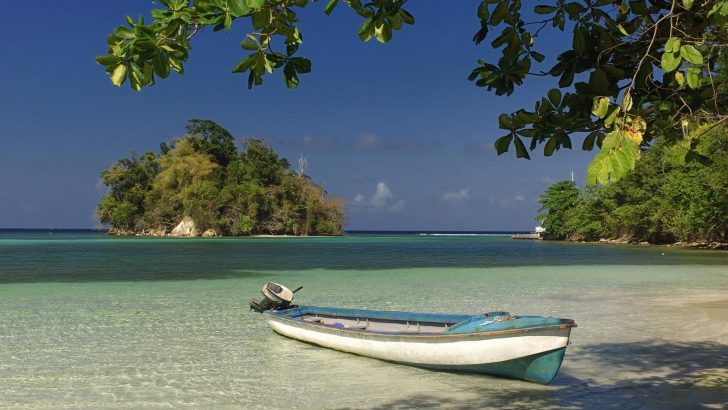
- Haiti : Safety by City
- Port-au-Prince
Haiti is a Caribbean country located on the western third of the Caribbean island of Hispaniola.
One of the dominating beauties of this country is that its north exits to the North Atlantic Ocean, while its southern parts boast the Caribbean Sea coastline.
And even though Haiti has had difficult years in the past and problematic history, its tourism industry has started improving since the 80s after its dramatic descent that occurred in the 60s.
This Caribbean country is slowly gaining the reputation of a tourist hot spot, with new resorts and luxurious facilities emerging quickly.
If you’re traveling to Haiti, you should bear in mind that this nation, although beautiful as it is, it is extremely poor.
If you’re a sucker for adventure and a revolutionary spirit with an open mind and a thirst for exploring, Haiti is perfect for you.
However, if you’re searching for a destination to visit with your family, you should probably stick to resorts and richer areas like Pétion-Ville
- Warnings & Dangers in Haiti
OVERALL RISK: HIGH
Generally speaking, Haiti is not a safe place to visit. Keep in mind that many people have reported that there are no safe places in Haiti. If you do visit, stick to maximum precaution measures.
TRANSPORT & TAXIS RISK: HIGH
Transport is definitely not safe in Haiti. Upon arriving, make sure that no one is following you, as criminals have been known to watch people arriving and then following them and attacking them. The same thing applies to people withdrawing money from banks or ATMs. Apart from this, public transport has been known to be the site of many criminal actions, stabbings, murders, robberies and kidnappings, so avoid using public transportation, including “tap-taps” by all means.
PICKPOCKETS RISK: HIGH
The poverty in Haiti is present everywhere so it is, of course, highly advised against walking around looking like you have money. The situation in Haiti is crushing so it’s no wonder that people will try and steal from you if you look like a target with money. Apply maximum precaution measures in order to minimize the chances of getting stolen from.
NATURAL DISASTERS RISK: MEDIUM
In the past, there have been numerous natural disasters hitting Haiti, such as cyclones, hurricanes, tropical storms, torrential rains, floods and earthquakes. The hurricane season is between June and November.
MUGGING RISK: HIGH
The chances of getting mugged or kidnapped are high in Haiti. By all means, avoid walking around Port au Prince alone, particularly at night, and if you do, stay away from the insanely high crime level slum areas Carrefour, Martissant, Cite Soleil, the Delmas road area, and Petionville.
TERRORISM RISK: LOW
Even though there haven't been any terrorist attacks in Haiti’s recent history, they shouldn't be ruled out. Tourists are advised to remain aware of their surroundings at all times.
SCAMS RISK: MEDIUM
As you would expect in a country ridden with crime like Haiti, people will probably try to scam you. Be wary of anyone using tactics in order to distract you. Double check your change and negotiate everything in advance. Be careful when entering any taxi vehicles and agree on the price in advance.
WOMEN TRAVELERS RISK: HIGH
Haiti is not a safe place for women to travel to. Do not go anywhere unaccompanied, and under no circumstances leave your accommodation without company after dark. Women are easier targets and there have been many reports of sexual attacks, rapes and robberies.
- So... How Safe Is Haiti Really?
The level of crime in Haiti is so seriously high that many tourists refer to it as “beyond horrific”.
There are virtually no safe areas in this country, and you shouldn’t relax anywhere in Haiti – the risk of violent crime is very real everywhere, and this refers to assaults, armed robberies, murders, kidnappings, rapes and any combination of the above.
When it comes to kidnapping, its rates remain “incredibly high” though it’s been said that it declined since 2006.
People are still being kidnapped in Haiti on a regular basis, while at work, traveling, off the streets, at home – whatever the situation, you are not safe from ending up in this situation.
Many people that ended up kidnapped had applied precaution measures, but they weren’t enough.
What’s worse, many of the kidnapped people reported being tortured or sexually assaulted before being let go.
The main motivation behind kidnapping people is money and ransom.
What you should watch out for are gangs in Haiti, as criminals usually tend to work in groups of two to four.
These are also incredibly dangerous, and they practice robberies and home invasions, seriously hurting or even killing people along the way, believing that it lessens the target’s opportunity to resist.
Be very, very careful.
Just handing over everything you have – in case of a robbery or mugging – might not be enough to get out of the situation unharmed.
These people might try to hurt you just because they can.
- How Does Haiti Compare?
- Useful Information
Most countries do not need a visa to enter Haiti. Make sure your passport is valid for at least six months past the date of your return from Haiti. If you are not sure about your visa status, visit www.doyouneedvisa.com which will let you know whether or not you need visa based on your nationality and the country you want to visit.
Haitian gourde is the official currency in Haiti. Most major cities have ATMs, but keep in mind that they often run out of money or stop working. Credit cards are usually accepted in most establishments in the capital but rarely elsewhere.
Haiti’s climate is generally tropical, characterized by hot and humid weather. Fog and drizzle brought by the north winds interrupt Haiti's dry season from November to January, and from February to May, the weather is very wet, making it a wet season.
Toussaint Louverture International Airport is the busiest airport in Haiti. It is located in Tabarre, a commune of Port-au-Prince in Haiti.
Travel Insurance
Just like anywhere else, we advise getting travel insurance when traveling to Haiti, because it would cover not only medical problems, but also theft and loss of valuables.
Haiti Weather Averages (Temperatures)
- Average High/Low Temperature
Haiti - Safety by City
Explore haiti.
- 10 Cheapest Places to Live in Haiti
- 10 Most Dangerous Cities in Haiti
- 6 Safest Cities & Beaches in Haiti
- Top 6 Airbnbs for Adventurers in Haiti
- Where to Next?
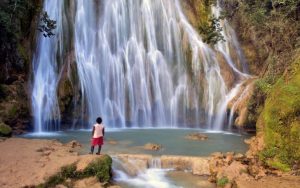
40 Reviews on Haiti
Haiti is very safe with a tour, resort or royal caribbean labadee.
Haiti is very safe if you go with a tour, a resort such as Royal Decameron or the Royal Caribbean Cruise line that stops at Labadee, Haiti. If it is your first time in Haiti, it is suggested to do one of the latter. In addition, the gorvernment of Haiti a few years ago invested in a tourism police force.
Excellent point and the truth.
I have been to haiti, and none of this is true. Haiti is a little unstable, but is a totally fine nation to visit. in haiti, they speak Haitian Creole, not French. I went to A-no, which is a very kind lovely village, but not the best town to visit. If you are looking for an amazing trip to a nation, go to haiti. Research the nation before you go. It is currently unstable now, but go to haiti this summer!
I have been to Haiti many times, it’s not as bad as they make it seems. This is negative publicity for the country. I am currently planning on going back.
I agree with you. I don’t know why media always spread lie on Haiti. What is their problem?
Haiti is wonderful. Just don't flaunt your wealth.
I agree. I’ve made over 40 trips to Haiti. I’ve never had a problem. I’ve spent a night in Cite Soleil with my rental car being fine. I purchased my house from a guy that lives in the La Saline. I’ve visited Vil de Dye. No problem. I have a house, a school, and a tiki hut on the beach in Leogane. The people of Haiti are wonderful.
Eh bien que ça vous chante ou pas d’aller en Haïti à cause de cet article cela vous concerne mais il y a plein d’endroits en Haïti qui n’ont rien moi même j’irai au Cap-Haitien la semaine prochaine qui est une ville historique et très sécurisée si bien que les touristes s’y rendent jusqu’à présent et n’ont rien senti de tel. D’ailleurs lorsque ma famille ou mes amis de l’étranger vont en Haïti ils passent par là. Il y a plein de vidéos sur le net des touristes qui se rendent au Cap-Haitien et qui se sont senti en sécurité parce qu’évidemment c’est sécurisé.
The first I like Haiti country Really I love and I will hope to travelled
Exaggeration
This report is completely dramatized and exaggerated.
It Definitely is. I travelled at night with another person, but did not have an issue. Personally I didn’t like Cap Haitien, but had a great time in Port au prince. I will be going back soon
Was the other person you travelled with Sean Penn?
Exactly! love your response.
I just came back from Haiti on March 4th and it is the truth. I said the same thing that the news was exaggerated. It does depend on where what time and when? I have been going to Haiti every year same time for over twenty years on mission trip and OMG this is the worse I have ever seen Haiti. Shame on all of those responsible. Haitian are resilient people and I am praying that they will survive.
why waste your time like this? they are only resilient due to fools wanting to “help” them
Why is it foolish to want to help people?
Good review
I totally agree with the report you have here, thanks for posting this, now I know what I have experienced in Haiti makes sense and it’s not something that just happened to me.
This just happened to you this whole thing is false I go to Haiti all the time
Applies to some not all
I’ll just say it and be the bad person. Some of these apply to ALL tourists and some of these apply to tourists who stand out. It’s a majority Black Country. Not saying crime can’t happen to Black tourists but this is extremely exaggerated for a certain group of people. I’m going to Haiti in March and can’t wait!
I’m a black Haitian who is living in the USA and who go back home once in a while.
Due to misery most of the people there are desperate, therefore if you want to visit Haiti, be careful.
The Haitian people for the majority of them are friendly, hard-working and helpful, themselves have to be careful as well in their own country because they can be victimized just like the visiting foreigners.
So Haitians are human, but as animals, when they are hungry, they can be very dangerous, so that is the case for the miserable Haitians who represent more than 80%of the population.
A country with more than 70% of unemployed people, with no income what so ever, The hospitals are inadequate, only 30% of the schools are public, most of the people are undernourished, so if such situation existed in the USA, people would not have been able to walk in the streets of the US cities.
At least in Haiti, you can walk around safely during day time.
Felix Hi : what tempted me to see Haiti detail- and safety assessment : Your Presidents assasination. I was trying to assess the possibility of visit to Haiti. I found all thru the year -weather is excellent and country is beautiful . I believe with so many interested people and beauty natural Haiti must engage more in promotion of Tourism with safety. For Eg: We have in India – Goa. Goa is one of the richest safe places to travel with nice beaches, and was a Portuguese colony till 1960. And most of its wealth is by Tourism. Haiti can lead like this for small population of 11 million ! Goa itself will 20 million ! I saw rich and poor differences hi lighted on Google – but people look to me very beautiful and nice. Hope you overcome the current situation and reach safety and success soon with firm guidance of Politics .
Keep on praying for Haiti. Hoping for a better Haiti.
I have been traveling to Haiti on mission trips every February for over twenty years. Upon returning on March 4th 2020, this is what I have to say. Accompany with my two daughters we were in different part of the country each one of us had a different experience. We found that Jacmel and St Marc was the best. Port-au-Prince (capital) the worse. The place looked worse than after the earthquake. It was fitly, scary and people looked horrible. I have no idea how these poor people are able to tolerate such horrible life. Lord please send rescue to all. People are dying of starvation. I really wish that I can do more, but unfortunately with a corrupted government it is very difficult. Haitian are resilient people and I know they will survive this. I vision a better Haiti in the future. Please don’t give up hope keep on praying. I will go back next year. Hopefully it will be better and safer.
There is no lord. How can you see this suffering and still believe such fairy tales.
You took your daughters there. YOU ARE AN IDIOT!!!! Let me take my daughters there so they can run the risk of being raped or worse.
You are wrong. You have to constantly look over your shoulder. Looking for the white car (kidnaping car) Please if you have not been a victim do not talk and give other people false information. You don’t know stay in the don’t know.
Haiti is very dangerous don’t go!!!!!!!!! kidnaping terrorist attacks never my mom says never ur all stupid!!!!!!!!
Haïti IS not dangerous evrywhere !!!
Tres Belle .
Haiti is beautiful. But staying safe should be a priority. 1..Dont flash money or valuables in the streets. 2..Stick with legit Taxi companies. 3..Avoid walking at night or into deserted areas, if possible find a trustworthy guide to show you around. 4..The police can be corrupt and if your a victim of crime ,it can be a slow process . 5..Learn some French.
So basically the same as New York
If you’re white (blanc) don’t go. You’ll be in danger. Period.
you would need you’re head examined to go to Haiti even if you’re getting paid to go, let them rot down there as they are hopeless as a nation
Is Haiti dangerous? Of course it is but do NOT call them hopeless! And let them rot? You’ve clearly never met a haitian before… because they are wonderful hard working, family oriented people who don’t deserve to live like this. The countries who’ve claimed to “help” Haiti have actually hurt them the most. Bottom line: Haiti is the first free black republic and they are STILL paying for that freedom, sadly.
-an Italian lady who won’t let you talk down about Haiti or its people
In Port – Au Prince is not the whole country. Have you heard of Mole. Look it up?
Haiti is a lawless country-Its ravaged with crime and corruption-It would take a miracle to turn things around—Foreign investment will never come if potential tourists and visiting businessmen are not safe—It’s sad stuff.
We made a small stop here while traveling to Jacmel, my wife was impressed with how colorful the city was. I was stricken by the extreme poverty. Yes, if you’re in a resort and have very little contact with the outside world you might not be very aware but the city is in shambles.
I love Haiti so muchhhhhhhh
I love Haiti. No one can describe my love for this country Haiti. I love it bad ass history and culture. It’s just the best. I will love Haiti forever🇭🇹🇭🇹Mw rinminw anpil ayiti Cherie!!!
im in love with Haitian girl and we love each other we planned to visit her country next year 2023 march .anyone has idea for this
Yess . Visit Cap Haitian
Haitian are strong, they're survivors
Haiti is no more dangerous than Jamaica, Mexico or even parts of USA eg Camden, NJ, Philadelphia, PA, Chicago or Parts of California where it’s gang infested. However, somehow because Haiti is a country of mainly black people it always gets represented in the media negatively. This propaganda has been going on for decades. The media always shows the negative side never anything good. Haiti 🇭🇹 has beautiful beaches, roaring hills, gorgeous waterfalls, an unmatched culture & history & the most hospitable people around. Now anyone with half a brain knows that No country is all good or all bad. Unfortunately Haiti is experiencing a very difficult time now due to a lot of foreign interference & corrupt government but Haitians are survivors they will not only survive but will thrive in the future.
If at first you don't succeed...
This article is so true. My first time in Haiti I was mugged, shot at, almost run over four times and my luggage stolen. The second time I went back it cost me £thousands as they kidnapped my wife and she was only released after I may several payments to the, each one increasing each time. I was also robbed and my passport stolen. The third time I went back, no kidnapping, but I was seriously beaten in a mugging and hospitalised. By the time I got out and returned to my hotel resort, all my belongings were stolen. The fourth time I went back was a bit better as it was just the taxi driver trying to scam me by attempting to take me to a secluded road and then demanding extra money from me to let me go. I paid him half of what he wanted and promised the rest at my destination, but I ran off before he could catch me. The fifth time I went back, robbed, mugged, money stolen at ATM, held at gunpoint in taxi, scammed at 2 shops with my credit card being copied. I am planning my next trip next month and this time I am really going to be cautious. These business trips are really taking it out of me.
Share Your Experience Cancel reply
Your Review
Title of your review
Article Contents
- Overall Risk
- Transport & Taxis Risk
- Pickpockets Risk
- Natural Disasters Risk
- Mugging Risk
- Terrorism Risk
- Women Travelers Risk
- Weather Averages (Temperatures)
- User Reviews
- Share Your Experience
Popular Destinations

Safety Index
Recent reviews & comments.
- Michael Shapiso on Davidson
- Kathlene Boyle on Davidson
- Dallas Low on Davidson
- Ryan Ross on Truro
- Terri Cole on Truro
Popular US States
- Pennsylvania
Cookies on GOV.UK
We use some essential cookies to make this website work.
We’d like to set additional cookies to understand how you use GOV.UK, remember your settings and improve government services.
We also use cookies set by other sites to help us deliver content from their services.
You have accepted additional cookies. You can change your cookie settings at any time.
You have rejected additional cookies. You can change your cookie settings at any time.
- Passports, travel and living abroad
- Travel abroad
- Foreign travel advice
Warnings and insurance
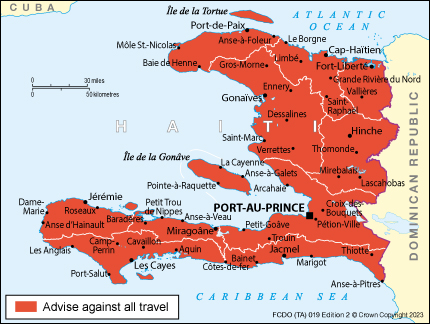
Your travel insurance could be invalidated if you travel against advice from the Foreign, Commonwealth & Development Office (FCDO). Consular support is also severely limited where FCDO advises against travel.
FCDO advises against all travel to Haiti
FCDO advises against all travel to Haiti due to the volatile security situation. There are currently no British consular officials in Haiti and our ability to provide consular assistance is severely limited and cannot be delivered in person in Haiti.
British nationals may get consular services assistance at our diplomatic mission in the Dominican Republic .
If you choose to travel to or stay in Haiti against FCDO advice, try to avoid all crowds and public events, and take appropriate security precautions.
State of emergency
The Government has adopted a state of emergency in parts of Port-au-Prince. This will last until 19 August. The state of emergency grants security forces powers to create and enforce curfews and to ban circulation in these areas in support of their activities. You should monitor local news sources for information.
Hurricane season
The hurricane season runs from June to November. You should follow and monitor local and international weather updates from the US National Hurricane Center and follow the advice of local authorities, including any evacuation orders. See Extreme weather and natural disasters .
Travel insurance
If you choose to travel, research your destinations and get appropriate travel insurance . Insurance should cover your itinerary, planned activities and expenses in an emergency.
About FCDO travel advice
FCDO provides advice about risks of travel to help British nationals make informed decisions. Find out more about FCDO travel advice .
Related content
Is this page useful.
- Yes this page is useful
- No this page is not useful
Help us improve GOV.UK
Don’t include personal or financial information like your National Insurance number or credit card details.
To help us improve GOV.UK, we’d like to know more about your visit today. Please fill in this survey (opens in a new tab) .

- Things to Do
Destinations
× select language.

Welcome to Haiti
A land with a soul
Île-à-Rat (Amiga Island) near Cap-Haïtien Photo: Ryan Bowen
Explore Haiti
Imagine having that one friend who knows every nook and cranny of their hometown—that’s us for Haiti. Our city guides are crafted by local experts who share all the hidden spots you won’t find on other travel guides.
- Cap-Haïtien
Since celebrating its 350th anniversary in 2020, Cap-Haïtien has become Haiti’s top travel destination. As Haiti’s second-largest city, it draws visitors with its rich history, world-class beaches, and UNESCO heritage sites. Join us as we take a swooping dive into the heart of the city and learn how it earned its well-deserved title as Haiti’s second city.
Whether you’re looking for adventure, nature, fast festival rhythms, rejuvenation on sandy beaches, or a cultural experience bringing you closer to the myths and folklore of the people of Haiti, Jacmel will slake your thirst and sate your curiosity.
A horseshoe-shaped bay set into the northern coastline, Labadee is the beach of choice for the cruise ships that regularly call at Haiti.
The beach stretches over a mile of soft, silky sand, and crystal-clear blue waters. Labadee Beach is on the same coast as the beautiful Cormier beach, but offers a unique array of attractions catering to visitors who arrive on the cruise ships.
- Port-au-Prince
Just a two-hour flight from Miami, Port-au-Prince will probably be your first stop in Haiti, and the best way to find the pulse of a country is to take a few steps in its capital city. About 1 million people live in the metropolitan area, with another 1.5 million living on the surrounding hills and coastline. Although some areas are troubled (as with any populous city), Port-au-Prince has several upmarket districts where visitors can safely stay and explore on their own.
At the end of a 180-mile journey west along Haiti’s southern peninsula, Jérémie is a busy coastal town with mountains cascading at its back. Known as the City of Poets due to the many renowned Haitian authors who hail from here, Jérémie boasts a rich literary heritage.
This city, full of history and character, is also the birthplace of General Thomas-Alexandre Dumas, the father of the celebrated Alexandre Dumas. You’ll want to dedicate a couple of days to fully explore this culturally significant destination.
The far south of Haiti (west of Jacmel and Les Cayes) isn’t as visited by travelers as the rest of the country, but it is just as worthy of being a destination. The pretty little city of Pestel is one of our favorites. From its rustic seaside markets to unique, unexpected places to explore like nearby caves and islands, Pestel is a place not to be missed if you’re touring Haiti’s southeast.

Nine of the Most Beautiful Destinations in Haiti
Sun-kissed and sandy-toed, we’ve toured Haiti to bring you our pick of the most beautiful places on the island. From Cap-Haïtien’s culture-rich streets to Port-a-Piment’s hidden caves, these are the Haitian destinations to escape to this season.
Plan your Trip
Ready to experience Haiti? We’ve got you covered with everything you need for a smooth journey. Make your trip planning easy with our advice and insider tips on what to pack, staying safe, the best times to travel, and much more.
What to pack
How to pay less, when to travel, getting around.
- How to Stay Safe
Fun Facts About Haiti
- Entry to Haiti
The mystical side of Haiti
Haiti’s mystical side unveils a fascinating world of spirituality and tradition. Often misunderstood, Haitian Vodou is more about bringing peace and balance to the world than the dark myths surrounding it. Curious about the real nature of Vodou? Dive into some of our favorite stories from the mystical side of Haitian culture, revealing a different truth than what you might expect.

Get to Know the Deities of Haitian Vodou

A Visual Guide to Vèvè: Vodou Symbols & Cosmograms

How to Attend a Vodou Ceremony in Haiti
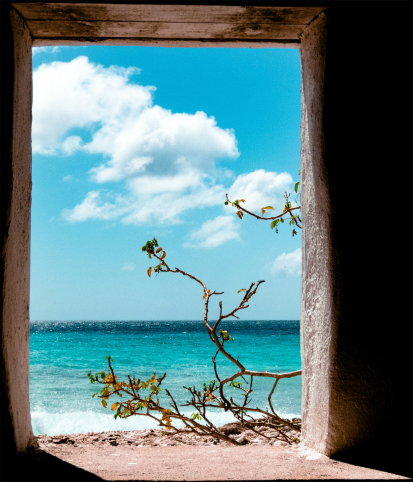
Why travel to Haiti?
Haiti was the first independent black republic in the world and achieved this by defeating Napoleon. It is surrounded by the Caribbean Sea and is known for beautiful beaches and fantastic surfing, it also boasts steep and stunning mountain regions…
Discover Our Latest Stories
Stay in the loop with Haiti’s latest and greatest. Our newest articles bring you fresh insights and captivating tales from around the island. Whether it’s exploring hidden spots or sharing the latest cultural happenings, we hope our stories keep you connected and inspired.

The True Story of Haitian Zombies (Insights from an Insider)
Discover how the unique Haitian zombie mythology, was shaped by deep-rooted beliefs and the trauma of slavery. Click to learn more!
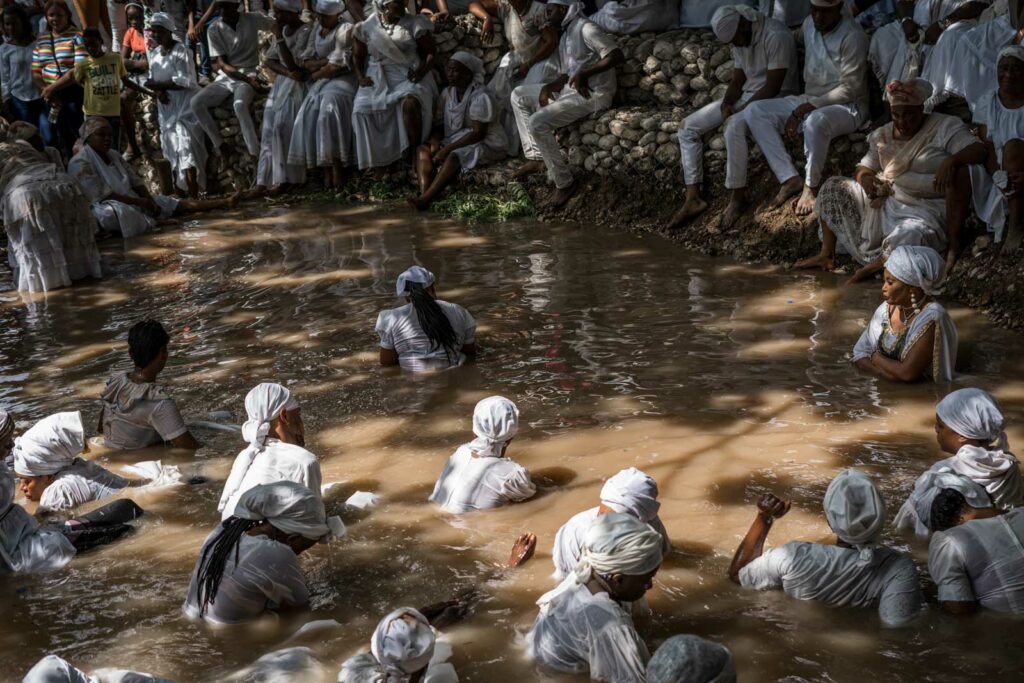
Rhythms and Rituals at Lakou Soukri’s Vodou Festival
Dive into the heart of Haiti with a journey to Lakou Soukri’s annual Vodou Festival, where tradition, spirituality, and community come to life.

How to Spend a Day at Île-à-Rat (Amiga Island)
Step into the hidden splendor of Île à Rat aka Amiga Island, Haiti’s answer to Caribbean paradise, perfect if you’re seeking (almost) undiscovered beauty.
Meet the Locals
“What’s it like in the life of a local?” If you’ve ever wondered, we have the answers! Our series, Meet the Locals, takes you through the lives of people all over Haiti, and gives you a more intimate look at life on the island.

Paradise for your inbox
Your monthly ticket to Haiti awaits! Get first-hand travel tips, the latest news, and inspiring stories delivered straight to your inbox—no spam, just paradise.
Frequently Asked Questions about Haiti
When’s the cheapest time to fly? Do I need a visa? How much should I tip? This is where we answer your most frequently asked questions.
Where are the best places to stay in Haiti?
Is the water in haiti safe to drink.
Lorem ipsum dolor sit amet, consectetur adipiscing elit, sed do eiusmod tempor incididunt ut labore et dolore magna aliqua. Ut enim ad minim veniam, quis nostrud exercitation ullamco laboris nisi ut aliquip ex ea commodo consequat. Duis aute irure dolor in reprehenderit in voluptate velit esse cillum dolore eu fugiat nulla pariatur. Excepteur sint occaecat cupidatat non proident, sunt in culpa qui officia deserunt mollit anim id est laborum.
Is it safe to travel in Haiti?
Sed ut perspiciatis unde omnis iste natus error sit voluptatem accusantium doloremque laudantium, totam rem aperiam, eaque ipsa quae ab illo inventore veritatis et quasi architecto beatae vitae dicta sunt explicabo. Nemo enim ipsam voluptatem quia voluptas sit aspernatur aut odit aut fugit, sed quia consequuntur magni dolores eos qui ratione voluptatem sequi nesciunt.
Disclaimer: "We independently review everything we recommend. If you buy something from a link on Visit Haiti, we may earn a commission."
Visit Haiti is part of the Mawozo Media Network
Plan Your Trip
- Flights & Getting Here
- When to Travel
- What to Pack
- How to Pay Less
Information
- Terms of Use
- Privacy & Cookies
- Shipping & Return Policy
- Advertising
Copyright © 2024 Visit Haiti. All rights reserved.
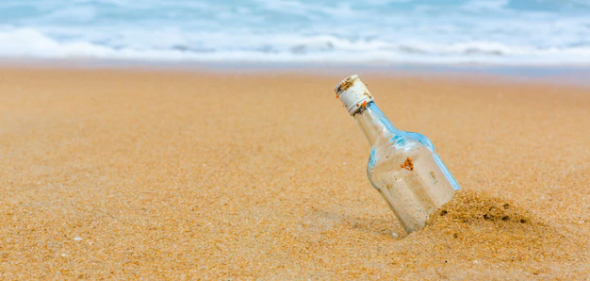
Get travel inspiration, news, tips and more delivered monthly. We’ll never share your email address or send junk.
We’re sorry, this site is currently experiencing technical difficulties. Please try again in a few moments. Exception: request blocked
Security Alert May 17, 2024
Worldwide caution.
- Travel Advisories |
- Contact Us |
- MyTravelGov |
Find U.S. Embassies & Consulates
Travel.state.gov, congressional liaison, special issuance agency, u.s. passports, international travel, intercountry adoption, international parental child abduction, records and authentications, popular links, travel advisories, mytravelgov, stay connected, legal resources, legal information, info for u.s. law enforcement, replace or certify documents.
Share this page:
Learn about your destination
Take 90 seconds for safer travel.
Travel Advisory Levels
Enroll in step.

Subscribe to get up-to-date safety and security information and help us reach you in an emergency abroad.
Recommended Web Browsers: Microsoft Edge or Google Chrome.
External Link
You are about to leave travel.state.gov for an external website that is not maintained by the U.S. Department of State.
Links to external websites are provided as a convenience and should not be construed as an endorsement by the U.S. Department of State of the views or products contained therein. If you wish to remain on travel.state.gov, click the "cancel" message.
You are about to visit:
Sign up for The Haitian Times Daily News Roundp
Keep tabs on the latest news out of Haiti and the diaspora delivered straight to your inbox.

The Haitian Times
Bridging the gap
US Department of State issues “do not travel” security alert for Haiti
The U.S. Department of State continues to issue high risk security alerts on Haiti as Haitian Prime Minister Garry Conille had to flee gunfire from gangs during a visit to the State University of Haiti Hospital (HUEH) on Monday, and a Kenyan police officer was injured in fight with armed gangs the following day.
PORT-AU-PRINCE — The U.S. Department of State issued a security alert update on Haiti on Wednesday, stating that the country “remains under a Level 4 – Do Not Travel – Travel Advisory” due to high risk and potential outbreaks of gang-led violence. The U.S. government advises American citizens against traveling to Haiti. Those already in the country are recommended to leave, but U.S. authorities specify that they cannot guarantee safety for any travelers.
“The Embassy reminds all citizens that Haiti, including Port-au-Prince, remains under a Level 4 —Do Not Travel—Travel Advisory,” read a note posted on the U.S. Embassy site on July 31 .
The State Department also posted the same security alert update on Haiti on X . It continued, “The security situation in Haiti is unpredictable and dangerous. Travel within Haiti is conducted at your own risk. The U.S. government cannot guarantee your safety traveling to airports, borders, or during any onward travel. You should consider your personal security situation before traveling anywhere in Haiti. “
The authorities recommend several precautions for American citizens in Haiti, such as avoiding crowds, following local media for updates, staying away from areas where violence, protests, or disturbances are reported, keeping a low profile, being prepared to shelter in place for extended periods, avoiding being outside after dark and ensuring travel documents are up-to-date and easily accessible.
Port-au-Prince remains the primary area of concern in this alert. The State Department advises Americans to exercise particular caution while traveling in areas like Pierre 6 and Carrefour Drouillard, around Toussaint Louverture International Airport, and the ports of Port-au-Prince.
The U.S. Embassy in Port-au-Prince said it would continue monitoring gang violence hotspots in the capital and surrounding areas. It warned that gunfire could occur in any part of Haiti, posing risks of being hit by stray bullets.
“The security situation in Haiti is unpredictable and dangerous. Travel within Haiti is conducted at your own risk.” U.S. Department of State
This advisory comes as violence in Haiti intensifies, particularly in Port-au-Prince, where armed gangs control over 80% of the city. Recent gang incidents have raised questions about when security will be restored in the country.
On July 29, Haitian Prime Minister Garry Conille had to flee the facility of the State University of Haiti Hospital (HUEH), which he visited, under gunfire from armed gangs. The following day, the Multinational Security and Support (MSS) mission reported its first casualty. A Kenyan police officer was injured in the shoulder during a gunfight with gang members who were looting a rice shipment near a Port-au-Prince port.
Despite a decrease in the number of murders, gunshot injuries and kidnappings in the second quarter of 2024, the situation remains concerning. Recent incidents underscore the dangerous environment in Port-au-Prince.
The United Nations Integrated Office in Haiti (BINUH) indicated in a recent report that in the second quarter of 2024, gang violence resulted in 1,397 people being killed or injured and 428 kidnappings. This represents a decrease from the first quarter’s 2,505 casualties, showing a 45% reduction in murders and shootings and a 2% decrease in kidnappings.
Meanwhile, the chairman of the Transitional Presidential Council (CPT), Edgard Gardy Leblanc Fils, participating in the 47th regular meeting of the Caribbean Community (CARICOM) Heads of State and Government Conference, said on July 29 that the security situation in Haiti has improved thanks to the actions of the country’s security forces, supported by the Kenyan police-led MSS.
“Thanks to their help, the State has regained control of the country’s largest hospital and its surroundings,” Leblanc said. “In the north and south, about 80,000 9th-grade students successfully completed their official exams last week,” he added.
During his remarks, Leblanc expressed confidence in Haiti’s future, asserting that the hardships and suffering endured by the Haitian people will not diminish their resilience.
Despite all, gangs continue to attack police infrastructure, notably in the communes of Gressier , Carrefour, and Ganthier , where they have demolished police stations and terrorized the civilian population. Additionally, areas around the country’s largest hospital remain inaccessible and under threat from gangs. National roads are under gang control, and there have been no significant police operations in these areas despite the presence of 400 Kenyan police officers in Haiti.
However, Leblanc told CARICOM: “I assure you that my country will overcome the challenges and obstacles hindering its effective integration into the Caribbean Community.”
Juhakenson Blaise
I am Juhakenson Blaise, a journalist based in the city of Port-au-Prince, Haiti. I cover the news that develops in this city and deals with other subjects related to the experience of Haitians for the Haitian Times newspaper. I am also a lover of poetry.
Join the Conversation
What does it take for the US gov to realize that Haiti has gone beyong gang related issues . Those clans are terrorizing and had actually put an entire city to its knees .
Leave a Reply Cancel reply
Leave a comment.
We've recently sent you an authentication link. Please, check your inbox!
Sign in with a password below, or sign in using your email .
Get a code sent to your email to sign in, or sign in using a password .
Enter the code you received via email to sign in, or sign in using a password .
Subscribe to our newsletters:
- Haitian Times Newsletter and Daily Roundups
- Haitian Excellence
Sign in with your email
Lost your password?
Try a different email
Send another code
Sign in with a password
You are using an outdated browser. Upgrade your browser today or install Google Chrome Frame to better experience this site.
- Section 10 - Guatemala & Belize
- Section 10 - Iguacu Falls
CDC Yellow Book 2024
Author(s): Stanley Juin, Macarthur Charles, Timbila Koama, Chung (Ken) Chen
Destination Overview
Infectious disease risks, environmental hazards & risks, safety & security, availability & quality of medical care.
The Republic of Haiti is a country located on the island of Hispaniola in the Greater Antilles archipelago of the Caribbean Sea (see Map 10-08 ). The shared border between Haiti and the Dominican Republic is porous; migrant workers move readily between the 2 countries, and cultural influences are shared. North America and France have large Haitian diaspora communities. Travelers visiting friends and relatives (VFR) make up a large proportion of visitors to Haiti each year. Other reasons people come to Haiti include foreign diplomacy, international business, missionary and humanitarian aid work, and tourism.
Port-au-Prince, Haiti’s capital, is often the main entry point for international arrivals. Haiti has many tourist destinations, including a popular cruise ship destination in Labadie (Port Labadee), which has white sand beaches and scenery that attract visitors year-round. Historical architecture sites (e.g., Cathédrale Notre-Dame in the city of Cap-Haïtien; Citadelle Laferrière, reputedly the largest fortress in the Americas and a UNESCO World Heritage Site, located on top of mountain Bonnet à l’Evèque) are popular tourist destinations. The annual Haitian Carnival, which takes place in February or March, draws crowds from around the world. Haiti has strong economic and social ties with international organizations; as such, business travelers, foreign diplomats, humanitarian aid workers, and missionaries often visit Haiti.
Travelers can find various types of accommodations in Haiti, ranging from dormitory-style to bed-and-breakfast inns to house rentals and upscale hotels in major cities. Most accommodations include internet, but signal and reliability are often poor due to interruptions of services within the country.
Map 10-08 Haiti
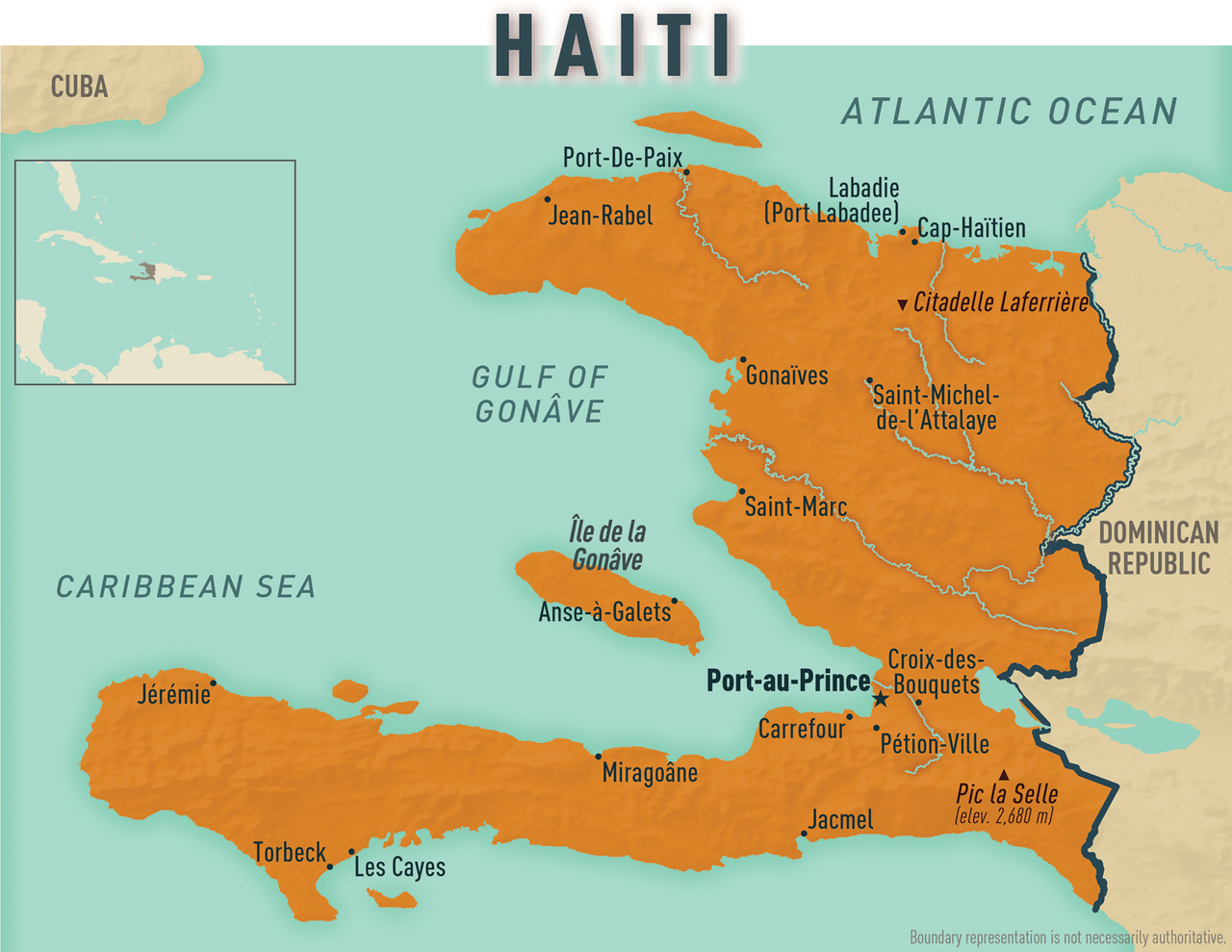
View Larger Figure
Environmental degradation has contributed to Haiti’s poor sanitation and water quality. As a result, multiple public health risks exist for Haitians and for travelers to Haiti. Anyone traveling to Haiti should be up to date on routine vaccinations, including diphtheria (cases have increased in recent years) and tetanus boosters, seasonal influenza, and measles. Although measles has been eliminated in Haiti, the risk for reintroduction is ever-present.
Enteric Infections & Diseases
As of February 2021, the cholera outbreak that started after the 2010 earthquake had caused 820,555 suspected cases of illness and 9,792 deaths. The epidemic curve peaked in 2011, with declining incidence and mortality rates annually due to improved access to clean water and sanitation and the efforts of cholera treatment centers. In 2019, 9 years after the outbreak started, Haiti reported 720 suspected cholera cases and only 3 deaths. In October 2022, after 3 years of no reports of culture-confirmed cholera, Haiti’s National Public Health Laboratory identified new cases of culture-confirmed disease and was investigating additional suspect cases.
Despite declining cases, cholera remains a persistent public health threat in Haiti. Oral cholera vaccine has been implemented as part of a complementary set of ongoing control measures that include improved diarrheal disease surveillance and enhanced laboratory capacity. Travelers should adhere to food and water precautions, and—depending on their planned itinerary—consider cholera vaccine (see Sec. 5, Part 1, Ch. 5, Cholera ). For current recommendations, see the Centers for Disease Control and Prevention (CDC) Travelers’ Health destination page for Haiti .
Travelers’ Diarrhea
Visitors to Haiti are at high risk for travelers’ diarrhea (TD). Travelers who want to experience the local flavorful cuisine (e.g., griot [seasoned fried pork], plantains, rice with red beans, and a variety of fish and shellfish, including conch), should select food and beverages with care (see Sec. 2, Ch. 6, Travelers’ Diarrhea , and Sec. 2, Ch. 8, Food & Water Precautions ).
Typhoid Fever
Without prompt treatment, Salmonella enterica serotype Typhi infection can cause serious morbidity and mortality (Sec. 5, Part 1, Ch. 24, Typhoid & Paratyphoid Fever ). On average, Haiti’s Ministry of Health reports 1,200 suspected cases weekly throughout the country. Although the true extent of typhoid infection in Haiti is not fully known, cases are reported regularly in all 10 departments. Due to major public health infrastructure investments (sanitation, access to safe drinking water) made in response to the cholera outbreak, the number of typhoid fever cases has been decreasing, but disease transmission remains active. Urge all travelers to adhere to strict food and water precautions, and—depending on their planned itinerary—to consider receiving typhoid fever vaccine.
Respiratory Infections & Diseases
Coronavirus disease 2019.
All travelers going to Haiti should be up to date with their COVID-19 vaccines .
Tuberculosis
Tuberculosis (TB) is more prevalent in Haiti than in neighboring countries. Using appropriate and effective strategies, the Programme National de Lutte contre la Tuberculose (PNLT) has been able to improve case detection and treatment throughout the country. Short-term travelers are not at high risk of tuberculosis unless they are residing or spending extended time in specific crowded environments (e.g., shared room hostels, prisons).
Sexually Transmitted Infections & HIV
Support from the international community over the past 20 years has helped stabilize the prevalence of HIV in Haiti; the estimated prevalence is 2% among adults aged >15 years. Among people 15–24 years age of age, infection is disproportionately greater among women than men (2.3% vs. 1.6%). As of December 2020, 85% of people living with HIV were aware of their diagnosis, 83% of those diagnosed were receiving antiretroviral therapy, and 72% have an undetectable viral load. Preexposure prophylaxis is available at all regional hospitals throughout the country and at several high-volume health centers. Condoms can be easily purchased at local pharmacies and grocery stores, although quality cannot be guaranteed.
Soil- & Waterborne Infections
Although the prevalence of helminthiasis is diminishing in Haiti, intestinal parasites represent a potential concern for travelers, emphasizing the need for strict adherence to food and water precautions (see Sec. 5, Part 3, Ch. 13, Soil-Transmitted Helminths ).
Vectorborne Diseases
Vectorborne diseases, both viral and parasitic, are common in Haiti and include dengue and Plasmodium falciparum malaria. Travelers to Haiti should take measures to protect themselves from mosquito bites (see Sec. 4, Ch. 6, Mosquitoes, Ticks & Other Arthropods ).
Arboviruses: Chikungunya, Dengue & Zika
In 2021, ongoing dengue surveillance in Haiti confirmed 18 cases out of >5,000 specimens tested through October of that year. Seroprevalence studies conducted in 2017 found ≈72% of Haitians had been exposed to dengue, confirming the results of a previous study conducted in 2012. Advise longer-term travelers to Haiti to select accommodations with air conditioning or well-screened windows and doors; to wear clothes that cover the arms and legs; and to use insect repellent. No confirmed cases of chikungunya or Zika have been documented in Haiti since June 2014.
Lymphatic Filariasis
Haiti actively participates in the global program to eliminate lymphatic filariasis (LF). LF is considered endemic to Hispaniola, including many parts of Haiti. As of 2020, several areas of the country, including Port-au-Prince, still require annual mass treatment campaigns aimed at reducing parasite transmission . Prevention involves adherence to insect bite precautions (see Sec. 5, Part 3, Ch. 9, Lymphatic Filariasis ).
Chloroquine-sensitive P. falciparum malaria is endemic to Haiti (see Sec. 2, Ch. 5, Yellow Fever Vaccine and Malaria Prevention Information, by Country ). The incidence of malaria has been decreasing since 2016; current incidence is ≈70 cases per 100,000 people, annually. The highest transmission rates are reported to occur after the rainy seasons, March–May and October–November. Malaria is a localized infection in Haiti and is reported primarily from the Southern region. Nevertheless, CDC recommends that all travelers to Haiti, regardless of itinerary, take malaria chemoprophylaxis (see Sec. 5, Part 3, Ch. 16, Malaria ).
Animal Bites & Rabies
Haiti is more affected by rabies than any other nation in the Americas. Prevention efforts in the country have increased, but with a high number of stray dogs, the number of cases of human rabies is not yet clearly defined. Preexposure rabies vaccination is recommended for travelers anticipating contact with animals. Travelers with high-risk exposures for rabies generally require medical evacuation to the United States to receive definitive care and management, including appropriate postexposure prophylaxis (see Sec 5, Part 2, Ch. 18, Rabies ).
Ciguatera Fish Poisoning
Ciguatera fish poisoning commonly occurs in Haiti. Outbreaks can happen seasonally or sporadically, particularly after storms. Not all fish of a given species or from a given area will necessarily be toxic. Travelers to Haiti should avoid eating reef fish weighing >2.7 kg (6 lbs) or the filets of large fish (see Sec. 4, Ch. 10, Food Poisoning from Marine Toxins ).
Climate & Sun Exposure
With some variation depending on elevation, the climate in Haiti is tropical and hot, and remains so throughout the year. Haiti has an average monthly temperature range of 77°F–84°F. Humidity is often high, and microclimates exist depending on the geographic location. Travelers should minimize sun exposure and use a broad-spectrum sunscreen (see Sec. 4, Ch. 1, Sun Exposure ). Sunscreen products are not always available in local markets, however, and travelers should pack enough to last them for the duration of their travel.
Natural Disasters
Natural disasters are common in Haiti, including earthquakes, floods, hurricanes, and tropical storms. Hurricane season lasts from June–November. In 2008, Haiti experienced a series of 4 hurricanes and tropical storms within 2 months. Hurricane Matthew, the first Category 4 hurricane to hit the island since 1964, struck Haiti in October 2016; 546 people died and >120,000 were displaced. Strong winds and heavy rain caused flash floods, mudslides, river floods, crop and vegetation loss, and destruction of homes and businesses. One year later, rain and flooding from Hurricane Irma compounded the losses to Haiti’s agricultural sector. These combined disasters further weakened an already fragile infrastructure.
In January 2010, Haiti experienced a 7.0 magnitude earthquake that killed >220,000 people and displaced 1.5 million people from their homes. More recently, on August 14, 2021, a magnitude 7.2 earthquake struck southwest Haiti, about 70 miles west of the capital of Port-au-Prince, killing ≈2,200 people and injuring >12,000. In addition, 28 of the 66 health facilities in the region were severely damaged or destroyed. Two days later, tropical storm Grace made landfall causing flooding and complicating relief efforts. Together, these emergencies have strained Haiti’s health care system immensely.
The crime rate in Haiti is high, particularly in Port-au-Prince, presenting persistent safety concerns for travelers. Although much of the violent crime is perpetrated by Haitians against Haitians, American citizens also have been victims (see Sec. 4, Ch. 11, Safety & Security Overseas ). Travelers arriving on flights from the United States have been targeted for robbery and attack.
During Carnival, crime, disorderly conduct, and general congestion increase. Advise travelers to maintain awareness of their surroundings, avoid nighttime travel, keep valuables well hidden (not left in parked vehicles), and to lock all doors and windows.
Political Unrest
Political and civil unrest represents a safety concern for visitors to Haiti. Frequent and sometimes spontaneous protests occur in Port-au-Prince. Demonstrations—which travelers should avoid, when possible—can turn violent. The US Department of State’s Smart Traveler Enrollment Program (STEP) electronically pushes information to travelers about safety conditions at their destination and provides direct embassy contact in case of man-made emergencies (political unrest and demonstrations, rioting, terrorist activity) or natural disasters.
Traffic-Related Injuries
Motor vehicle injuries are the most common cause of death for healthy US residents traveling abroad (see Sec. 8, Ch. 5, Road & Traffic Safety ). The risk for death from road injuries in Haiti is high; the 2019 average rate was 18.77 per 100,000 population, compared with an average rate of 15.33 for the Americas region. Road conditions in Haiti differ greatly from those in the United States; roads and lanes are generally unmarked, speed limits are seldom posted or adhered to, rights of way are not observed, and animals, carts, and vendors all share the roads with motor vehicles. Some roads are unpaved or have large potholes. Lack of streetlights significantly compounds the risk of being on roads at night.
Traffic is usually chaotic and congested in urban areas. Vibrantly painted tap taps are open-air vehicles (buses or pick-up trucks), mechanically unsound, and often overloaded with passengers. Although tap taps are a common form of public transportation for Haitians, advise travelers to avoid using them because of safety concerns (crashes, kidnappings, robberies). Remind travelers to remain alert when walking, to choose safe vehicles, and to observe safety practices when operating vehicles. Travelers should fasten seat belts when riding in cars, and wear a helmet when riding bicycles or motorbikes.
According to the World Health Organization, delivery of primary health care services was already challenged in Haiti before the 2021 earthquake. Since then, the health care situation has become even more complicated; many facilities, primarily in the south, are unable to function because of physical damage, and medical facilities can close without notice due to social unrest.
The Haitian health care system faces multiples shortages (e.g., limited availability of essential medicines and supplies, lack of trained health professionals) and is costly. Over 40% of the population report not having used the public health care system, even in cases of serious injury or illness, principally due to the cost. Thus, access to health care, especially for medical emergencies remains a challenge in Haiti, and medical evacuation often is necessary for patients who require immediate attention. Consequently, people planning travel to Haiti should purchase travel health insurance and medical evacuation insurance (see Sec. 6, Ch. 1, Travel Insurance, Travel Health Insurance & Medical Evacuation Insurance ) and bring a travel first aid kit (see Sec. 2, Ch. 10, Travel Health Kits ).
The following authors contributed to the previous version of this chapter: Clive M. Brown, Lacreisha Ejike-King, J. Nadine Gracia, Dana M. Sampson
Bibliography
Institute for Health Metrics and Evaluation. Haiti. Available from: www.healthdata.org/haiti .
Institut Haïtien de l’Enfance (IHE) and ICF. Haiti mortality, morbidity and service utilization survey (EMMUS-VI) 2016–2017 [in French]. Pétion-Ville, (Haiti) and Rockville (MD): Institut Haïtien de l’Enfance and ICF; 2018. Available from: www.dhsprogram.com/pubs/pdf/FR326/FR326.pdf .
International Association for Medical Assistance to Travellers. Ciguatera fish poisoning. Available from: www.iamat.org/risks/ciguatera-fish-poisoning. Ministère de la Santé Publique et de la Population (MSPP). Sitrep COVID-19 08-07-21 [in French]. Available from: www.mspp.gouv.ht/page-covid-19 .
National Oceanic and Atmospheric Administration. National Hurricane Center tropical cyclone report: Hurricane Matthew (AL142016). Miami: The Center; 2017. Available from: www.nhc.noaa.gov/data/tcr/AL142016_Matthew.pdf .
United Nations Development Programme (UNDP) Human Development Report Office. Human development report 2013. The rise of the South: human progress in a diverse world. New York: The Programme; 2013. Available from: http://hdr.undp.org/sites/default/files/reports/14/hdr2013_en_complete.pdf .
US Department of State. Haiti 2017 crime and safety report. Washington, DC: Bureau of Diplomatic Security, Overseas Security Advisory Council; 2017. Available from: www.osac.gov/Content/Report/fcbed0b9-1eda-45a8-b6f4-15f4ae15ebaa .
Weppelmann TA, Burne A, von Fricken ME, Elbadry MA, Beau De Rochars M, Boncy J, et al. A tale of two flaviviruses: a seroepidemiological study of dengue virus and West Nile virus transmission in the Ouest and Sud-Est Departments of Haiti. Am J Trop Med Hyg. 2017;96(1):135–40.
World Food Programme. Haiti. Available from: www.wfp.org/countries/haiti .
World Health Organization. Haiti. Available from: www.who.int/countries/hti/en .
File Formats Help:
- Adobe PDF file
- Microsoft PowerPoint file
- Microsoft Word file
- Microsoft Excel file
- Audio/Video file
- Apple Quicktime file
- RealPlayer file
- Zip Archive file
Things to do in Haiti in a 1-week itinerary
By Joan Torres Leave a comment Last updated on April 25, 2024
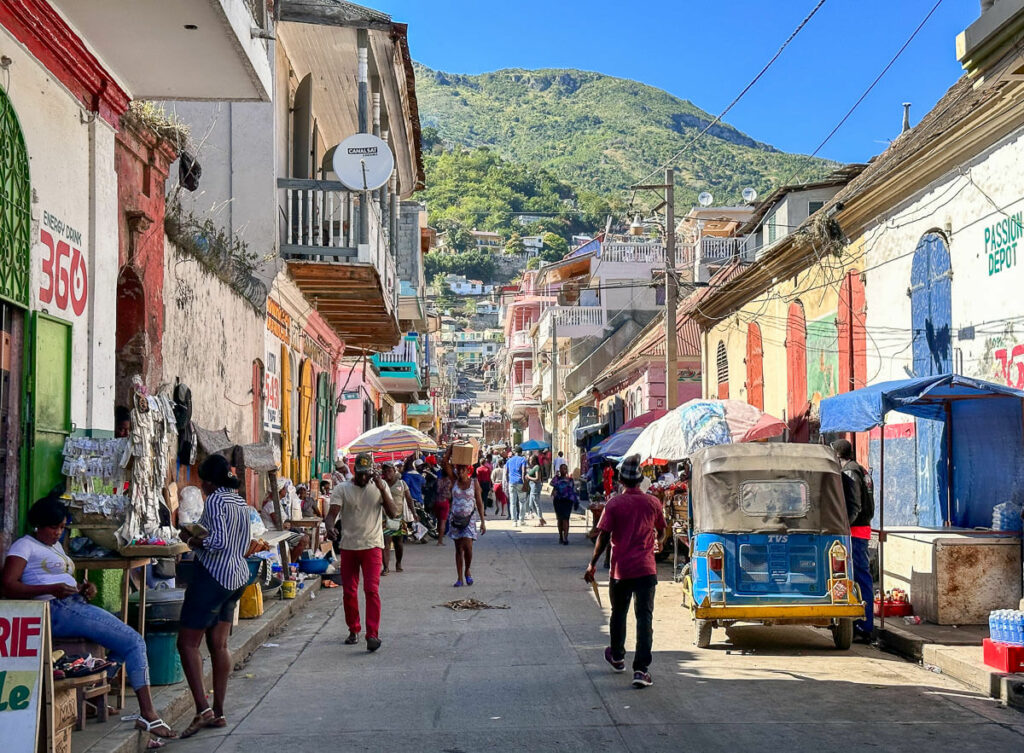
Dreamy landscapes and beaches, world-class architectural delights and the most authentic West African culture in the heart of the Caribbean.
Few travelers know about any of the places to visit in Haiti, yet this is truly the most unique destination in the Americas, packed with exciting sites offering thrilling backpacking adventures.
After spending 10 traveling around the country, here’s a comprehensive 7-day , safe itinerary containing the best things to see and do in Haiti.
For all practical information including visas, safety, local culture, etc., check our travel guide to Haiti .
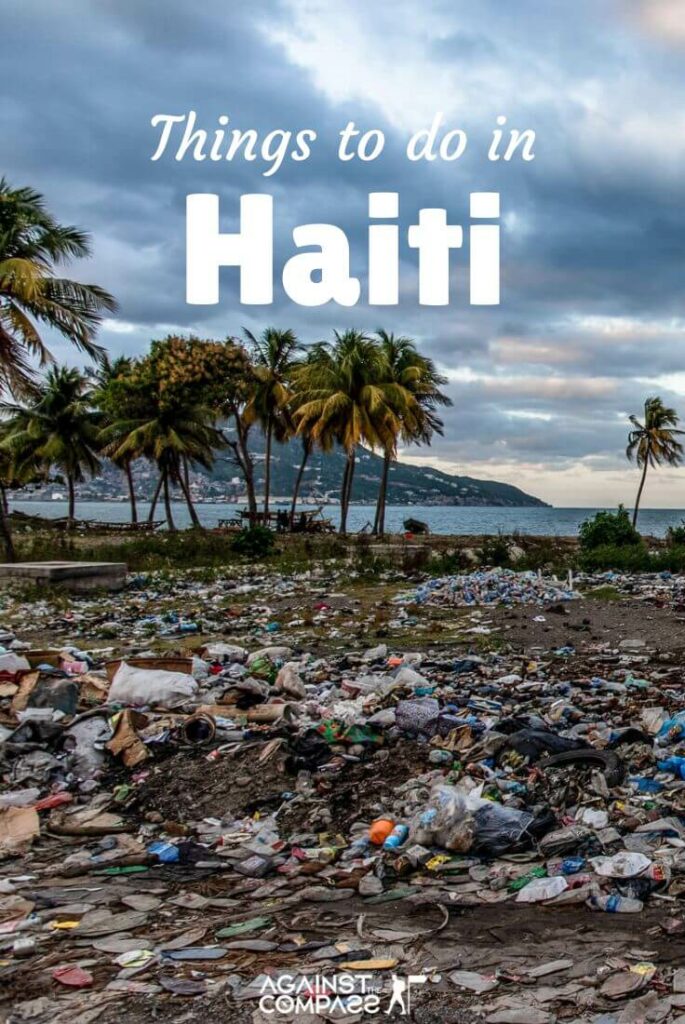
In this Haiti itinerary, you will find:
Table of Contents
- Accommodation
- Day 1 – Traveling from Santo Domingo to Cap-Haïtien
- Day 2 – Exploring Cap-Haïtien
- Day 3 – Day trip to Citadelle la Ferrière
- Day 4 – Hiking to Labadee
- Day 5 – Travel from Cap-Haïtien to Port au Prince
- Day 6 – Port-au-Prince
- Day 7 – Mirelabais and Dominican Republic
- More Information
our recommended travel insurance for Haiti
IATI Insurance is one of the very few that covers travel in Haiti.
🏨 Accommodation: where to stay at the places you visit in Haiti
Where to stay in santo domingo.
Near the station for buses to Haiti: Torres Apart Studio
Although this place is nothing special, it’s relatively well-priced and ideally located next to the bus terminal for buses going to Haiti.
In the Zona Colonial, near tourist sites: La Puerta Roja Guest House
Cheap, and very well located. This beautiful guest house is an excellent place to stay.
Where to stay in Cap-Haïtien: Habitation des Lauriers
This is the best place to stay in Cap-Haïtien. The rooms are basic and a bit expensive, but that’s what you always get in Haiti, and this accommodation offers the added benefit of having staff who speak English. You can also pay by card and exchange money.
The views are amazing too, overlooking Cap-Haïtien.
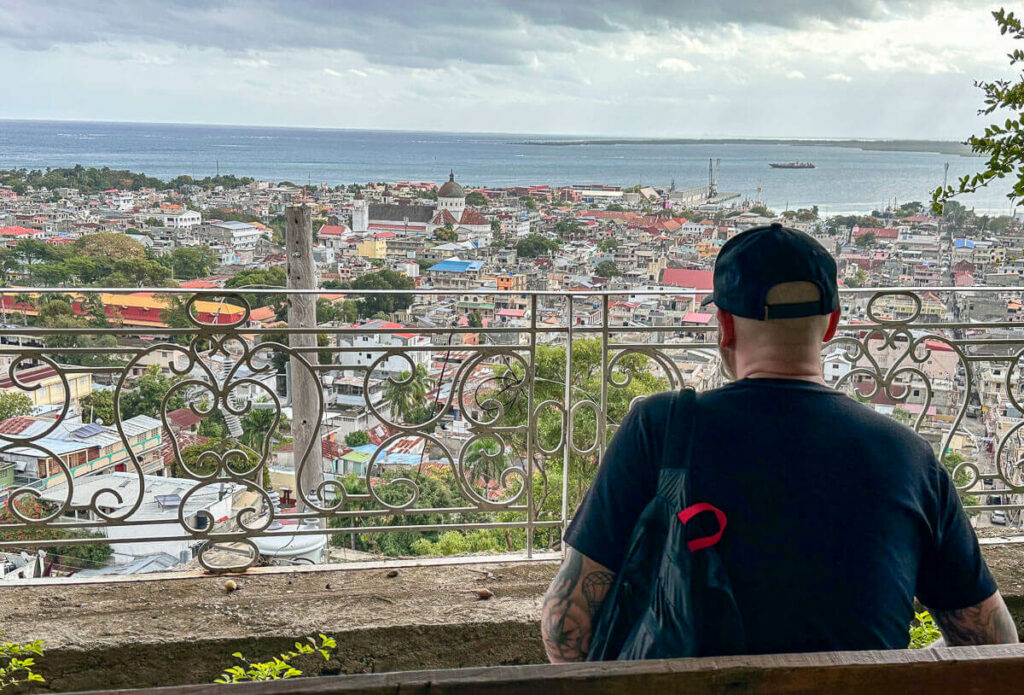

Where to stay in Port-au-Prince: Allamanda Hotel
Pétionville is the safest area in the capital, and the only place where you should book a hotel.
This one is one of the best choices in town.
🛖 Things to do with Haiti in a 7-day itinerary
Here’s everything you can visit in Haiti in 1 week.
Map of things to do in Haiti
Day 1 – Traveling from Santo Domingo to Cap-Haïtien
I overlanded into Haiti from Dominican Republic and that’s what most travelers do, so our Haiti itinerary will focus on this area.
In any case, remember that both Port-au-Prince and Cap-Haïtien have an international airport with connections to different cities in the USA – especially Miami – but flights tend to be more expensive than any flight into Santo Domingo.
The best way to travel from Dominican Republic to Haiti is by taking the direct bus that runs from Santo Domingo to Cap-Haïtien via Santiago de los Caballeros.
A bus also goes to Port-au-Prince, but this Haiti travel itinerary will instead focus on the other route.
Step 1: Head to the bus terminal at least one day before your intended date of departure
The bus company going to Haiti is called Caribbean Tours , and the terminal is located here .
Buses to Cap-Haïtien depart in the morning, between 7am and 8:30am.
Tickets do sell out, so try to get there at least one day before to book your ticket and find out the actual time of departure.
A one-way ticket costs 30-35 USD. This can be paid in Dominican Pesos too.
Step 2: On the day of departure, go to the terminal to catch the bus and pay the respective border fees
To exit Dominican Republic by land, some border fees apply and you must pay these before boarding the bus.
Border fees cost 37 USD, and must be paid in USD.
If you don’t have US dollars on you, there’s a money exchange office on the first floor of the bus terminal, where they will exchange your Dominican Pesos into USD at a pretty fair rate.
Note that the office will most likely be closed by the time you get there, so make sure to buy your $ the day before.
The bus journey officially takes 7 – 8 hours although it can easily take up to 12. Factors for potential delays include border crossing mishaps, but also bus breakdowns.
The bus has a pretty long stopover in a city called Santiago de los Caballeros.
They do also serve a meal on board consisting of Dominican-style grilled meat and rice, which I found to be particularly awful.

Step 3: Dominican Republic-Haiti border crossing
The border is a bit chaotic but there’s an attendant/tour leader on the bus who will probably guide you through, including paying the mentioned border fees.
On the Haitian side, some locals will offer to help you with filling out the forms – looking for a tip – but just ignore them.
Step 4 – Arriving in Cap-Haïtien
The bus will drop you at this terminal .
I arrived at around 7pm, when it was already dark. Actually, it was really dark, since the street lights weren’t on, which happens pretty much all over Haiti.
At the station, you’ll find plenty of motorbike taxis but the hotel I stayed at, Habitation des Lauriers, is just 1.7km from here, so I decided to walk.
Day 2 – Exploring Cap-Haïtien
Cap Haïtien is the second most important city after Port-au-Prince, housing the top tourist attractions in all Haiti.
Furthermore, from a historical perspective, the area is far more significant than the capital, for the following reasons:
- It was here in Cap-Haïtien – in Bord de Mer de Limonade, just outside of the city – where Colombus built the first settlement ever in the New World.
- The area was the epicentre of the slaves’ revolt against their French overlords.
- Cap Haïtien served as the French headquarters during colonial rule.
From the Habitation des Lauriers hotel, you get the best views of the city’s skyline, so there isn’t a better place to start your day.
Other than that, Cap-Haïtien is a pleasant city to walk around while checking out some pretty cool local markets and old colonial French architecture.
Things to do in Cap-Haïtien
Place d’Armes & Notre Dame Cathedral: the central square with its respective cathedral, colonial buildings and gingerbread houses.
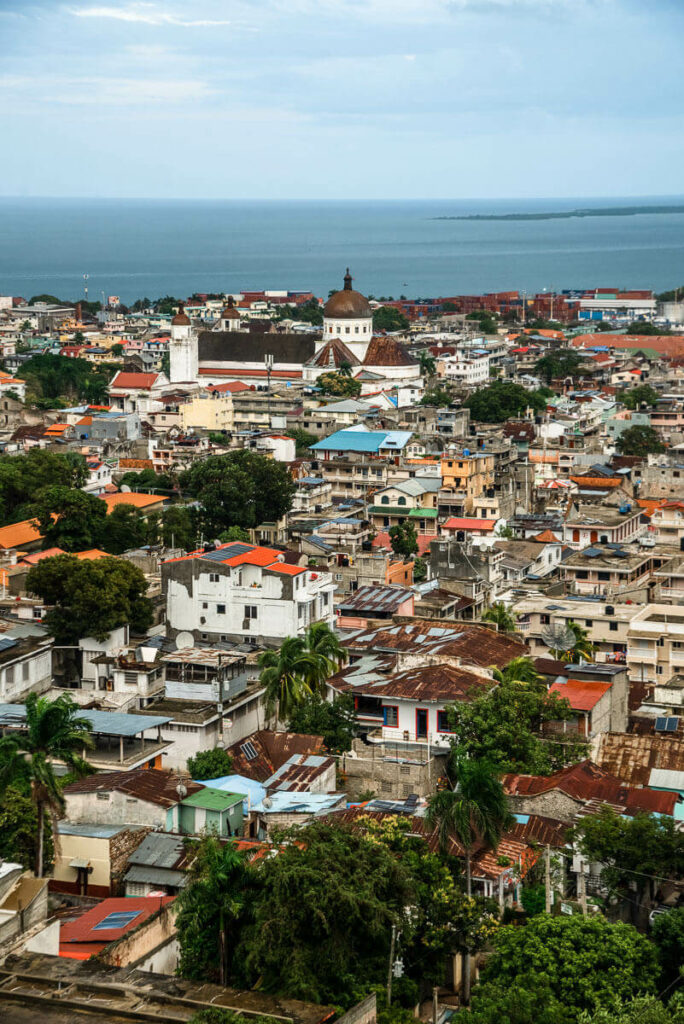
Iron Market: East of Place d’Armes, the Iron Market covers several streets of the city grid. It’s a bustling, fascinating market, something you won’t see anywhere else in the Americas, and very similar to local markets in West Africa.
Around Place de la Résistance: This is a pretty random place that won’t be mentioned in any guidebooks, but at the entrance to the city, just before reaching the bridge, there’s a huge outdoor market, one that tourists never see and the best place in Haiti for people-watching. This market is located almost right on the beach, and it reflects the typical images we see of Haiti on the news: absolutely massive piles of rubbisha being dragged away by the ocean waves.

Half-day trip from Cap-Haïtien: Bois Caïman
Bois Caïman is one of the most important places in Haiti .
On 14th August 1791, a group of black slaves from the sugar plantations of Cap-Haïtien and nearby areas gathered at a site called Bois Caïman to perform a Vodou ceremony, while also planning a mass uprising that quickly turned into the Haitian Revolution which freed the country from its French overlords.
Bois Caïman is located 10km from Cap-Haïtien.
How to visit Bois Caïman
If you want to do it the backpacking – hard – way, first take a tap tap towards Vaudreuil. From there, it’s a 2km walk to the actual village, but you can also catch a taxi motorbike.
In the village, there’s a painting and memorial of the Haitian Revolution and you can visit the actual cave where the Vodou ceremony took place, and where rituals are still held.
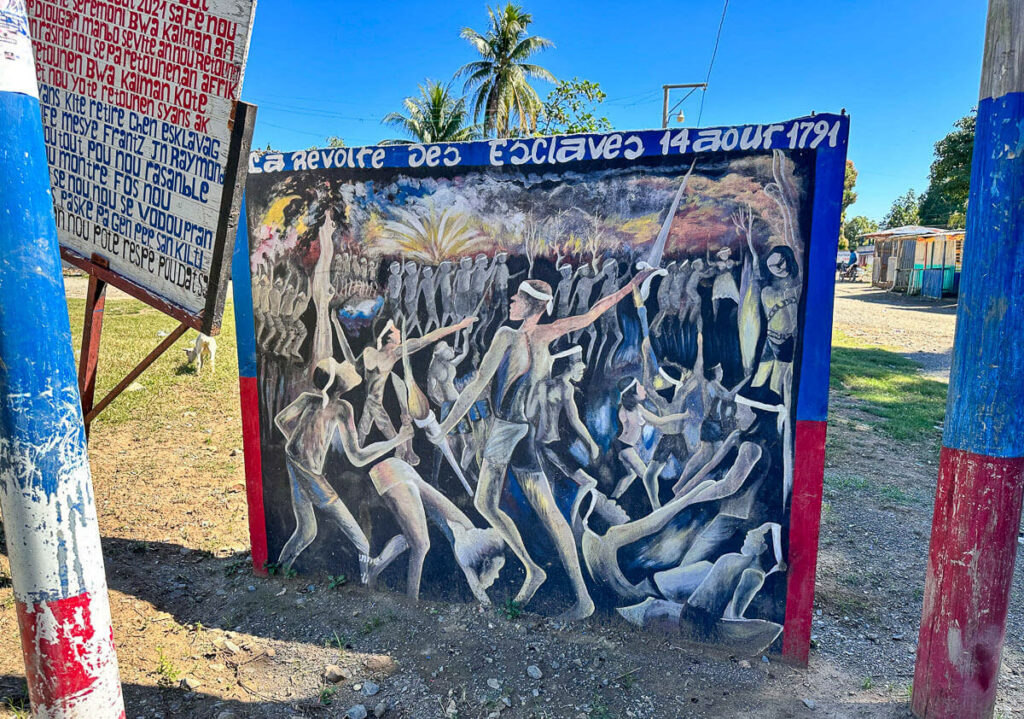
Day 3 – Day trip to Citadelle la Ferrière
In my opinion, Citadelle la Ferrière is the most beautiful place to visit in Haiti.
Less than 20km from Cap Haïtien, there’s a place called Milot, a rural town home to an absolutely astonishing fortress built on top of a mountain with superb views of the mountains around the region.
This is the largest fortress in the whole American continent, and a symbol of Haiti’s independence, built by black slaves who had gained their freedom – the first of its kind – and the reason Citadelle la Ferrière is today a UNESCO World Heritage site , and the most famous place to visit in Haiti.
It was built in the 19th century, commissioned by Haitian revolutionary Henri Christophe, and aiming to at thwart potential French invasions.
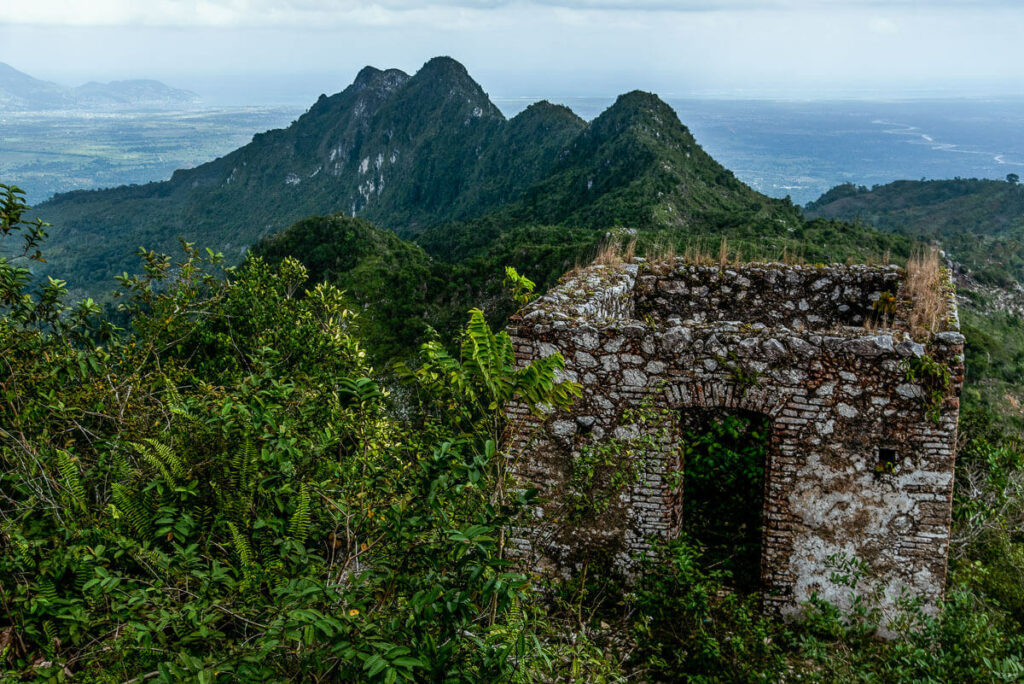
How to get to Citadelle la Ferrière
1 – Take a tap tap to Milot
The tap tap station for Milot is located here .
It costs around 100 Gourdes per person.
2 – Arriving in Milot and ticket office
Upon arriving in Milot, you will be approached by particularly intense young men on their motorbikes wanting to take you up to the Citadel. They won’t leave you alone.
The ticket office for going up to the fortress is 10-15 minutes away from the tap tap drop-off point.
The guys on the motorbikes will most likely follow you all the way there, insisting on taking you to the top.
The entrance fee to the Citadel is 1000 Gourdes.
3 – Going up to the Citadel.
Going to the top of the Citadel on foot is possible, but it would take a few hours.
Instead, you can hire someone to take you there on a motorbike, and a round-trip ticket should cost no more than 1000 Gourdes but you’ll probably have to bargain a bit.
Motorbikes can’t make it all the way to the top, so the last 1 or 2 kilometres must be done on foot. Lazier travelers can opt to ride a horse too.
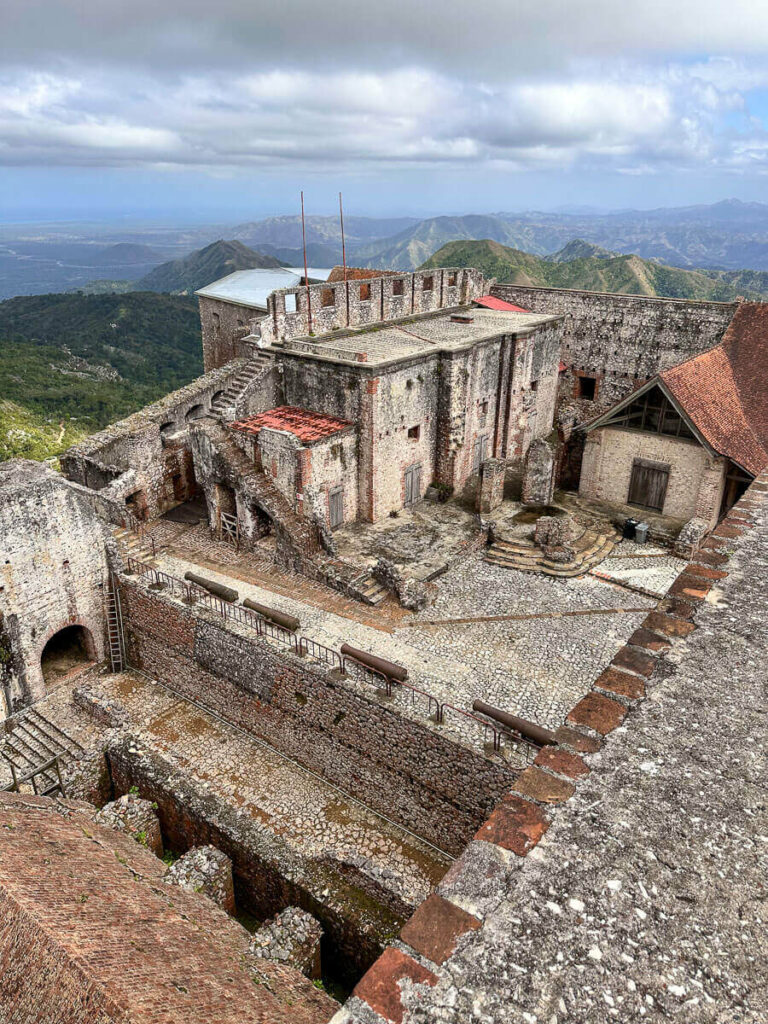
Day 4 – Hiking to Labadee
Many travelers agree that Labadee is the most beautiful place to visit in Haiti.
Labadee is the bit of coast west of Cap-Haïtien, on the other side of the small peninsula.
This is the best stretch of coast in the country, not only for its white-sand beaches and crystal-clear waters, but also because it’s impeccably clean and plastic-free, something hard to find in Haiti.
Labadee is in fact a pretty laid back settlement, more notably known for being home to a tourist resort named after the village.
This resort is an essential part of the itinerary for many Caribbean cruises sailing past the islands.
But don’t worry, the resort is a bit far from the village and nobody is allowed to enter unless they are a cruise passenger. Moreover, cruise passengers are either not interested in leaving the resort or they just think it’s too dangerous.
Actually, you won’t even notice there’s a resort here unless you climb one of the hills or come from Cap-Haïtien on foot.
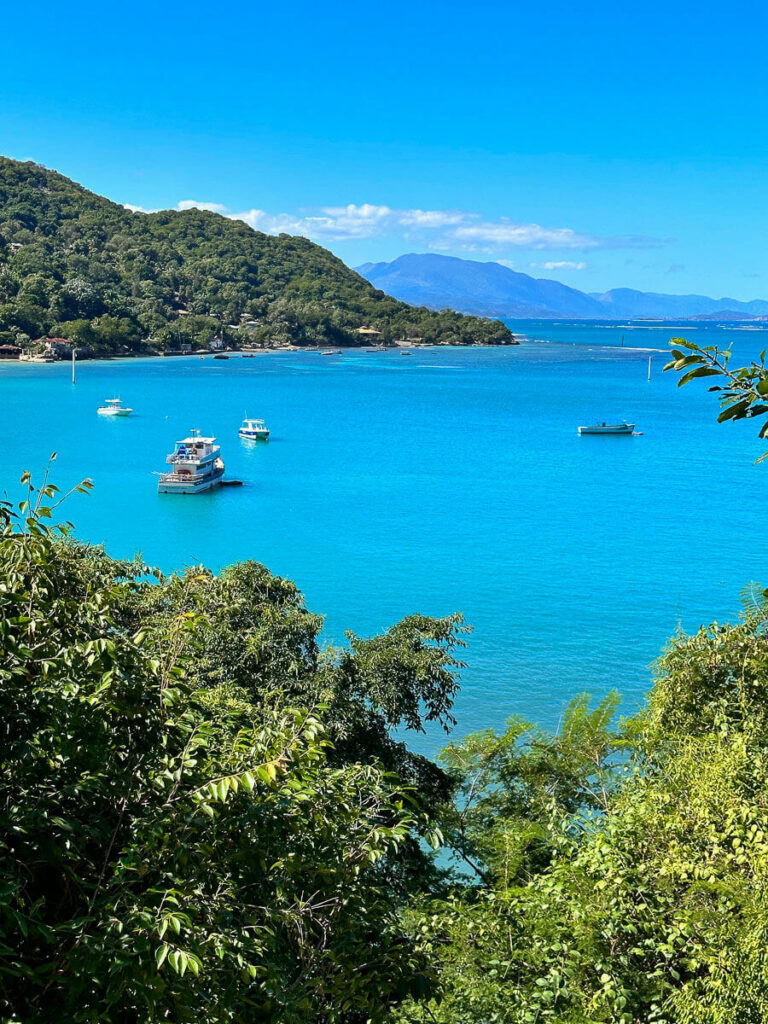
How to visit Labadee
The 10km hike that follows the coast from Cap-Haïtien to Labadee is an excellent day trip, and one of the best things to do in Haiti.
By the way, you can also get there by motorbike taxi, but you’ll be missing a lot of things on the way.
To hike to Labadee, you’ll first have to climb a hill through a slum, so there are no marked streets either, and it’s easy to get lost. In my experience, however, locals were pretty helpful in pointing me in the right direction.
You need to start climbing somewhere around here .
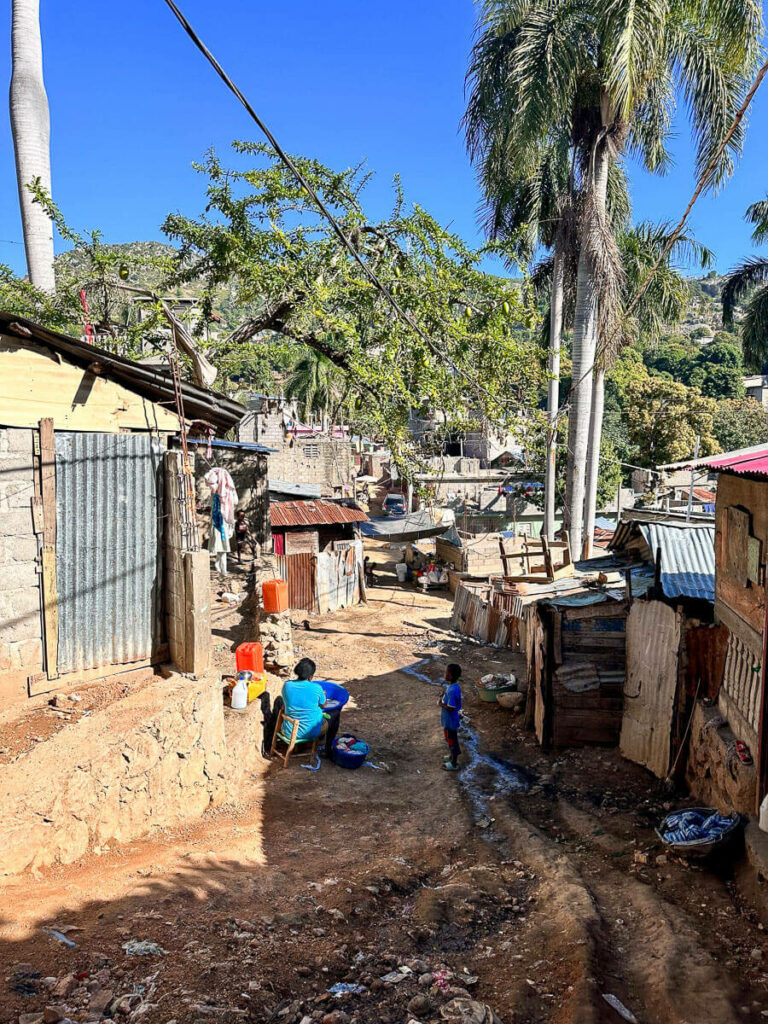
Once you leave the slum, you’ll get to the main road, and then you just need to follow the trail.
Things to do in Labadee
As mentioned, Labadee is a small settlement. There’s a small centre, the commercial area where locals gather and you can get a drink.
From there, local boats depart to different beaches and settlements in the peninsula. A one-way ride costs the equivalent of 1 or 2 USD.
I took the boat to a beach named Belly Beach. There’s a bar here, where you can order drinks and seafood. It wasn’t busy when I was there, and everyone was either wealthy Haitians or crew members from the cruise ship.
Day 5 – Travel from Cap-Haïtien to Port au Prince
I recommend visiting Port-au-Prince only if you have a good local contact, otherwise, I think it’s too dangerous to go.
Everyone in Cap-Haïtien will think that you are crazy wanting to travel to Port-au-Prince.
Maybe they’re right, I don’t know.
They will even say it’s not possible to travel there by land, declaring that road access into the capital is controlled by the gangs.
I actually believed them, so I decided to flew in instead.
Domestic flights are run by a local airline called Sunrise Airways, and the Cap-Haïtien – Port-au-Prince route is a short 30-minute flight.
However, it was after booking my ticket that I learn from my local contact in Port-au-Prince that buses do run regularly between the major cities, although they take a different route.
In any case, remember that the bus journey takes around 9 hours.
Day 6 – Port-au-Prince
Remember that there is basically a civil war going on in Port-au-Prince. Some places like Pétionville are safe but to go further afield, you must go with someone who knows their way.
The capital of Haiti is one of the most chaotic cities I’ve ever been. It is said that the city’s infrastructure can only accommodate a quarter of its total population, and what existing infrastructure there is isn’t great either, built in a city that has been crumbling since the earthquake in 2010 .
Port-au-Prince is dusty and extremely noisy, with piles of rubbish and extreme poverty filling all the streets.
To be completely honest, this isn’t a destination for most travelers although Against the Compass readers may find a certain appeal in its chaos, art scene and particular nightlife.
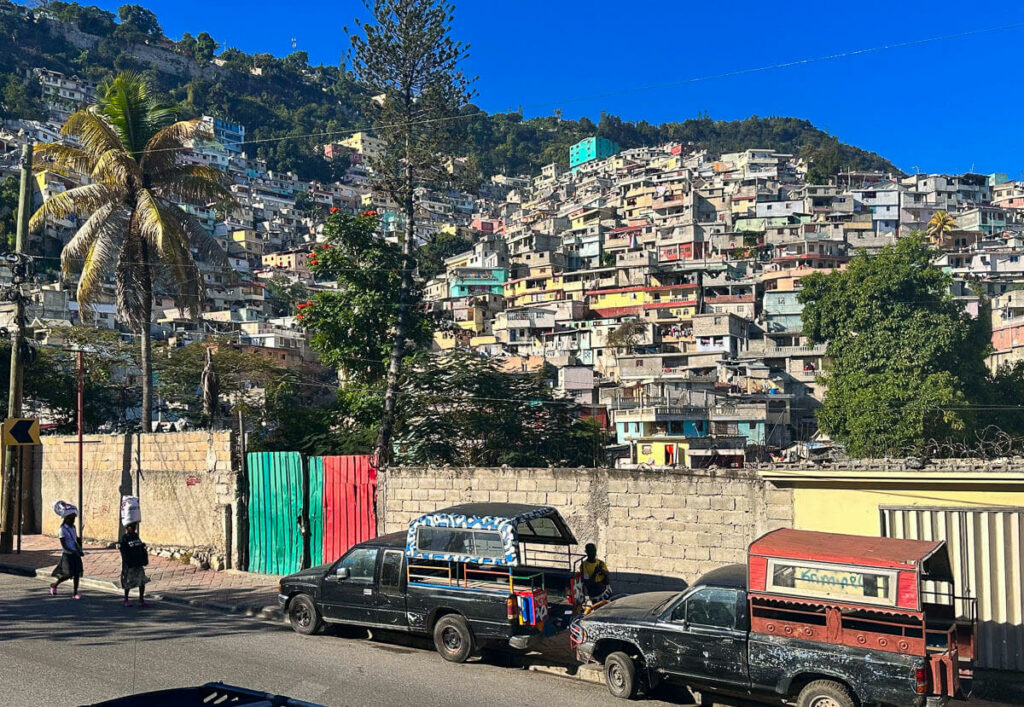
Port-au-Prince is an unmissable place to see in Haiti, and it’s sure not to disappoint you.
By the way, when visiting Port-au-Prince, you must stay only in Pétionville, the safest area in the city, and the only place where you can walk around freely. A good place to stay is Allamanda Hotel .
Things to do in Port-au-Prince
Pétionville: Originally a residential suburb in the mountains, Pétionville flourished after the 2010 earthquake, becoming the most prominent neighbourhood in Port-au-Prince, housing the best restaurants and hotels. This is a safe area to walk around, and one where you can enjoy a lively market, a beautiful street where they sell pieces of local art, and numerous bars and restaurants.
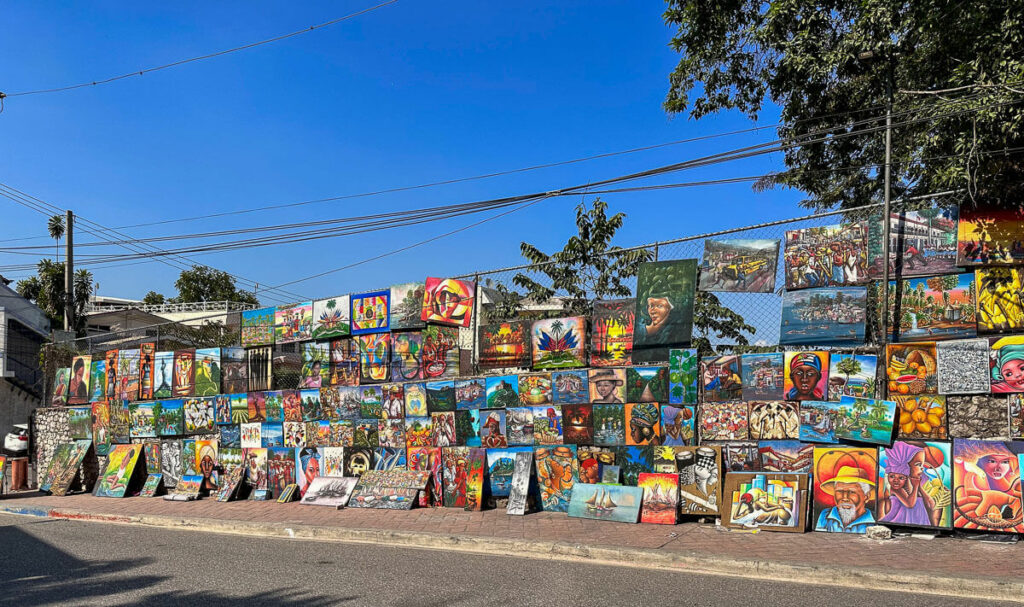
Atis Rezistants: A workshop where they create art out of trash, mainly Haitian Vodou-related pieces. This was one of the most interesting places to visit in Haiti.
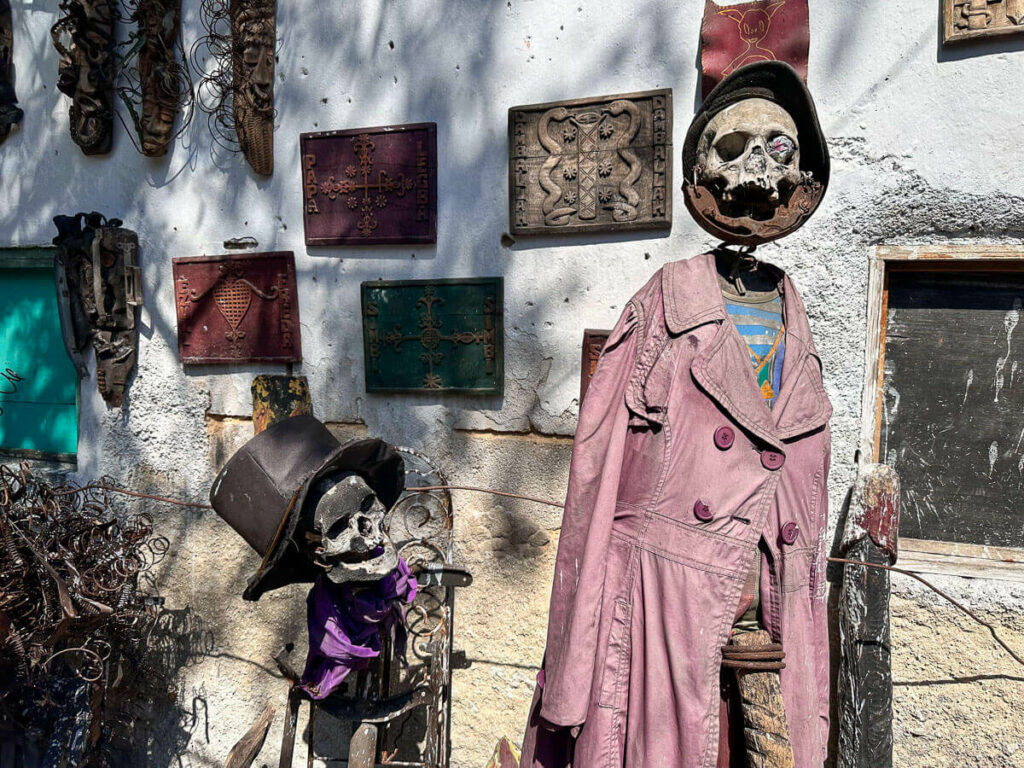
The National Pantheon Museum : Among other things, this museum features the anchor from Santa Maria , the largest boat used during Christopher Columbus’ expedition to the New World, back in 1492. Remember that the first place there ever set foot on was in today’s Haiti.
Check our travel guide for more information.
Cité Soleil: The poorest slum in all of the Americas and one of the largest in the world.
How to visit Cité Soleil
The most infamous place to visit in Haiti is Cité Soleil.
Cité Soleil is perhaps the most dangerous place in the Americas, and far more dangerous that infamous destinations such as Syria , Yemen or Afghanistan . The reason is that today, Cité Soleil is a battlefield for gangs trying to kill each other on an almost daily basis.
Despite the current situation, however, I did visit Cité Soleil with the help of a local fixer who personally knows the gangs controlling the area, and I actually had the chance to meet the sub-chief of G-PEP.
They showed me around the slum, we had a few beers with some gang members then left after 2 hours.

2 things I want to highlight:
Firstly, that I’ve never felt so intimated in my life as, the time I visited Cité Soleil. Upon arriving at the main gang checkpoint to enter the slum, a group of extremely young Haitians came running towards us, but as soon as they saw our fixer, they all calmed down.
It’s important to highlight that unlike checkpoints in Iraq for example, these Haitians do actually use their guns every other day.
Second, kindly note that I won’t be sharing my fixer’s contact details as I don’t want Cité Soleil to become a playground for backpackers since eventually, someone will get shot and I really don’t want to be involved. Street shootings do occur every every day and stray bullets are a thing.
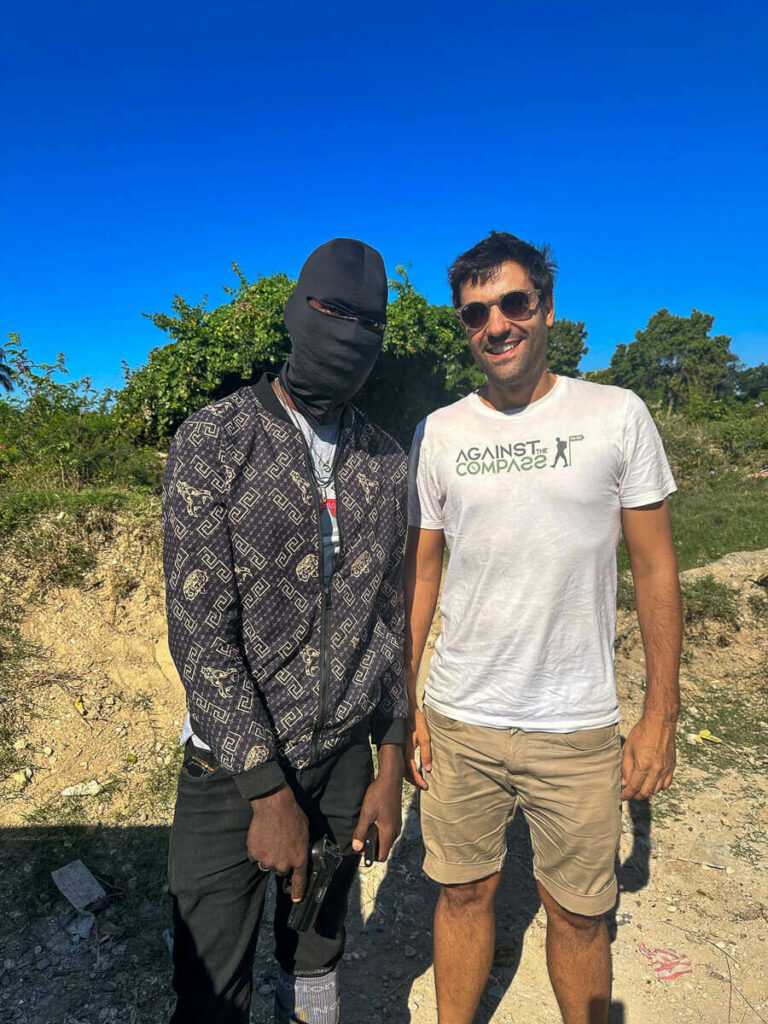
Day 7 – Mirelabais and Dominican Republic
Unless you wish to keep exploring Haiti beyond what is included in this Haiti travel itinerary, on day 7 of the tour, I recommend going back to Dominican Republic.
However, instead of getting a direct bus to Santo Domingo, I recommend doing it the backpacking way through Mirebalais and the Belladères border , so you can to see another, more rural side to the country.
Step 1: Get a bus to Mirelabais.
Buses run all day long, starting early in the morning. The station is located here .
Step 2: Get on a tap tap to Lascahobas.
You can find a taxi to take you to the border, but we couldn’t find a public tap tap .
Step 3: Get a final tap tap to the actual border.
No secrets, you’ll easily find the necessary transportation.
Step 4: Cross the border on foot.
On the Haitian side, you don’t have to pay any exit fees but on the Dominican side, a fee of 10 USD applies. I found this border to be very corrupt, so make sure you pay at the official stall, and get an actual receipt. The police may ask for it later.
Step 5: Bus from Elias Pina to Santo Domingo.
Elias Pina is a 20-minute walk from the border, maybe a bit more. There’s not much to see in this town, but it has a lively market and a very local feel. It’s easy to find transportation to Santo Domingo but you might want to spend the night here, or travel somewhere else instead. One piece of advice, however: I took the last bus to Santo Domingo, departing at 6pm. The ride was long and they dropped me off in the middle of the night at a very, very sketchy area of Santo Domingo, where muggings are not uncommon.
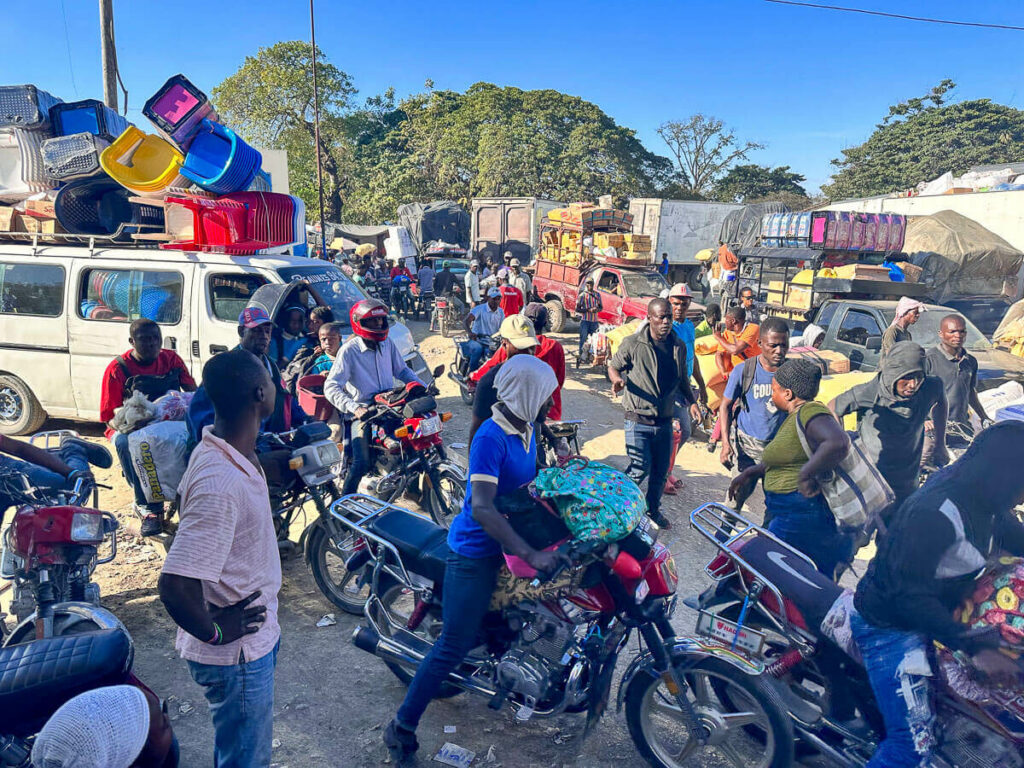
❗More information
📢 In my Travel Resources Page you can find the list of all the sites and services I use to book hotels, tours, travel insurance and more.
All guides and articles for traveling in Haiti destination
- Haiti Travel Guide
Check travel tips to the following offbeat countries:
- Afghanistan
Other Related Travel Guide Articles:
- How to visit Angel Falls
- How to visit Los Llanos
- Venezuela Travel Guide
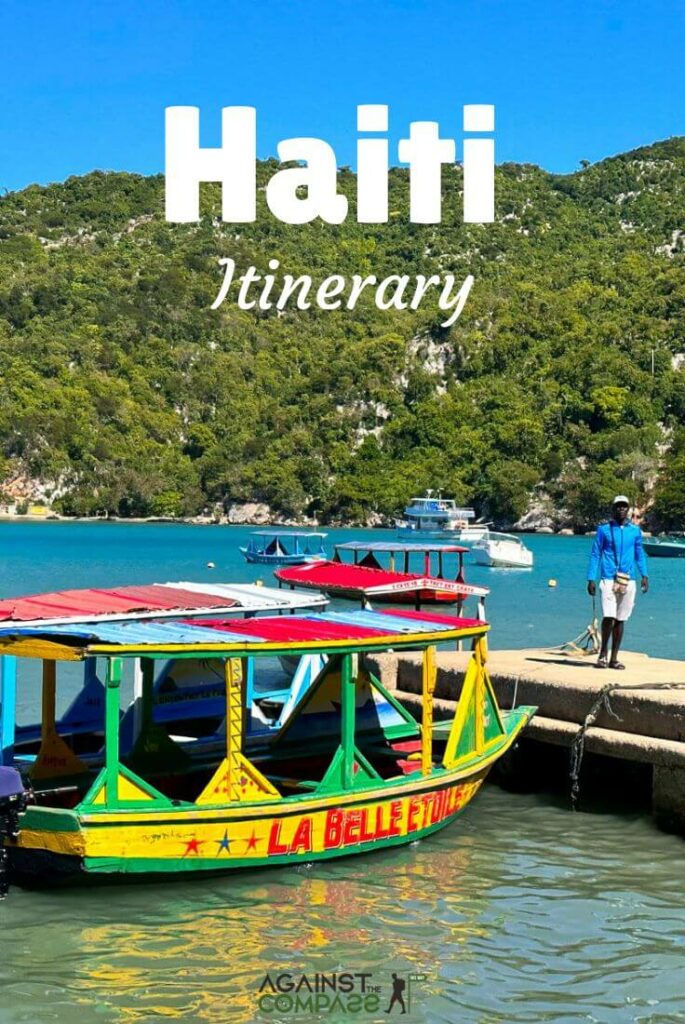
Leave a Comment Cancel reply
Your email address will not be published. Required fields are marked *
Notify me when new comments are added.
Join our Expeditions
From Syria to Iraq in Pakistan, Against the Compass is finally running expeditions to the most epic and off-the-beaten-track countries.
We have scheduled expeditions for every month of the year.
Latest posts
- How to travel to Eritrea in 2024
- How to travel to Svalbard in 2024
- How to travel to Afghanistan during Taliban rule (2024)
- How to Travel to Libya in 2024
- Backpacking Venezuela Travel Guide (2024)

Where is Haiti located?
What countries border Haiti?
Haiti Weather
What is the current weather in Haiti?
Haiti Facts and Culture
What is Haiti famous for?
- Cultural Attributes : Haitians are friendly, generous and proud of their history and culture. More
- Family : Haitian society is matriarchal, especially where child-rearing and family life is concerned. Haitian families consist of parents and children. In... More
- Personal Apperance : Casual warm weather clothing is traditional in Haiti. Western Style clothing is worn in Urban areas. Tee-Shirts and shorts or... More
- Recreation : Soccer is the national sport of Haiti. Cockfighting is also popular. In the Haitian streets you can watch a version of... More
- Diet : The main elements of the Haitian diet are corn, cassava, millet, rice and fruit. Tropical fruits such as pineapples, mangoes,... More
- Visiting : Haitians express their love of music and dance in “bamboches”. Bamboches are social gatherings where the dancing is pou' plaisi'... More
Haiti Facts
What is the capital of Haiti?
Haiti Demographics
What is the population of Haiti?
Haiti Government
What type of government does Haiti have?
Haiti Video
CountryReports YouTube Channel:
Haiti geography.
What environmental issues does Haiti have?
Haiti Economy
How big is the Haiti economy?
Haiti News and Current Events
What current events are happening in Haiti? Source: Google News
Haiti Travel Information
What makes Haiti a unique country to travel to?
Country Description
Criminal penalties, medical facilities and health information, safety and security, traffic safety and road conditions.

- Internet Citation
- Terms of Use
- Renew Membership
- Manage Membership
- Teacher Resources
- Get Your Widget
- Product Pricing
- Other Products
- United States Edition
- Sample Country

- ALL TRAVEL GUIDES
- DESTINATION FILTER
TOP OF PAGE
Quick Facts
Best Time To Go
Cost & Spending
Travel Tips
Regions & Highlights
What To See & Do
Itineraries
What To Eat
Where To Stay
Trip Planning

Welcome traveler!
We're Andre & Lisa, adventurers and experienced budget travelers.
We have over two decades of travel experience and since 2018 have led a full-time nomadic lifestyle.
L earn more about us !
Thank you for visiting and we hope you find value in our destination pages! We thoroughly research and curate all content ourselves and everything you find on this site is put together by only the two of us.

HAITI TRAVEL GUIDE
Haiti is a Caribbean country that shares the island of Hispaniola with the Dominican Republic to its east. Though it’s still recovering from a 2010 earthquake, many of Haiti's landmarks dating to the early 19th century remain intact.
Haiti is a country with a revolutionary, exciting past and its future remains uncertain. Though Haiti has faced hard times during the past decades, Haiti's tourism industry which bustled in the '60s to the '80s is returning. Resorts and investments are again transforming this misunderstood gem into a Caribbean tourist spot. With a modicum of stability, Haiti could become the Caribbean’s alternative travel destination par excellence: it has palm-fringed beaches to rival any of its neighbours. But lazing on the sand with a rum punch isn’t the point of Haiti (although that's entirely possible). The richness of the country lies in its history and culture. The slave revolution left behind many historic sites, including the Citadelle la Ferrière – a fortress that easily holds its own against anything similar in the Americas. Haiti’s history has meant that it’s kept closer to its African roots than any other Caribbean nation, a legacy that’s ever-present in its vibrant art and music scenes.
The current situation in Haiti is marked by significant instability. There are reports of violence, a state of emergency, and other serious concerns. Under these conditions, it would not be responsible to recommend travel to Haiti as a tourist.
DO YOU NEED A VISA FOR HAITI?
<<VISA RESULT>>
<< Visa Details >>
For the latest requirements or for application click
Let iVisa take the pain out of travel planning and assist you with Electronic visas, Travel Authorizations, Visas on Arrival, and even Paper Visas. They can also help with Health Declarations and Embassy Registrations. If you're from the US, they provide a One-Stop Shop to renew your Passport securely and error-free.
⬇️ REGIONAL GUIDES ⬇️
Travel guide.

⬇️ COUNTRY GUIDE ⬇️
ADVERTISEMENT
- Capital : Port-au-Prince (Haitian Creole: Pòtoprens)
- Currency : Gourde (HTG) (US dollars widely accepted)
- Area : 27,750 km²
- Population : 11,12 million (2018)
- Language : French, Creole (Kreyol Ayisyen)
- Religion :Roman Catholic 80%, Protestant 16%, but much of the population also practices Vodou
- Electricity : 110/60Hz (USA Plug)
In practice, most Haitians refer to the Haitian dollar (H$) when quoting costs. The gourde used to be tied to the US dollar at a rate of one to five, with the result that five gourdes is universally known as one Haitian dollar. It’s a system seemingly designed to perplex short-term visitors. When buying something, always check what people mean when quoting the price, eg whether a hundred is in gourdes or dollars (in which case it’s 500 gourdes). To make things even more confusing, prices for expensive goods (or tourist souvenirs) are sometimes listed in US dollars. The way to minimize headaches is to choose one system, either the Haitian dollar or the gourde, and stick with that. If you choose to work in Haitian dollars, you must divide prices in gourdes by five; if you choose to think in gourdes, you must multiply all Haitian dollar prices by five. You’ll eventually be able to make price comparisons to your home currency, which is nearly impossible if you keep slipping between the two systems.
- 1 January, Independence Day
- 2 January, Ancestors’ Day
- 14 April, Pan-American Day
- 18 May, Flag and University Day
- 15 August, Assumption
- 17 October, Anniversary of the Death of Jean Jacques Dessalines
- 24 October, United Nations Day
- 18 November, Vertières Battle Day
- 5 December, Discovery Day
Also, Carnival, Good Friday, Ascension Day, and Corpus Christi.
- Carnival Port-au-Prince - (three days before Ash Wednesday) The highpoint is the huge parade of floats, music and carnival queens that winds its way downtown through an immense crush of people, before climaxing at Champs de Mars.
- Carnival Jacmel - (culminates one week before Shrove Tuesday) The streets suddenly swell and everywhere you look are strange figures in fantastical papier-mâché masks – the signature image of Jacmel Carnival. Mixed in with the procession are celebrants dressed as Arawaks and colonists, and horned figures covered in molasses and soot, who tease revellers with their sticky grab
- Fet Gédé - Nationwide Vodou festival marking All Saints’ Day – a festival for the dead – held in cemeteries everywhere.
- Saut d’Eau - (early July) Haiti’s biggest Vodou pilgrimage, with thousands of adherents bathing in the pools of a sacred waterfall.
- Souvenance - Held near Gonaïves after Good Friday – a huge Vodou festival, its ceremonies originating from the camps of runaway slaves.
QUICK BOOKING RESOURCES
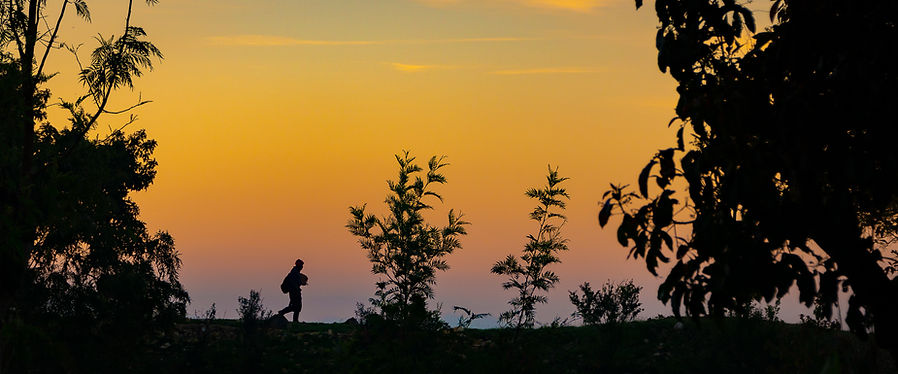
SEASONS AT A GLANCE
Most destinations have different times of the year when they’re more or less popular with tourists.
Peak Season
Shoulder Season
Off Peak Season

BEST TIME TO VISIT HAITI
Located in the Caribbean’s Great Antilles, Haiti has a hot and humid tropical climate. Daily temperatures typically range between 19°C and 28°C in the winter and 23°C to 33°C during the summer months. Northern and windward slopes in the mountainous regions receive up to three times more precipitation than the leeward side. The Plaine du Gonaïves and the eastern part of the Plaine du Cul-de-Sac are the driest regions in the country. The wet season is long, particularly in the northern and southern regions of the island, with two pronounced peaks occurring between March and November.
- HIGH SEASON (NOV–MAR) - Hot and dry; added attractions are Carnival in Port-au-Prince and Jacmel (Feb), and the countrywide Fet Gédé Vodou festival. The north is frequently rainy.
- SHOULDER (APR–JUN) - Rain in the south.
- LOW SEASON (AUG–OCT) - Hurricane season, but travel is perfectly feasible if there are no storms. Often heavy daily rainfall with high humidity.
BEST TIME FOR:
Snow Sports
While outdoor activities in Haiti can be enjoyed all year round, the best time is during the dry season from November to April. It can get very muddy during the rainy season, in particularly May, September and October.
The best time to visit the stunning beaches of Haiti is during the dry season from November to March. April and May can still be pleasant, but you're best off avoiding the hurricane season from June to October.
Haiti has some good surf from November to March, which is also the dry season. Note that from June to October it is hurricane season so it is really not advisable to be on the water.
You can expect nine months of good kitesurfing conditions in Haiti. The best period is from December to April as the winds are really consistent. July to September can be pretty good too.
While October and November may have good wind, it's the hurricane season so you need to carefully monitor the weather. The only months with very few kitable days are May and June.
For more details on kite surfing in Haiti expand this section!
FIND ALTERNATIVES TO HAITI?
Find your perfect destination.
Advanced, real-time destination filter by visa required, region, health risk, travel budget, country value, tourist seasons, best weather and activity or sport.
MORE POSTS ON HAITI

WEWILLNOMAD

HAITI TRAVEL COSTS
Daily budget.
- LESS THAN US$50 - Hotel room: US$40, cheap street food and markets for self-catering, public transportation.
- MIDRANGE US$100 - Room in midrange hotel: US$70, lunch and dinner in decent restaurants, internal flights: around US$85.
- TOP END OVER US$120 - Room in a top-end hotel: from US$90, meal at a top restaurant: US$30, 4WD rental will around US$150 a day.
You can eat on any budget in Haiti; spending just a few gourdes on filling fritay (fried street food), eaten on the hoof, or dining in the posh restaurants of Pétionville, where a main course might set you back US$20. The most typical experience is eating in a bar-resto (a bar-restaurant, less formal than a proper restaurant), with a plateful of fried pork or chicken with plantains, salad and a beer, all for around US$4. Vegetables aren’t high on the agenda, but there’s plenty of fresh fruit. Excellent seafood abounds along the coast.
VALUE RANK:
Find discount flights to haiti, travel tips for haiti, getting around port-au-prince.
- TO/FROM THE AIRPORT - It takes around 30 to 45 minutes to reach the airport from the city centre, depending on the time of day. Airport taxis are run by the Association des Chauffeurs Guides d’Haïti. Fares should be between US$20 and US$40. You can take a taptap to or from the airport (HTG10); they wait outside the terminal and drop passengers off at the corner of Blvd Toussaint Louverture and Rte de Delmas.
- MOTO-TAXI - Useful for weaving through traffic jams. They cost around HTG30 to HTG40 for short trips, haggle for longer distances.
- TAPTAP - Port-au-Prince’s taptaps run along set routes and are a very cheap and convenient way of getting around. The usual fare is HTG10 per trip. Routes are painted on the side of the cab doors. All stop on request. Shouting ‘Merci chauffeur!’ or banging on the side of the vehicle will stop the driver. Particularly useful routes include Lalue to Pétionville, Rte de Delmas to Pétionville and Canapé Vert to Pétionville. Routes running north-south include Aéroport to Nazon, and Saline to Martissant (along Grand Rue).
- TAXI - Collective taxis running set routes are called publiques, recognizable from the red ribbon hanging from the front mirror. Hail as you would a taptap. Fares are set at HTG25. If you get into an empty publique and the driver removes the red ribbon, he’s treating you as a private fare and will charge accordingly – up to US$20 if you’re going a long way. State clearly if you want to ride collectif and share the ride with others. Publiques don’t tend to travel between Port-au-Prince and Pétionville, so hiring is often the best option.
REGIONS & HIGHLIGHTS OF HAITI
Suggested travel itineraries for haiti.
One Week In the North
From Port-au-Prince, catch an internal flight up to Cap-Haïtien. Take a full day to make a tour out to the Citadelle and the ruined palace of Sans Souci – spend the night at the cultural center in Milot. Back in Cap-Haïtien, explore the architecture of the old city and walk along the coast to the cliff-bound remains of Fort Picolet. The following day, take a vehicle and boat-taxi to Labadie, possibly stopping en-route at Cormier Plage – for the Atlantic coast scenery and beaches. If you’re after some real adventure, drive overland to Port-de-Paix and arrange a boat trip to Île de la Tortue, Haiti’s pirate island. On the way back to Port-au-Prince, pause in Cabarete to stock up on tablet (local peanut brittle).
10 Days In the South
Take a short flight (or a long drive) from Port-au-Prince to Jérémie, in the far southwest. Explore the town, and beaches west such as Anse d’Azur. Head south on the new road over the Massif de la Hotte mountains, and break for the night in Les Cayes. You’ve done the hard traveling now, so enjoy your pick of Haiti’s best beaches. It’s a short boat trip out to the gorgeous Île-à-Vache, or an equally short drive to Port Salut. Either way, all your Caribbean clichés of white sand, palm trees and grilled fish on the beach will be easily fulfilled. When you’re done, turn east. The Port-au-Prince highway splits near Léogâne, so let it take you to Jacmel. Check out the town’s historic quarter, and fill up on souvenirs with the handicrafts the town is famed for. And with that, you’re ready to return to the capital.
Highlights of Port-au-Prince & Surrounds
- Discover the mind-bending recycled artworks of the Grand Rue artists .
- Dance to Vodou rock ’n’ roots music until the small hours at a RAM concert .
- Shop for metal artwork at Croix des Bouquets .
- Laze on the sand at the beaches of Côte des Arcadins .
- Stretch your legs and enjoy the views while hiking in Parc National la Visite .
A true city of the developing world, just an hour by air from Miami, Port-au-Prince is preceded by a reputation for impoverished chaos, even before the 2010 earthquake literally shook it to its foundations. The infrastructure is compromised, the gulf between rich and poor remains as wide as ever, and the quake’s rubble and tent camps are acquiring a terrible sense of permanence.
And yet, the city remains one of the most vibrant and exciting in the Caribbean. Like a bottle of local klerin rum, Port-au-Prince takes all the raw energy of Haiti and distils it into one buzzing shot, and witnessing the self-sufficiency and spirit of its people might be the most life-affirming experience you will have on your travels.
Download map waypoints for Haiti here: KML / GPX
WHAT TO SEE AND DO IN HAITI
More location information and points of interest are available in the above map
SOUTHERN HAITI
Haiti’s south is about taking it easy. Pulling out of Port-au-Prince, the urban hustle is soon replaced by a much more relaxed air as you head towards the Caribbean Sea. Of the southern coastal towns Jacmel is the gem. It’s an old port full of pretty buildings, with a friendly welcome. Some hit the handicrafts shops to load up on local art, while others time their visit for the famous Carnival. Further west, things get pretty sleepy. The town of Les Cayes is an embarkation point for the gorgeous beaches of Île-à-Vache, while there are more palm-fringed sandy delights for all budgets in nearby Port Salut . The southern ‘claw’ is bisected by the Massif de la Hotte, home to Haiti’s last remaining cloud forest. After a spectacular mountain crossing, the road terminates at Jérémie , the sometime City of Poets.
Highlights of Southern Hailti
- Explore the architecture of old Jacmel .
- Have your mind blown by the street theatre of Jacmel Carnival .
- Dive into the cool waters of Bassins Bleu waterfall .
- Get away from everything by heading to Île-à-Vache .
- Laze on miles of sandy beaches at Port Salut .
- Find the city at the end of the road in Jérémie .
- Cut an adventurous trail into remote Parc National Macaya .
From Port-au-Prince, Rte National 2 runs the length of Haiti’s southern ‘claw’ to Les Cayes. After crawling through Carrefour , the road winds through a succession of medium-sized towns along the coast: Léogâne , which is known for its distilleries and stone sculptors; Petit-Goâve , famous for its sweet dous macoss (a type of peanut brittle); and the port of Miragoâne , its streets brimming over with imported (and often smuggled) goods, and home to a large cathedral. This region was the hardest hit by the 2010 earthquake, whose epicentre was just outside Léogâne. Around 80% of the buildings in that town were damaged or destroyed, with great loss of life. Petit-Goâve was almost as badly hit.
The coastal road used to be popular for weekend beach visits from the capital before traffic made the resorts of Côte des Arcadins a more attractive prospect. From Miragoâne the road cuts inlands and heads across the mountains westward to Les Cayes.
Buses and taptaps ply the highway all day between Port-au-Prince and Les Cayes.
NORTHERN HAITI
f you’re interested in how Haiti came to be as it is today, head north. From Columbus’ first landfall on Hispaniola to the key events of the slave revolution, it all happened here. Base yourself at Cap-Haïtien , Haiti’s second city. Once one of the richest colonial ports in the world, it’s the ideal base to visit the magnificent Citadelle la Ferrière, a true castle perched high on a mountain, with the ruined palace of Sans Souci sitting below, looking like something from a tropical Hollywood adventure movie. There are plenty of smaller forts along the coast, while Île de la Tortue evokes memories of the golden age of piracy. The crashing Atlantic waves give the north some spectacular coastline and great beaches. Cormier Plage and Labadie are a stone’s throw from Cap-Haïtien and are ideal places to unwind.
Highlights of Northern Haiti
- Relive Haitian history at the Citadelle and ruins of Sans Souci .
- Let the waves lap at your feet at Plage Labadie .
- Explore the backstreets of Haiti’s second city, Cap-Haïtien .
- Join the pilgrimage to the Souvenance Vodou festival .
- Feel the Vodou rhythms of the Soukri Vodou festiva l.
- Look for pirates at Île de la Tortue .
- Find the remains of France’s colonial history at Fort Liberté .

WHAT TO EAT IN HAITI
There’s a wide range of restaurants in Port-au-Prince . The default menu is Creole, with a smattering of French and American dishes. If you’re downtown, you should also consider the hotel restaurants – many restaurants close on Sundays and lots of places only open in daytime hours during the week (lunch is the big meal of the day). For a wider range of eating options, head up the hill to Pétionville – the post-quake influx of foreigners has actually led to a mini boom of new places opening up.
Top Food Tips
- A bottle of Barbanourt Five Star rum always impresses as a present for friends.
- Haiti’s ‘Madam Francis’ mango is one of the sweetest and juiciest.
- Add some chili heat with Ti-Malice sauce.
LGBTQ IN HAITI
I'm a paragraph. I'm connected to your collection through a dataset.

WHERE TO STAY IN HAITI
For a first-time visit to Haiti, choosing the right area or region to stay in depends on your interests, whether you prefer exploring historical sites, relaxing on beautiful beaches, or immersing yourself in vibrant culture. Here are some recommendations along with accommodation options in different price ranges:
Where to stay in Port-au-Prince:
Port-au-Prince, the capital city, offers a mix of history, culture, and urban life, serving as a gateway to Haiti's attractions and experiences. Explore landmarks like the Iron Market, National Museum of Haiti, and Cathedral of Our Lady of the Assumption.
Budget : Le Plaza Hotel offers budget-friendly accommodations with comfortable rooms and basic amenities. It's centrally located, making it convenient for exploring the city. Guests appreciate its friendly staff and reasonable prices.
Mid-range : Marriott Port-au-Prince Hotel provides comfortable mid-range accommodations in a convenient location near Port-au-Prince's attractions. Guests can stay in well-equipped rooms, enjoy access to a restaurant and bar, and take advantage of services such as laundry and concierge assistance.
Luxury : Hotel Montana is known for its scenic hilltop location, offering panoramic views of the city and the surrounding mountains. It has a range of accommodations, including rooms and suites, along with amenities such as restaurants, bars, swimming pools, and event spaces. The hotel is popular for its tranquil ambiance, lush gardens, and attentive service. However, it's worth noting that in 2010, Hotel Montana was severely damaged by the earthquake that struck Haiti. Since then, it has undergone renovations and reopened to guests.
Tip : Consider visiting during the off-peak seasons (rainy season from May to October) for better rates and fewer crowds in Port-au-Prince.
CHOOSE ANOTHER DESTINATION
Recent blog posts, plan your trip, visa services, let ivisa take the pain out of travel planning and assist you with electronic visas, travel authorizations, visas on arrival, and even paper visas. they can also help with health declarations and embassy registrations. if you're from the us, they also provide a one-stop shop to renew your passport securely and error-free..
FLIGHTS Find a cheap flight by using Sky scanner or Momondo . These are our favourite flight search engines. They index other travel websites and airlines across the globe to easily find you the best deal.
ACCOMMODATION
Booking.com is our number one resource for researching and booking accommodation. In addition to Booking.com , we have found Agoda.com to consistently returns the cheapest rates in Southeast Asia.
TRANSPORT
DiscoverCars.com is a leader in online car rental bookings; we compare car rental deals from many companies so that you can choose which is best for your trip. 12Go connects the world door-to-door, from transfers to flights, under the same user-friendly ticket.
INSURANCE Travel insurance can protect you against unexpecte d illness, injury, theft, and cancellations.
Heymondo (International Travel Insurance)
World Nomads (Travel / medical insurance for long-term travellers and nomads)
SafetyWing Nomad Insurance (Travel / medical insurance for long-term travellers and nomads)
Need more help to book your trip? Check our complete resource page for all the best companies to use when you travel. You will only find the companies we use ourselves.
Please note that some of the links above may be affiliate links, and at no additional cost to you,
we may earn a commission if you end up making a purchase.
Haiti is a poor country, but there’s another story out there as well. It’s one that you’ll find by getting out there and exploring, squeezing into buses or having a cold beer at a street-side bar, learning Creole and listening to locals tell their own stories. Paul Clammer author of Haiti: The Bradt Guide
Why travel to Haiti? The country has long been haunted by a negative media image, not least with the knocks that part of the country took from Hurricane Matthew in late 2016, but recent years have seen an alternative and more positive narrative beginning to emerge. Haiti has been coming out to the world in a more confident way, with tourism very much a part of the story. Put it another way: Haiti is the last great undiscovered travel frontier of the Caribbean.
Haiti’s sugar-sand beaches, exhilarating mountain trails and Vodou-tinged culture make it one of the most captivating corners of the region. Despite the country’s recent tribulations, there’s another story beyond the headlines – one that you’ll discover by jumping aboard technicolour taptaps , sipping cold beer at a street-side stand and listening as the welcoming Haitians tell their tale.
From the flamboyant dancing and street theatre of the Jacmel Carnival and the epic mountain fortress of the Citadelle Henry to long-forgotten colonial outposts and tranquil fishing islands, Haiti is a truly captivating destination.
Seventy years ago, Haiti practically invented Caribbean tourism, with the clubs of Port-au-Prince as fashionable as the casinos of pre-revolutionary Havana. All the reasons that drew visitors to Haiti then still exist today; they’ve just been obscured from view. Maybe now is finally the time to rediscover them.
Food and drink in Haiti
Haitian cuisine is an interesting blend of African and French influences, with an occasional taste of hot peppers thrown in for a Caribbean twist. Eating out is typically an unceremonious affair, at a ‘bar-resto’ or quite possibly served up in a polystyrene food box on the street by a woman cooking several pots over a charcoal brazier. Port-au-Prince (especially Pétionville) has the fanciest restaurants with a wide variety of cuisines, although elsewhere there’s not much international food besides burgers, pizza and spaghetti. All the more reason then to stick to Haitian cuisine – manje kreyòl .
If Haiti has a national dish, it has to be rice slowly cooked with beans and served with stock or sauce. Diri ak sos pwa , as it’s locally known, is everywhere, and you’ll eat a lot of it. The sauce, called bouyon or ragu , is almost always a stew with some potato, onion and tomatoes, spices and preferably meat of some description. This can be beef ( bèf ), goat ( kabrit ) or chicken ( poule ). Legim is a stew containing just vegetables, although vegetarians should note that meat is often used as a flavouring in the stock. Plantain ( bannann ) is a common accompaniment, either sliced and fried, or stewed. Other starch vegetables to look out for are yam ( yanm ) and militon (a type of squash).
A variant on rice and beans is diri djon djon – tiny dried mushrooms are cooked with the rice, turning it black but imparting a great flavour. Avocados ( zaboka ) make a good accompaniment to almost any meal. Their size and creamy yellow-green flesh put modern supermarket varieties to shame.
Soups are popular. Most famous is soup jomou (sometimes also called soup giramoun ) made with pumpkins and eaten every 1 January (Independence Day). Also common is mayi moulen , a thick cassava porridge, served as an accompaniment to a main meal, or a countryside staple.
An unexpected addition to Haitian cuisine is the influence of Arab dishes brought in by Syrian and Lebanese immigrants in the early 20th century. Most notable is kibbeh – ground beef and bulgur wheat made into balls and fried. Haitian tastes have added a little more spicy heat to the traditional recipe. Spaghetti is widely available, although it has been adopted almost exclusively as a breakfast dish, often with herring and ideally served liberally covered in tomato sauce. Most hotels will offer eggs and bread as well. Local guava ( gwayav ) jam is excellent, as is the peanut butter, served straight ( mamba ) or with a hint of chili ( mamba piman ).
For a country with such an extensive coastline, it’s no surprise that seafood is plentiful. Anywhere near the sea you can find plenty of fish ( pwason ), lobster ( woma ) and especially conch ( lambi ). However, note that lambi populations are collapsing across the Caribbean region owing to over-fishing.
There are plenty of good and cheap street food options for quick eating, mostly falling under the umbrella of fritay , or fried food. Pieces of chicken, beef ( tasso , rather than bèf in this case), fish or goat are fried up, but tastiest of all is griyo , or fried pork. Vegetarian options include marinad (fried dough balls), accra (fritters of malanga , a starchy root vegetable), and the ubiquitous bannann pese (fried plantain). Fritay is best accompanied with a spoon of pikliz – cabbage and carrot slaw made with chili-spiced vinegar. Plantain is also thinly sliced to make a local equivalent of potato chips, called papite , sold in small bags, often with similarly prepared breadfruit ( lanm veritab ). Another good snack to eat on the go is pate , small savoury pastries with meat, fish or chicken.
Fruit juices are very popular. Best of all is shadek , made from the Haitian grapefruit, and sweeter than regular grapefruit. In season look out for grenadya (passion fruit), seriz (cherry), as well as zoranj (orange). A colder option than a straight juice is a fresco made with juice syrup poured over shaved ice. Sold in the street, a fresco cart is invariably surrounded by a small swarm of bees.
Treated water is widely available, and is provided free in restaurants. You can buy small bottles everywhere (local brands include Crystal and Aquafine), while the Culligan brand has become synonymous with treated water, and is frequently used as shorthand for the five-gallon containers that most treated water comes in. On the street, you’ll also see vendors selling small sachets of treated water. Do not drink the tap water.
Coffee is grown throughout Haiti, and is almost uniformly excellent – rich in flavour and lacking in bitterness. Of the locally available brands, Café Rebo and Café Selecto both offer good blends. In the country (and a few guesthouses, if you’re lucky), people grow and roast their own.
As befits any Caribbean country, Haitians are proud of their rum ( rhum ). The most celebrated brand is Barbancourt, a double-distilled dark rum made from local sugarcane (not molasses, like many rums), and a noted Haitian export. Barbancourt produce a very drinkable three-star rum (aged four years), an even smoother five-star (aged eight years) and an eye-wateringly expensive 15-year reserve. Also available is the slightly cheaper rum produced by Bakara.
Health and safety in Haiti
Travelling somewhere like Haiti presents different potential health issues compared with Europe or North America. By taking sensible precautions you can greatly reduce your risk of catching any serious diseases, and visitors are unlikely to encounter any medical problems more acute than a possible attack of travellers’ diarrhoea.
It’s recommended to visit your doctor or travel clinic at least six weeks before travelling to allow plenty of time for any potential course of vaccinations. Last-minute injections can give only partial cover for some diseases. It’s strongly advised to have immunisations against diphtheria, tetanus and polio which come as the all-in-one vaccine Revaxis, which lasts for ten years. Vaccination against hepatitis A and typhoid, both diseases transmitted through infected food and water, are also strongly recommended, as is vaccination against cholera. The oral cholera vaccine, Dukoral, is available for those aged six and over as a two-dose schedule. The two doses should be given one to six weeks apart and at least one week before arriving in Haiti. For those aged two–five years then a three-dose schedule is used. Other vaccines that should be considered are hepatitis B, especially if you are working in hospitals or with children, meningitis (ACWY) and rabies. Hepatitis B and rabies schedules are a series of three vaccines over three to four weeks so allow plenty of time for vaccination.
You should also get the most up-to-date advice on anti-malaria prophylaxis. If you’re planning to be in Haiti a long time, a dental check-up before flying out is a good idea. If you wear glasses, take a spare pair and a copy of your prescription. It’s also very important to take out comprehensive medical travel insurance before travelling to Haiti. Make sure the policy covers medical evacuation.
Travel clinics and information
A full list of current travel clinic websites worldwide is available on www.istm.org . For other journey preparation information, consult www.travelhealthpro.org.uk (UK) or http://wwwnc.cdc.gov/travel/ (US). Information about various medications may be found on www.netdoctor.co.uk/travel. All advice found online should be used in conjunction with expert advice received prior to or during travel.
People who have never been to Haiti tend to ask two things when you tell them you’re going there: Is anything still standing after the earthquake? And: Is it safe? Haiti, it’s safe to say, has had a troubled image abroad ever since it freed itself in the world’s only successful slave revolution. Travel advisories from the US State Department ( www.travel.state.gov ) once warned against travel to much of Haiti, but now mostly offer better and more nuanced advice – usually related to current political developments. The same goes for the British Foreign Office ( www.fco.gov.uk/travel ). Note that in the event your government does advise against travel to a particular area, this can invalidate regular travel insurance; so, while government advisories are only part of planning for a trip, they’re still important to take note of.
Female travellers
Haiti lacks the macho Hispanic culture of neighbouring Dominican Republic, although most foreign women will receive some amount of unwarranted romantic attention during their stay. Most of this is simply annoying, from whistling or making kissing sounds to get attention, although it can still make an individual feel uncomfortable. It’s best to be prepared and, if possible, develop a sense of humour (or at least public indifference) to it. Women should take the standard safety precautions, such as not walking alone at night (good advice for men, too) or hitchhiking alone. In terms of dress, it’s fine to wear shorts or singlets around town – dress codes are suited to the Caribbean.
Travellers with disabilities
Haiti is not somewhere that puts much comfort in the way of travellers with disabilities – the country’s overstretched and under-maintained infrastructures can at times put plenty of challenges in front of even the most able-bodied. The number of lifts in the country can be counted on one hand, while steps, stairs and broken streets abound. An adventuring spirit and equal doses of stamina and pragmatism are required, and you are likely to need your own vehicle and driver/guide.
There have long been social stigmas attached to those born with physical disabilities in Haiti, although the number of those maimed in the earthquake have made such conditions increasingly visible, particularly in Port-au-Prince. Wheelchairs, and to a lesser extent amputees, aren’t such an uncommon sight as they once were. Haitians are generally very considerate to those who have particular needs and one could certainly expect help from strangers if it is required.
LGBTQ+ Travellers
Homosexuality is not criminalised in Haiti, but relatively few people openly self-identify as either gay or lesbian (in Creole, masisi , often used as a pejorative) due to fear of stigmatisation or persecution. While evangelical Christian groups often openly criticise homosexuality, some gay men and women find Vodou to be a more sympathitic religion; the lwa often helping to find an explanation and expression for their sexuality. Anyone interested in homosexuality in Haiti should look out for the 2002 documentary Of Men and Gods , directed by Anne Lescot and Laurence Magloire.
For visitors, there shouldn’t be any problems visiting Haiti, although discretion is advisable. There is no openly gay/lesbian scene, though Kouraj ( www.kouraj.org ) provides support to and lobbies for the LGBT community.
Travel and visas in Haiti
All visitors to Haiti require a passport, the expiry date of which must be valid for six months beyond the length of your stay. If you are arriving by air, a return flight ticket is also required, but entry itself is visa-free, except for nationals of the Dominican Republic, Colombia and Panama. There’s a tourist landing fee of US$10 paid on arrival at a small booth just before immigration – you’ll need the receipt when your passport is stamped. A stay of up to three months is permitted on arrival. When being stamped in, the green immigration landing card you must complete has a tear-off slip at the bottm marked ‘Départ/Departure’ which you’ll be given back – keep this safe, as you need to hand it in when leaving Haiti.
If you are intending to stay in Haiti longer than three months, there are two options. The first is to leave the country and re-enter, thus giving you a fresh three-month entry stamp. This is most easily and economically done by making a side trip to the Dominican Republic – there are direct road transport links from Port-au-Prince to Santo Domingo through the border at Malpasse/Jimaní, and from Cap-Haïtien to Santiago through the border at Ouanaminthe/Dajabón. With your own vehicle this can be a day trip or less, and is relatively hassle-free.
Getting there and away
Haiti’s main entry point is Aéroport International Toussaint Louverture (code PAP; tel: 2250 1120/1123 ) in Port-au-Prince. The busiest route to Haiti by far is through Miami, allowing plentiful connections from international and domestic American flights. The secondary airport is Hugo Chavez International Cap-Haïtien (code CAP; tel: 2262 0313/8539 ), expanded in recent years (with Venezuelan money – hence the name) to allow international flights.
Of the major international carriers, American Airlines offer the most flights to Port-au-Prince – twice daily from Miami and once a day from New York JFK and Fort Lauderdale, Florida. There is also a daily flight from Miami to Cap-Haïtien. Delta Airlines fly daily from JFK. United Airlines fly three times a week from New York/Newark (EWR). Jet Blue fly to Port-au-Prince from Fort Lauderdale, New York JFK and with a high-season service from Boston. Air Canada connects to Port-au-Prince with four flights a week from Montréal. Air France fly four times weekly from Miami and from Paris (via Pointe à Pitre in Guadeloupe). You can also fly from Paris to Port-au-Prince with Air Caraïbes.
Smaller airlines also abound. Haitian airline Sunrise Airways fly from Port-au-Prince to Santo Domingo in the Dominican Republic, and Santiago and Camaguey in Cuba. Direct services are reportedly planned to Havana and Kingston (Jamaica). Spirit Air fly to Fort Lauderdale, Florida. Insel Air fly to Miami, as well as Curacao in the Dutch Antilles. Intercarribbean fly to Providenciales
There are four official border points between Haiti and the Dominican Republic. The busiest is at Malpasse (to Jimaní) between Port-au-Prince and Santo Domingo, followed by Ouanaminthe/Dajabón, between Cap-Haïtien and Santiago in the north. In both cases, there are direct public transport links between the cities on either side of the border, taking the hassle out of the crossings. The two less frequently used border points are from Anse-à-Pitre to Pedernales in the far south, and Belladère to Elías Piña (Comendador) in the centre.
Immigration is open 08.00–18.00 (from 09.00 in the Dominican Republic, but note that the country is 1 hour ahead of Haiti). There are various charges levied on both sides of the border, all payable in US dollars: US$10 each way to enter/leave the DR, and US$10 to leave Haiti. Technically, US$10 must also be paid to enter Haiti by land too, but for some reason I’ve only ever been charged a token US$1.
From Port-au-Prince, three coach companies have daily services to Santo Domingo: Terra Bus ( Av Pan Americaine, Pétionville; tel: 2257 2153 ), Caribe Tours ( cnr rues Clerveaux & Gabart, Pétionville; tel: 2257 9379/3785 1946 ), and Capital Coach Line ( 8 Rue Borno, Pétionville; tel: 2512 5989; www.capitalcoachline.com ). Capital also has departures from a depot on Route de Tabarre, near the US embassy. The coaches are air conditioned and a sandwich and drink is provided en route . One-way tickets cost around US$40, but you can also opt to have the border fees bundled into the cost of the ticket. Travel time is 8 hours.
From Cap-Haïtien, Caribe Tours ( Rue 24B; tel: 2260 1258/3614 0264 ) have a similar coach service to Santiago, taking 6 hours and costing US$25 one-way, plus border fees. The coach continues to Santo Domingo, an 11-hour trip costing US$30.
Getting around
Haiti is not a large country to travel around, and has a road network of variable (although improving) quality, and a decent selection of internal flights from Port-au-Prince.
Port-au-Prince sits squarely in the centre of the national highway system, and the fact that all roads lead to the capital makes it either a convenient base to travel from, or an unavoidable annoyance if you’d prefer to avoid getting sucked into its traffic gridlock. From Port-au-Prince, Route National (RN) 1 heads north to Gonaïves and then over the mountains to Cap-Haïtien. At Gonaïves, the road also splits to lead to Port-de-Paix along RN5. East of the capital, RN3 passes through Mirebalais and Hinche, and continues on to Cap. In the south, RN2 passes through Léogâne and Miragoâne on the way to Les Cayes and Port Salut. Side branches split off towards Jacmel (RN4) and Jérémie (RN6). For the most part, these roads are well paved. Notable exceptions include the terribly pot-holed road from Gonaïves to Port-de-Paix, and the unsealed stretches from Hinche to Cap-Haïtien. Away from the national highways, road quality can be highly variable. The rainy climate means that unmaintained tarmac roads quickly attract pot-holes, while unsealed roads of packed earth or gravel can become equally slow and treacherous in heavy rains.
For trip planning, by far the best map commercially available is the Haïti Carte Touristique , produced by the Ministry of Tourism. You can find it in larger supermarkets and some bookshops in Port-au-Prince and Pétionville, costing around US$4. It’s a little outdated in places and carries a few errors (all corrected in this book), but has a useful street map of Port-au-Prince on the reverse side.
Having your own vehicle gives you the maximum amount of freedom to get around in Haiti. You’ll need either your driving licence from your home country or an international driving permit to get behind the wheel. Wearing seatbelts is compulsory, although a rule more honoured in the breach than in the observance.
If you’re working with an organisation, it’s possible you might have access to one of their vehicles, otherwise there are plenty of car-rental companies in Haiti, including most of the international companies (who are mostly based near the airport in Port-au-Prince). The default vehicle of choice is some sort of 4×4 – few people drive regular cars if they have a choice, as Haitian roads are demanding on vehicle maintenance. Be warned that rental prices are high – starting at around US$150/day or US$200 if you also want a driver. At the time of writing, fuel cost around 200HTG (US$3.25) for a gallon of petrol.
Traffic drives on the right, and wherever there’s a clear road there’s a tendency for drivers to put their foot down. Too many Haitians drive offensively rather than defensively, and this can take some getting used to. In heavy traffic, no space seems small enough to squeeze a vehicle into, and no corner too blind to try to overtake on. Get used to using your horn. If at all possible, avoid driving at night – a frightening proportion of drivers seem to eschew the use of headlights, and pedestrians walking in the dark can be hard to see. When parking, it’s not uncommon to pay a guardian a few gourdes to watch your vehicle (you’ll usually be approached beforehand).
Haiti’s towns and cities are stitched together by a wide variety of transport of varying shapes and sizes. I’m using the terminology ‘bus’ here in its loosest sense – you can be lucky enough to get an air-conditioned mini-coach, travel with the chickens on a bone-rattling bus, or (most likely) squeeze into a minibus or covered pick-up truck known as a taptap .
For most destinations you’ll get a choice of different transport types, but most will leave from a standard departure point, called an estasyon . The term ‘bus station’ is far too formal to apply here – in most cases they’re more like a car park surrounded by a moderate swirl of anarchy. Touts shout out for passengers, while even more people offer food and drinks for the journey and mobile-phone top-ups.
Best of the bus options are the regional travel companies offering air-conditioned coaches or minibuses to regional destinations. They usually have dedicated stations with seating areas and toilets and sell tickets in advance, and you’ll get your own seat. These bus companies are a relatively new – and very welcome – development in Haiti. Destinations served from Port-au-Prince include Cap-Haïtien, Jacmel, Gonaïves, Jérémie, Les Cayes and Port-de-Paix.
Also available – and considerably less comfortable – are the imported American school buses. The more organised bus companies brightly repaint them (slogans often invoke a love of Jesus or the Psalms), but don’t be too surprised if you get on a bus whose apparent destination appears to be a school somewhere in the midwest of the USA. Inside, basic seats take three passengers on each side of the aisle, with a seventh quite often squeezed onto a stool in the aisle itself.
Do not expect comfort. Your luggage will hopefully squeeze into the above-seat racks or below, otherwise you’ll be expected to tip the guys who put your bag on the roof. For long distances, tickets are sold a day in advance, and buses roughly adhere to a set departure time. For all bus trips, if the journey is more than about 4 hours, expect at least one meal stop.
More common for journeys of up to a few hours are taptaps . These are fill-and-go vehicles – either minibuses or pick-up trucks with a roof added and bench seating along the back. Seats next to the driver are more comfortable, and attract a slightly higher fare. A pick-up taptap should take six passengers on each bench, but invariably squeezes in a few more in the middle (often sat on the sacks and pots of fellow passengers), and maybe a couple more on the roof rack. As well as transport between towns, taptaps also ply set routes within cities. Just stand at the side of the road and flag them down as they approach – take the same approach in rural areas where transport is scanty.
By moto-taxi
In practical terms, the quickest and easiest way to get around town (and frequently between towns) is to grab a motorbike-taxi (‘moto-taxi’, or just plain ‘moto’). Fares vary – a 10-minute ride in Port-au-Prince will cost two or three times the equivalent distance in somewhere like Jacmel. Drivers occasionally wear crash helmets themselves, but I’ve never come across one offering a helmet to a passenger. Two adults can ride pillion, but it’s not uncommon to see motos picking up four kids at the school gate to take them home.
Bikes are usually sturdy Chinese imports, although places like Jacmel and Gonaïves seem to specialise in weedy little scooters. Either way, moto drivers are often reckless with both their bikes and their passengers: hitting the gas whenever the road is clear, or trying to squeeze narrowly between trucks when traffic is tight. Feel free to tell your driver to slow down or otherwise take care as you see fit (I once had to reprimand a driver for sending text messages while driving at high speed). The corollary to this is that, if you find a particularly good and trustworthy driver, take his number and use him again.
While taking motos is almost unavoidable in Haiti if you don’t have your own vehicle, not all travel insurance policies cover riding pillion on a motorbike, so check your fine print. Accidents are certainly not rare – one resident of Cap-Haïtien joked to me that the emergency unit of the local hospital was dubbed ‘Haojin’ by medical staff, after the most popular brand of motorbike ridden by accident victims.
When to visit Haiti
Tropical Haiti is a year-round destination, with a strong Caribbean sun and temperatures fluctuating from warm to hot. April to November is the hottest time of year, when average temperatures fluctuate just above 30˚C (86˚F). December to March are the coolest months, with the temperatures averaging around 22˚C (72˚F). Whatever time of year, you’ll rarely be out of short sleeves, although nights can be cool in the mountains. There are roughly two rainy ‘seasons’ – May–July for the centre and south of the country, while from November to January, northern Haiti gets most of its rain. August–November is the time of tropical storms and hurricanes across the Caribbean. Travel during wet periods can be potentially tricky, as rough roads can be affected and thus increase travel time.
Haiti has a tropical climate. Winter (particularly January and February) has the cooler months with daytime temperatures averaging around 24°C (75°F). The hottest months are July and August, when the mercury regularly tops 30°C (87°F), although the humidity at this time of year can make things feel even stickier. Once you head up into the mountains, temperatures fall off, particularly at night – travelling from a sweltering Port-au-Prince uphill to Kenscoff easily necessitates bringing an extra layer to throw on. Haiti gets most of its rain between April and November, although in the north local climate systems mean that that the wetter months are around November to March. Along with the summer rain, August presages the start of hurricane season, with high winds potentially lasting into November.
What to see and do in Haiti
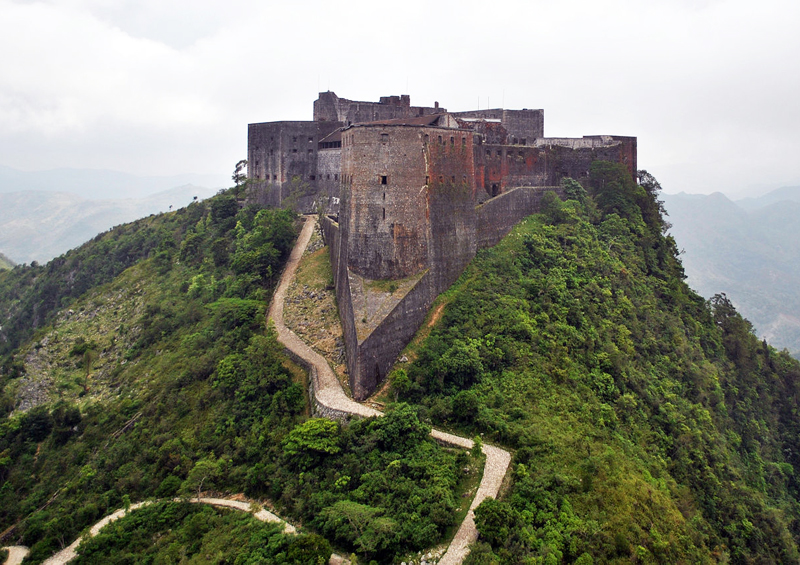
Citadelle Henry
Even before you reach it, the statistics about the Citadelle Henry demand that you be impressed: on top of a mountain 900m above sea level, 14 years to build with the labour of 20,000 people, and with walls 4m thick and 40m high. By some way the biggest fort in the Caribbean, it could hold a garrison of 5,000 people for a year, and yet it never saw its guns fired in conflict.
Visitors get their first glimpse of the Citadelle soon after leaving the village of Choiseul. The landscape suddenly opens up and there it sits above you, its massive scale designed to humble anyone approaching. The sharp wedge of its forward bastion sits high out of the vegetation, ‘the prow of a ship breasting a green wave’, in the words of one observer, but cleverly shaped to shield the bulk of the fort from prevailing storms coming from the coast.
Construction began in 1804, when Dessalines ordered the fortification of Haiti against future invasion. Larger than anything previously constructed, it was to be a final redoubt and seat of power in the north. Its radical design mixes up elements of the most cutting-edge military architecture of the time, though the names of its architects have been lost. The surrounding slopes were cultivated with food crops, protected under the cover of the Citadelle’s cannons, while the roofs were designed to capture water to feed the huge cisterns. Anyone attempting to lay siege here would surely have their work cut out.
On the north side of the courtyard is the Governor’s Palace, which is sometimes opened for exhibitions. A more permanent museum is to the right of the palace, below the Royal Battery. It has a small display of period artefacts, and showroom for an excellent 20-minute documentary (in English and French) about Henry Christophe.
From here climb up to the southeast-facing Princess’s Battery, for the most spectacular views the Citadelle can offer. From here you can see as far as Cap-Haïtien, and Christophe could look out with his spyglass to observe what ships were arriving in port. The whole of the Plaine du Nord is laid out before you, with the ranks of the Massif du Nord queuing up behind. When the clouds close in as they quickly can, you can feel isolated from the whole world. On every side there are some frighteningly sheer drops. It’s at this point that guides often tell the story of Christophe demonstrating the fanatical loyalty of his soldiers by ordering an entire company to march off the walls. It’s apocryphal, but you can well imagine the messy end – be thankful for the recently installed safety rails.
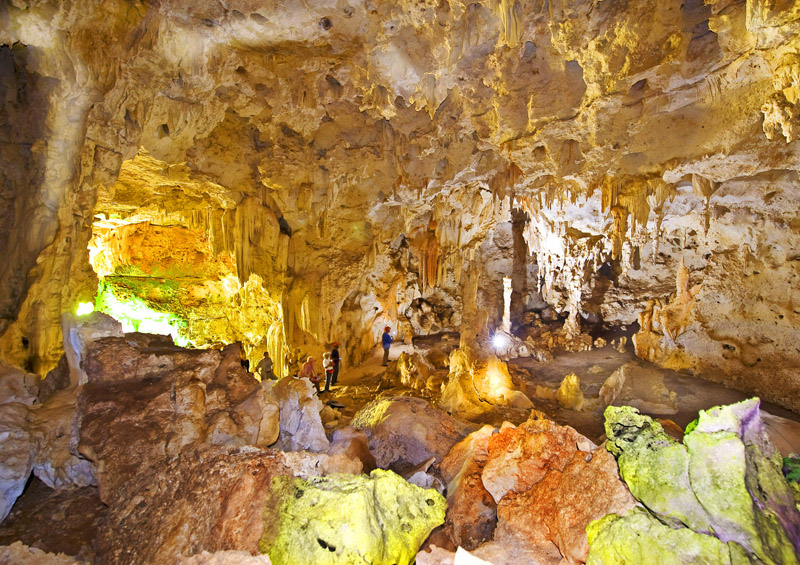
Grotte Marie Jeanne
The Marie Jeanne Cave (Grotte Marie Jeanne) is the largest cave system in Haiti, and one of the largest in the entire Caribbean. Located on a hill 20 minutes’ walk above Port-à-Piment, its galleries extend 4km below the surface.
The cave entrance is kept locked. To arrange a visit, call local guide Jean-Baptiste Eliovil (tel: 3638 2292/3782 3275 ), who helped map the cave with a speleological survey team from West Kentucky University. He can provide hard hats, but bring your own torches.
At the gate, there’s an impressive information board with a map and caving safety information in multiple languages. Metal steps lead down into the cave. The entrance was revealed by the collapse of the ceiling of a central gallery, now long overgrown with trees. Three cave galleries lead off this bowl. The first you’re taken to is the most open of the three. The floor is covered in bat guano, while roots extend into the mouth – all rich environments for cave fauna. Most notable are the impressively large Amblypigids (whip spiders, or whip scorpions), with wiry legs that extend up to 40cm from their bodies. Their mandibles look scary, but arachnophobes should take heart that they are in fact quite harmless.
The most impressive of the three galleries is full of beautiful formations, each with its own name. The pachyderm-like ‘Elephant’ has a beautiful quartz glint, while the twin stalagmites of the ‘Two Candles’ tower over you at 3m high. Near the top of the gallery is a narrow chamber with overhead ‘cathedral bells’, and the ‘robes of Marie-Jeanne’ hanging down in smooth stony folds.
The final gallery is the deepest and has its own metal staircase descending into the mouth. Near the entrance there’s a small reflecting pool contained by a travertine dam. Casual visitors will probably be happy with this, but for avid spelunkers there’s the potential to explore much further – the passages from here lead deep into the hill.
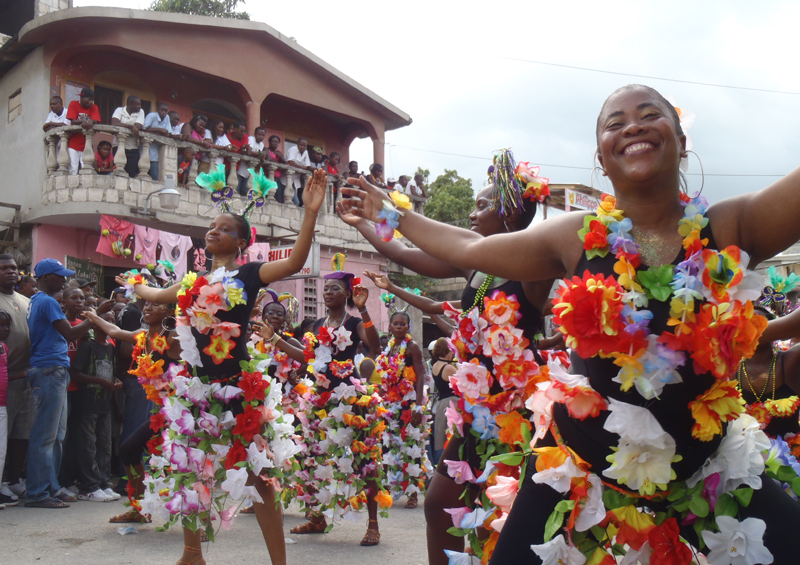
Jacmel is probably the most visited town outside Port-au-Prince for foreigners. It’s an easy sell – a renowned centre for arts and handicrafts, with some great architecture and easy access to some fine beaches. It’s also just a couple of hours’ drive from the capital on a scenic road over the mountains, and every February half of Haiti seems to descend for Jacmel’s famous Carnival, a celebration that easily rivals that of Port-au-Prince. Jacmel is the sort of laid-back Caribbean town that it’s hard not to be taken with.
Jacmel has always attracted tourists, but recent investments have seen it really starting to show off its best face. There’s a new boardwalk, tourist centre, and an arts programme that has seen bright public mosaics spring up across the town. The restoration of the historic heart of Jacmel, on the drawing board since before the earthquake, is finally underway, with local and national authorities working in tandem. If this regeneration continues, Jacmel’s place as a tourist jewel – not just for Haiti but for the Caribbean – seems increasingly assured.
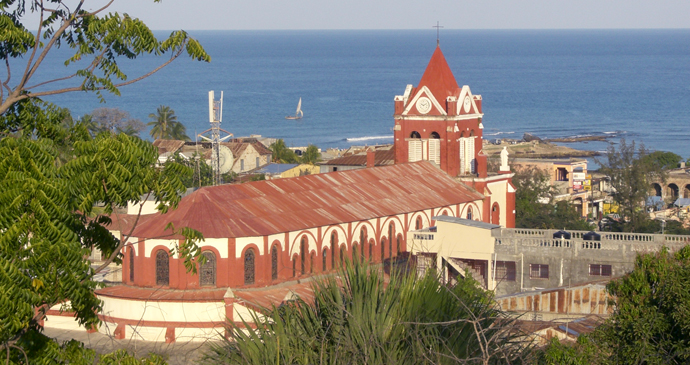
Jérémie is one of those places in Haiti that feels like a long way from anywhere. Relatively few people seem to make it here, which is a shame, because it’s a charming and relaxed little city, smack in the middle of the greenest and lushest corner of the country.
Self-styled as the ‘City of Poets’, Jérémie is the base for wider discovery of the Grand Anse, with towns such as Dame Marie and Abricots to visit, and beautiful beaches to have pretty much to yourself.
The surrounding fertile mountains produce avocados, coffee, cacao and a dozen other crops. Jérémie is also famous for komparet , a deliciously heavy gingercake-bread.
Jérémie sits next to the Grand Anse River – the views in the morning are particularly lovely when the mist seems to smoke off the valley. Fishermen stand waist-high with throw nets to catch fish, particularly the tiny anchovy-like piskit, which swarm in great numbers several times a year. You’ll frequently also see long bamboo rafts called pipirit (after the trilling song of the tropical kingbird), which villagers upstream build in a day to bring their produce to market.
Môle Saint-Nicholas
Getting to Môle Saint-Nicholas can feel like getting to the end of Haiti. Unless you’re flying in on a private plane, you’ll have endured some of the bumpiest roads in the country and its most arid landscapes, seemingly populated by little more than cactus, agave and a few scrubby trees. It’s ironic, because in some ways, the town could be called the start of Haiti: it was here, on 6 December 1492, that Christopher Columbus first made landfall in the country.
Môle Saint-Nicholas sits in a large bay enclosed by a narrow peninsula. The land is particularly barren and littered with fossils – this part of Haiti was formed by marine uplift of ancient coral terraces, and there are hundreds of caves between here and Jean Rabel that are only now beginning to be surveyed by speleologists. There’s little agriculture here, and for those not involved in fishing, charcoal production and export to the capital is an economic mainstay.
For a town so far out of the way, Môle Saint-Nicholas punches well above its weight in terms of reasons to visit. It has a fabulous beach that offers great snorkelling, and its past has bequeathed it a good selection of colonial forts. But better yet, the municipality seem to be trying very hard to develop tourism in the area, and information boards at the different historical sites. If Môle Saint-Nicholas was close to Port-au-Prince, it would be a popular weekend destination. As it is, those making it here can get a real sense of discovering an unknown corner of the country.
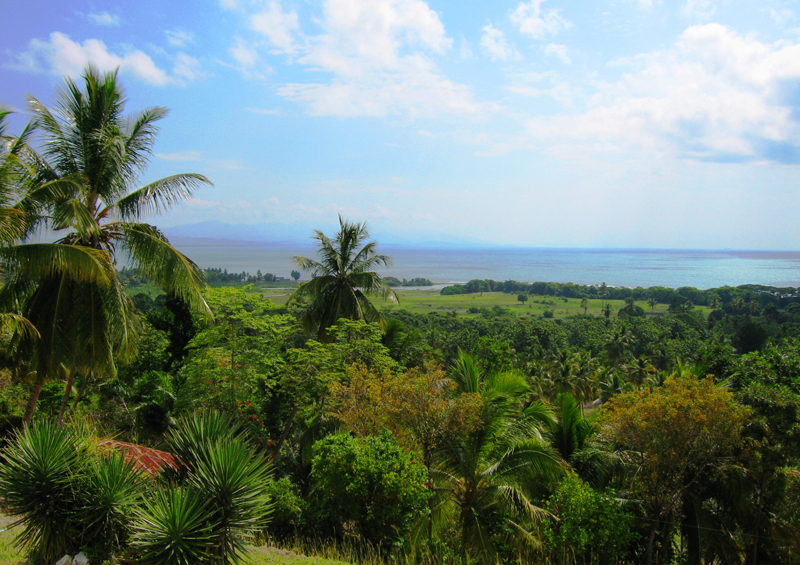
Parc Nationale la Visite
Hiking across Parc National la Visite has to be one of the most exhilarating forms of exercise that Haiti can offer, and if your time in the country has involved spending a lot of time stuck in Port-au-Prince’s traffic, then the escape to the mountains is simply divine. Most people choose to trek from Furcy to Seguin in the heart of the national park. It’s a long half-day according to your fitness levels, and there’s accommodation at the end of it. From Seguin, you can stay and explore on foot, retrace your steps to Furcy, or continue down the mountains to finish eventually in Jacmel.
It’s best to start early from Furcy to avoid too much hiking in the heat of the day, as the sun is a lot stronger at this altitude. The path from Carrefour Badyo has uninterrupted views out across the Massif de la Selle. The terrain here is largely denuded of trees, but wherever the slopes give any sort of purchase, they’ve been intensively terraced. The red soil might look dry and dusty but it is incredibly fertile. As the path bends around the ridges, you’ll encounter a continuous stream of people walking, particularly women carrying incredible loads of produce on their heads to take to market. It’s tough work, and there’s virtually no shade. Bring ample water, but also remember that clouds can roll in at any time, shrouding the views in mist and sending the temperature plummeting.
The path to Seguin is almost entirely uphill, but the views are constantly rewarding. As you near Seguin, the land begins to level out somewhat and trees start to reappear. This is the pine forest at the heart of the national park. Growing among the trees are huge agave plants, and ferns that thrive on the cooler, damper atmosphere here.
Swathes of the pine forest are fenced to prevent cutting for charcoal and grazing of livestock. Most of the forest is actually less than 100 years old, as it was commercially logged throughout the 20th century. The park was gazetted in 1983 and covers 30km 2 . It’s an important watershed and is rich in birdlife – twitchers could easily spend a day or more here. There’s great potential in the area for mountain biking, too. While portions of the route from Furcy are so rough as to demand you dismount and push, the area around Seguin has endless ribbons of single track and walking paths that should be enjoyable to even novice riders, with plenty of trails for the more dedicated. There’s a lovely walk up to Rivière Blanche, with a tumbling waterfall.
As you descend from the auberge to Seguin proper, the plateau is littered with fields of weird rock formations jutting out from the ground. Made of limestone karst weathered into jagged shapes, their local name kraze dan (broken teeth) seems entirely appropriate. Once the early-morning mist burns off, the views stretch out to the Caribbean Sea.
It’s all downhill from here. At Seguin you can find moto-taxis to take you down to the coast, or it’s another half-day’s walk. The path is cobbled and broken in some places, the remains of the old logging road built by the Americans in the 1920s. As you descend further, the landscape becomes a little more lush, until you eventually pop out at Savanne de Bois, and then Marigot – small towns that were once clearing houses for coffee merchants. Marigot sits on the main road to Jacmel, 30 minutes away by taptap.
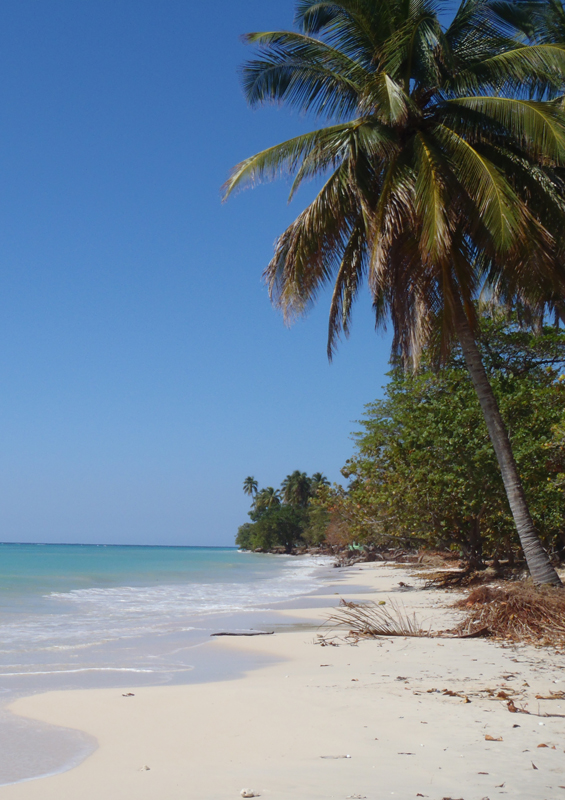
( Photo: A stunning stretch of white sand on the beach at Port Salut © Paul Clammer )
In recent years, Port Salut has become the place for weekend breaks from Port-au-Prince. One look at the long stretch of palm-fringed white sand and it’s easy to see why. Hotels seem to be springing up all along the coast to satisfy demand – but since this is Haiti, there’s still some way to go before things reach the crush of many other Caribbean beach destinations. Come during the week and you can still have the place pretty much to yourself.
Port Salut is neatly paved, and strung quite some way along the coast. The part most people are interested in is the beach at Pointe Sable. All your favourite Caribbean holiday clichés are here to be fulfilled – miles of clean white sand lapped by a shining blue sea, the occasional beach bar serving grilled fish, with the whole thing fringed with coconut palms. Pointe Sable is on the western edge of Port Salut – there’s access via a slip-road ( vehicle entrance 50HTG ).
Most people will be rightly content with kicking back and spending their time here doing nothing more energetic than ordering another rum sour. If you want something a little more active, Cascade Touyac is a small but pretty waterfall about half an hour’s walk inland from near the turning for Pointe Sable – anyone will be able to direct you. It’s possible to swim in the pool beneath the 10m-high falls. With a vehicle, an ideal day trip is to Port-à-Piment, for a visit to the stunning Grotte Marie Jeanne.
A longer drive on a rougher road up into the hills would take you through the tiny hamlet of Douyon. It’s a poor and very dry area, but when you approach the village, a gleaming new road appears as if by magic. Douyon was the home village of Jean-Bertrand Aristide.
If you carry on driving for another 5km or so, the road runs along a high ridge where, in a couple of places, it’s possible to look north and south and see the sea on both sides of the southern peninsula – spectacular.
Port Salut’s fête patronale is held on 4 August. Bullfights are held on Saturdays throughout the year, in the fields behind the police commissariat. It’s not a bloody man-versus-bull competition, but a locked-horns pushing contest between bulls. It’s a sport peculiar to the town, with plenty of betting on the side among spectators.
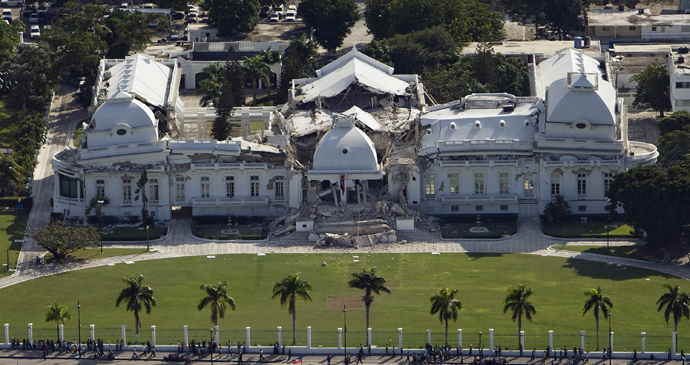
Port-au-Prince
Haiti’s buzzing capital is uncompromising and irrepressible. As the economic, political and cultural hub of the country, it ceaselessly sucks in migrants from across the country – when people say that the ‘Republic of Port-au-Prince’ is a completely separate country to the rest of Haiti, they’re only half-joking.
Perhaps two million people live in the greater metropolitan area, squeezed in between the coastal plains and the high slopes of the mountains that rise above them. Designed for a population a quarter of its size, Port-au-Prince’s infrastructure creaks and groans under the pressure, a state of affairs that has only grown since swathes of the city crumbled in the 2010 earthquake . Rebuilding has been slow and the scars are visible, but contrary to the expectations of many first-time visitors, the city is not one giant rubble pile.
Far from it. Port-au-Prince’s spirit is very much alive. It’s a sweaty and noisy place, its streets clogged with street vendors and traffic jams, but it’s also a place of lively music, vibrant art and great restaurants, of impromptu soccer games watched with a cold beer from a street vendor, church singing, and impeccably uniformed school children streaming to class every morning. The concrete-block houses of the developing world sit cheek by jowl with fancy ‘gingerbread’ houses, while the city remains surprisingly green given its uncontrolled development – don’t be surprised if you catch sight of a flock of parrots winging their way between mango trees. In all this, perhaps the jokers are right after all – Port-au-Prince is Haiti, in all its glory and contradictions, and a mile away from the dangerous and chaotic reputation that swirls around it.
Many visitors to Port-au-Prince tend to divide their time between either downtown (‘la Ville’) or up the hill in Pétionville. The majority of sights are found downtown, while Pétionville has a better variety of eating options and shops. Choices for accommodation are split fairly evenly between them.
Related titles
For more information, see our guide to Haiti :
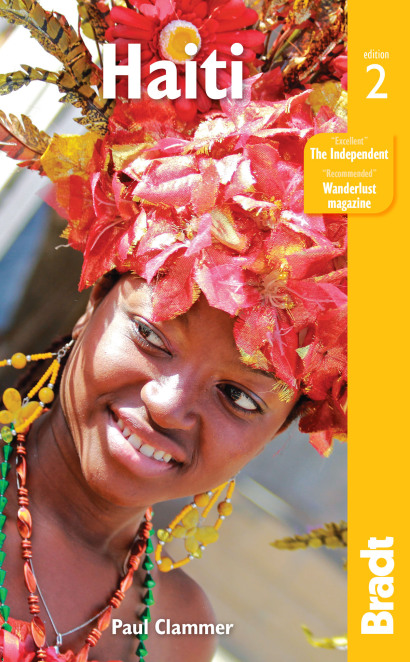
Related articles
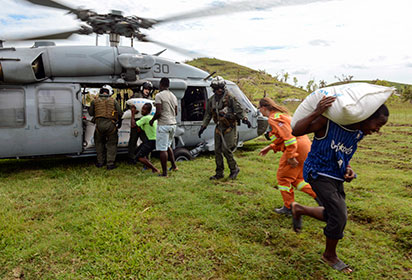
Hurricane Matthew
Author Paul Clammer discusses the situation in Haiti after the south coast was hit by Hurricane Matthew.
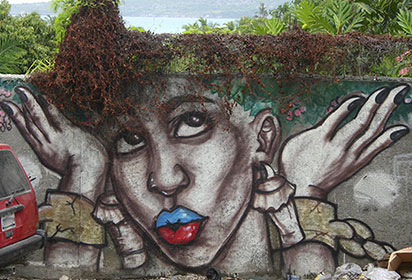
Haiti: artistic inspiration
Seven arts and crafts to keep your eye out for in Haiti.
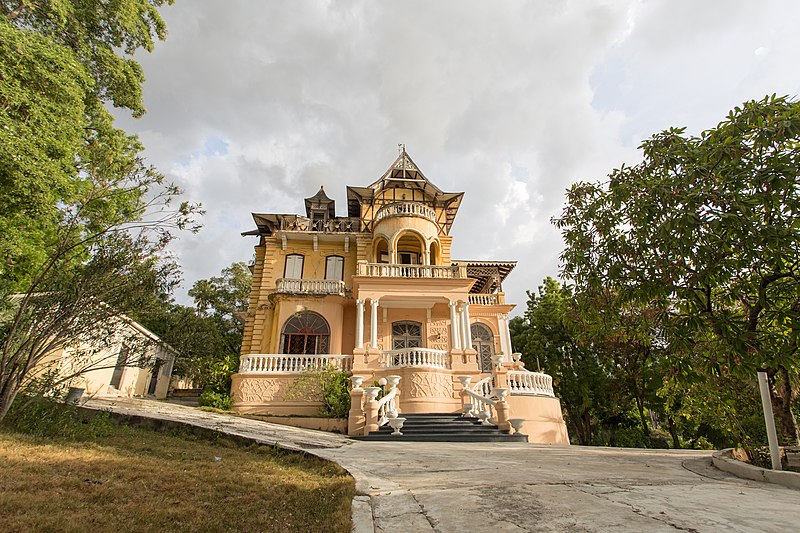
The gingerbread houses of Port-au-Prince
With their steep metal roofs, wide balconies and fine latticework, Haiti’s gingerbread houses are hard to miss.
latest in US News

Barack Obama pays tribute to Biden at DNC just weeks after...

Michelle Obama tells Dems to 'do something' as time runs low on...

Doug Emhoff offers praise for Kamala Harris' 'cackle' during DNC...

Kamala Harris vows to 'put in the hard woke' in verbal slip as...

Speaker Johnson slams Biden admin for 'stunning' IG report on...

Hulk Hogan asks bar crowd if he should 'body slam' Kamala Harris,...

Chuck Schumer calls election a choice between 'dark night' and...

Anti-Israel protesters clash with police outside Israel's Chicago...
Son desperate for answers after mom died suddenly on vodou retreat: ‘something sinister happened’.
A North Carolina woman died under mysterious circumstances on a Vodou retreat in Haiti — and her family is demanding answers from the group’s leaders.
Dana Jackson, 51, traveled to Haiti on July 1 with a group that she met through the Vodou community, her son, Timothy Jackson, told USA Today .
Jackson had been practicing Vodou for a few years, and wanted to become a Manbo priestess, a female ritual specialist, Timothy explained.
“Four years ago, my mom started to do a little bit of research on the African traditional spiritual belief systems and Vodou was a part of that,” he said.

“She had kind of been on this path of just kind of doing research and practicing, or at least, just doing her due diligence as far as research is concerned.”
Timothy was nervous about his mom’s trip, but was comforted by the fact that she knew the group she was traveling with.
“The people that she went down there with, their name is Sosyete and I believe that that means society in the Turkish language and Nago,” Timothy said.
“These weren’t strangers that she went down there with. These are people that she’s built a relationship with.”
During part of the Vodou ceremony, Jackson was not allowed to contact the outside world.
Timothy said he heard from her on July 13 — 13 days before she was supposed to return to the US.
“If you do any research about that part of the ceremony, even just on Google, it’ll tell you, that’s very sacred and things of that nature,” Timothy told USA Today.
“So she sent me one last message on the 13th, and she said, ‘We will talk on the 21st going to church tomorrow.‘”
When the 21st finally arrived, Timothy messaged Jackson on WhatsApp, but never heard back, he said.
“I woke up. I’m not gonna lie, I was in a little bit of a panic, because I felt like by now, she at least would have responded to my text,” the concerned son said of the first 24 hours that he could not reach his mom.

On the evening of July 22, Timothy’s grandmother broke the news that his mom had died in Haiti.
“The way she told me was, ‘Your mom’s not coming back from Haiti,’” Timothy recalled.
“I called her back. I asked her, what did she mean? She said, ‘She’s not coming back from Haiti. She passed away.’ I hung up the phone. I called her again.”
When Timothy reached out to one of the leaders of the Vodou group, the first thing they asked him was how much he already knew, he claimed.
“To be completely honest with you, my initial thought was my mom went down to Haiti, they did this last piece of the ceremony, and something sinister happened,” Timothy admitted to USA Today.

According to the person Timothy spoke with, Jackson became ill during the ceremony and fainted.
When she came to, she thought she was in Virginia.
Jackson and her family had not lived in Virginia for over a year, Timothy noted.
The group claimed that they brought Jackson to the hospital, where she had seizures and then suffered a heart attack and a stroke.
“That was the initial story,” Timothy said.
“They said that my mom didn’t bring her medicine. So there was a red flag, because what medicine are you guys talking about? it sounds like they were trying to perpetuate a story.”

As of this week, Timothy also had no idea where his mother’s body was — even though the group promised him an update by Aug. 16.
“I haven’t heard anything, he lamented.
“I don’t even think the US Embassy got involved, or even received the necessary paperwork until about four days ago.”
The US Embassy in Port-au-Prince did not immediately respond to The Post’s request for a comment on Jackson’s death.
Start your day with all you need to know
Morning Report delivers the latest news, videos, photos and more.
Thanks for signing up!
Please provide a valid email address.
By clicking above you agree to the Terms of Use and Privacy Policy .
Never miss a story.
As of Tuesday morning, a GoFundMe for Dana Jackson’s funeral and related costs had raised over $11,300 of its $50,000 goal.
Her family is also hoping to have an autopsy performed to determine her official cause of death, Timothy Jackson said.
“We don’t know what happened in the last nine days, but whatever happened, my mom did not go to Haiti not to come back to the United States,” he insisted.
Haiti is currently under a Level 4 travel warning by the US State Department.
As of July 2023, all non-emergency government personnel have been on ordered departure, meaning that there are a reduced number of experts available to help Americans who may run into trouble there.

Advertisement

Haiti Situation Report #6 - 19 August 2024

Resource date: Aug 2024
Author: UNFPA Haiti
Ongoing gang violence continues to drive displacement in Haiti. Houses have been burned, there is an increase in kidnappings and robberies, as well as a continuous and significant increase in the number of reported gender-based violence (GBV) cases.
The recent attacks in Ganthier commune by armed gangs displaced over 6,000 people. The situation for displaced women and girls remains desperate as they struggle to secure even the most basic necessities. They urgently need protection services, which is a priority of the humanitarian response, and access to reproductive health services, shelter, food, water, sanitation and hygiene facilities.
UNFPA has been responding to the crisis with a specific focus on preventing and responding to violence against women and girls, and providing sexual and reproductive health (SRH) services. We continue to deploy mobile teams and set up temporary women’s safe spaces in displacement sites to address the gaps in psychosocial support and case management services.
So far UNFPA has reached 3,029 people with GBV prevention, mitigation and response activities; reached 1,237 people with SRH services; and distributed 1,610 dignity kits to displaced women and girls. UNFPA have also supported 13 health facilities, where 268 deliveries, including 53 cesarean sections, were supported.
UNFPA is appealing for 28 million USD to strengthen and expand access to life-saving SRH and GBV services and supplies for women and girls in Haiti. As of June 2024, only 5.4 million USD (19%) has been funded, leaving a gap of 22.6 million USD (81%).
Related topics
- Humanitarian Emergencies
Related Content

Health and humanitarian workers face record violence: Here are 5 reasons the…
Situation Report
UNFPA Sudan Emergency Situation Report #15 - 11 August 2024

Mothers and daughters of Haiti, living in the grip of violence
We use cookies and other identifiers to help improve your online experience. By using our website you agree to this, see our cookie policy
Tropical Storm Ernesto: Track where the storm is heading in the latest models

Tropical Storm Ernesto formed Monday as it moved toward the Caribbean islands and the forecast suggest Puerto Rico and the Virgin Islands could experience tropical storm conditions beginning Tuesday.
You can track the storm's path with the latest maps and models below and follow along with USA TODAY's coverage of Tropical Storm Ernesto as the fifth named storm of the 2024 Atlantic hurricane season moves through the Caribbean.
The storm is expected to bring heavy rain and cause flash floods and mudslides but the mainland U.S. could be largely spared from the storm, according to forecasts.
Where is Ernesto heading?
The National Hurricane Center's 11 p.m. ET update Monday indicated that Ernesto could bring tropical storm conditions to parts of the Leeward Islands by early Tuesday, and the Virgin Islands and Puerto Rico later in the day.
A tropical storm warning was issued in the area late Monday evening.
Tropical storm Ernesto path tracker
If the map above is not loading on your screen, click here .
Tropical Storm Ernesto Spaghetti Models
Illustrations include an array of forecast tools and models, and not all are created equal. The hurricane center uses only the top four or five highest-performing models to help make its forecasts.
Watch CBS News
Maps show Tropical Storm Ernesto's path and forecast as it moves away from Bermuda
By Emily Mae Czachor , Kerry Breen
Updated on: August 17, 2024 / 11:21 PM EDT / CBS News
Tropical Storm Ernesto was moving away from Bermuda Saturday after making landfall on the island as a Category 1 hurricane.
The British territory remained under a tropical storm warning Saturday evening after getting hit with heavy rains and powerful winds, the Miami-based National Hurricane Center reported in its latest advisory.
As of 11 p.m. EDT, Ernesto was centered about 140 miles northeast of Bermuda and was inching north-northeast at 6 miles per hour, with maximum sustained winds of 70 mph, the NHC said, a significant weakening from the 100 mph it reached Friday when it was at Category 2 hurricane status. Forecasters said Ernesto could regain hurricane strength Sunday, but would likely weaken before passing near southeastern Newfoundland late Monday.

Swells fueled by Ernesto were forecast to cause "life-threatening surf and rip current conditions" on the East Coast of the U.S. and Atlantic Canada over the next couple of days, the hurricane center said.
Ernesto had strengthened from a tropical storm into a hurricane Wednesday morning while moving north of Puerto Rico, as forecasters had predicted. The hurricane center upgraded Ernesto once its maximum sustained winds reached 75 mph.
Ernesto knocked out power to about 72% of customers in Bermuda Saturday, according to utility provider Belco. The island was expected to see rain totals of up to 9 inches. Although the storm was moving away from Bermuda, tropical storm conditions were expected to persist for the island into late Saturday night, the hurricane center said.
Before making landfall in Bermuda, Ernesto brought heavy flooding to Puerto Rico and the Virgin Islands earlier in the week while gaining strength as it went through the Caribbean. Torrential downpours blanketed parts of Puerto Rico for much of Wednesday, dumping nearly 10 inches of rain, swelling rivers and flooding roads.
In the process, Ernesto knocked out power to about 750,000 homes and businesses in Puerto Rico. Puerto Rico's electricity provider, LUMA Energy, said about 101,000 customers still didn't have power as of Saturday night, a significant drop from when service outages peaked on Wednesday afternoon, the provider said .

According to the utility tracker PowerOutage.us, just over 3,400 customers in the U.S. Virgin Islands had no electricity Saturday night, down from a peak of about 46,000 on Wednesday.
Ernesto became the fifth named storm of the 2024 Atlantic hurricane season when it formed Monday on a fast-moving path to the Caribbean. The storm came on the heels of Hurricane Debby , which lashed parts of the southeastern United States last week with disastrous flooding and severe weather that ultimately touched much of the East Coast. Ernesto isn't expected to strike the U.S. mainland, the hurricane center said.

Editor's Note: An earlier version of this story reported 975,000 customers had lost power in Puerto Rico, but that was the number of customers who still had power, according to Puerto Rico's electricity provider.
- Virgin Islands
- Tropical Storm
- Severe Weather
- Puerto Rico
- National Hurricane Center
Emily Mae Czachor is a reporter and news editor at CBSNews.com. She covers breaking news, often focusing on crime and extreme weather. Emily Mae has previously written for outlets including the Los Angeles Times, BuzzFeed and Newsweek.
More from CBS News

2 Americans, U.K. tech mogul among 6 missing after yacht sinks off Sicily

World's oldest person, U.S.-born Spanish woman, dies at 117, family says

Mpox is "not the new COVID," World Health Organization says

Ocasio-Cortez urges Democrats to "choose a new path" in DNC speech
Advertisement
Supported by
Late-Summer Travel Plans? You Might Want to Put On a Mask.
With U.S. Covid-19 cases at very high levels and new vaccines still several weeks away, we asked experts for their advice on when and where to wear a mask.
- Share full article

By Ceylan Yeğinsu and Dani Blum
It is the height of the summer travel season: Airplanes and cruises are packed, hotels are booked, and travelers are crowding theme parks and attractions. Yet throughout the United States, Covid-19 is currently circulating at very high levels.
During the peak of the pandemic, masks were ubiquitous in hotels, airports and other public places. They were required to fly , and many travelers donned them elsewhere to help reduce the transmission of the deadly coronavirus. Since the end of the mandate, and as travel has returned to or surpassed prepandemic levels , most travelers have abandoned preventive measures, particularly masks.
With updated vaccines not available until the fall , experts are reminding travelers about the benefits of masking, particularly in airports and poorly ventilated indoor environments.
Here’s what you need to know about masks and your travel plans.
What’s going on with Covid right now?
The number of reported cases appears to be climbing both in the United States and abroad. In the United States, there are “very high” levels of the virus in wastewater samples nationwide, according to the Centers for Disease Control and Prevention. The World Health Organization reported that cases around the globe rose by 30 percent from June 24 to July 21, compared with the previous 28 days. Put simply: There’s a lot of Covid out there.
How effective are masks? What is the best mask to use?
People who want to minimize their risk of respiratory illnesses like Covid (along with colds and the flu) should wear a mask while traveling, experts say. Even if you’re the only person wearing one on a train or at an airport, a mask continues to offer protection — provided you wear it properly, which means covering both your nose and your mouth.
“It does not eliminate the risk, but it substantially reduces the risk of exposure,” said Dr. Ziyad Al-Aly, the chief of research and development at the Veterans Affairs St. Louis Healthcare System, in Missouri. Aim for a high-quality mask, like an N95, a KN95 or a KF94 , all of which filter out the overwhelming majority of virus particles and are far more effective at reducing the chance of a Covid infection than cloth or surgical versions. Masks should fit snugly on your face.
“If you have symptoms and you have any question about it, I would wear a mask, just to protect other people,” said Dr. Marc Sala, a co-director of the Northwestern Medicine Comprehensive Covid-19 Center in Chicago. Common symptoms of Covid include coughing, fever, sneezing, congestion, headaches, sore muscles, fatigue and gastrointestinal issues . Those who are asymptomatic but have been exposed to Covid may also consider masking.
If you have tested positive during a trip but cannot delay traveling, you should wear a mask whenever you are around other people, Dr. Sala said.
Where should travelers wear a mask?
The C.D.C. urges travelers to “consider wearing masks in crowded or poorly ventilated indoor areas, including on public transportation and in transportation hubs.”
Dr. Al-Aly recommended carrying around a few masks in your bag or pockets, so that you have them on hand when you enter a crowded indoor space. “Maintain situational awareness,” he said. If you’re in a crowded indoor space, like a train station or busy museum, you may want to put on a mask. Although airplanes filter and circulate air , there is still a risk that comes with being in close quarters with large groups of people, Dr. Al-Aly said.
What is the travel industry’s stance on masking?
The mask mandate on airplanes became a heated issue at the height of the pandemic, with travel representatives arguing that it was harming the recovery of a hard-hit industry.
The U.S. Travel Association , a trade group that promotes travel to and within the country, believes mask wearing should be up to individual travelers. It welcomed the lifting of the mask mandate on U.S. transportation in 2022, calling it “a step further toward the endemic management of Covid.” That stance has not changed.
The International Air Transportation Association , another industry group, argues that aircraft are designed to reduce the transmission of viruses on board. “Cabin air is refreshed every two to three minutes — much more frequently than most other indoor environments,” the agency said in a statement. “It is also filtered and flows from ceiling to floor, all of which helps to maintain a healthy onboard environment.”
Passengers always have a choice to wear masks, the statement continued, and many airlines provide them upon request.
Major cruise lines do not require guests to wear masks, but passengers are required to undergo a health screening before boarding a ship, and some companies, including Carnival Cruise Line, encourage passengers to be up-to-date with Covid vaccines.
Follow New York Times Travel on Instagram and sign up for our weekly Travel Dispatch newsletter to get expert tips on traveling smarter and inspiration for your next vacation. Dreaming up a future getaway or just armchair traveling? Check out our 52 Places to Go in 2024 .
Ceylan Yeğinsu is a travel reporter for The Times who frequently writes about the cruise industry and Europe, where she is based. More about Ceylan Yeğinsu
Dani Blum is a health reporter for The Times. More about Dani Blum

Haiti fires most staff in its Suriname consulate over possible human-trafficking ring
H aiti is cleaning house in its diplomatic consulate in Suriname, the Dutch-speaking country on the northeast coast of South America that has become a way station for Haitians seeking to escape their country’s gang violence.
All but one of the consulate’s Haitian diplomats have been recalled to Port-au-Prince and all 12 of the country’s locally hired contractors were fired after French authorities raised concerns that diplomatic staff could possibly be complicit in Suriname being used as a way station for Haitian migrants seeking to enter French territories.
Haiti Foreign Minister Dominique Dupuy, who immediately launched an internal investigation, alerted French and U.S. officials of her decision last week, multiple sources confirmed to the Miami Herald.
Late last month French officials contacted the Haitian government about their suspicions after dozens of Haitians arrived in French Guiana via Suriname asking for asylum. An investigation revealed that there had been at least one charter flight on July 10 from Port-au-Prince into the Suriname capital of Paramaribo.
The scheme involves Haitians paying upwards of $4,000 to a travel agency to fly into the South American country and then board buses that either take them to French Guiana across a river, or to Brazil, where they make the 7,000 miles trek north to the U.S.-Mexico border through the perilous Darien Gap between Colombia and Panama.
The ongoing investigation also revealed that among those being trafficked are under-aged children who arrive in Suriname on fake Haitian child-welfare agency documents claiming they are unaccompanied minors reuniting with families in Suriname. Such a scheme, one source said, could not happen without the complicity of diplomatic staff and possibly others in both Haiti, where all flights must be approved by the Office of National Civil Aviation, and in Suriname.
The revelations about Suriname, which is increasingly becoming a popular transit country for Haitians and other migrants, comes as Paris and Washington seek to halt the illegal movement of migrants through third countries to reach their borders.
Last year, the Biden administration announced a crack down on migrants flying expensive charter planes from Haiti, Cuba and elsewhere to reach Nicaragua, where they then proceed on foot and by buses to the U.S.- Mexico border. Haitians were paying as much as $4,000 for a one-way ticket from Port-au-Prince to Managua. By the time the administration flagged the scheme, which forced Haiti to suspend the flights, more than 30,000 Haitians had made the journey on at least 268 flights.
Accusing Nicaraguan leader Daniel Ortega of “cynically profiting ” from such flights, the administration earlier this year imposed sanctions on several Nicaragua-based entities and issued alerts warning charter companies and airlines that the Central American nation was “weaponizing” migration. The U.S. has not ruled out sanctioning airlines if they are involved.
The latest scheme revolves around two companies, SAYA Travel agency in Hait, and Fly All Ways, a Suriname-based regional airline that has been operating since 2016. The first arranges for charter trips, while the second allegedly arranges the transport for people once in Suriname. A flight is currently scheduled for Friday.
In its 2024 Trafficking In Persons report for Suriname, the U.S. State Department said that “traffickers target the increasing influx of asylum-seekers and migrants, many of whom lack legal status and protection, into and through Suriname,” saying the migrants are coming from Haiti, Venezuela, Brazil, Cuba, the Dominican Republic, Guyana and the People’s Republic of Congo, among others.
“Asylum-seekers and migrant women and girls are especially at risk for sex trafficking in Suriname, including in brothels, massage parlors, hair salons, and illegal gold mining camps in Suriname’s interior,” the report said.
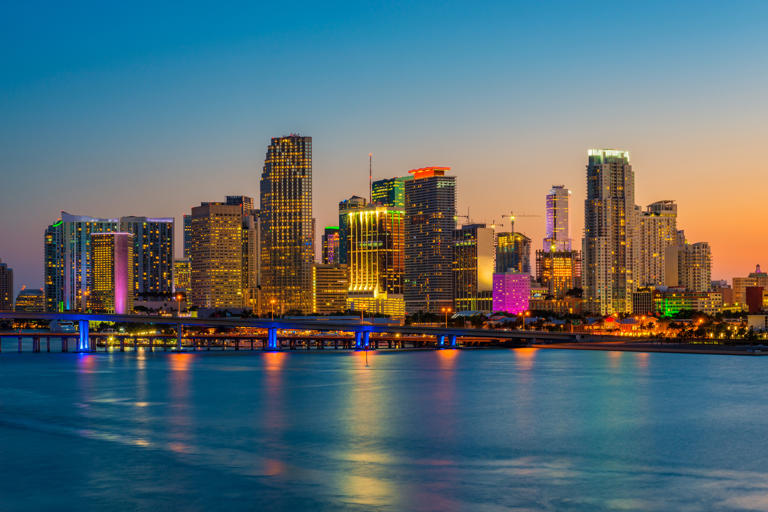
Florida's official tourism site removes 'LGBTQ Travel' section

Florida’s official tourism website quietly removed a landing page for the state’s LGBTQ-friendly travel destinations sometime in the past four months.
The website for the state’s tourism marketing corporation, VisitFlorida.com, had an “LGBTQ Travel” section that no longer exists, according to archived versions of the site viewable on the Internet Archive. The landing page previously featured blog posts and videos related to the state’s gay-friendly beaches, Pride events and LGBTQ road trip ideas.
“There’s a sense of freedom to Florida’s beaches, the warm weather and the myriad activities — a draw for people of all orientations, but especially appealing to a gay community looking for a sense of belonging and acceptance,” the landing page used to read. “Whether you’re a couple seeking a romantic getaway or a modern family searching for kid-friendly fun, here are some LGBTQ-friendly destinations for you, throughout the Sunshine State.”
The link where the LGBTQ Travel page had been (https://www.visitflorida.com/things-to-do/cultural/lgbtq/) now directs users to a general “things to do” landing page. It is unclear exactly when the landing page was removed, but it was available as recently as April 19, according to the Internet Archive. It is also unclear why Visit Florida, a nonprofit created as a public-private partnership by the Florida Legislature in 1996, removed the landing page and who was behind the decision.
The website does continue to provide travel information for destinations specific to other minority groups, including Black and Hispanic travelers.
Visit Florida did not immediately return a request for comment.
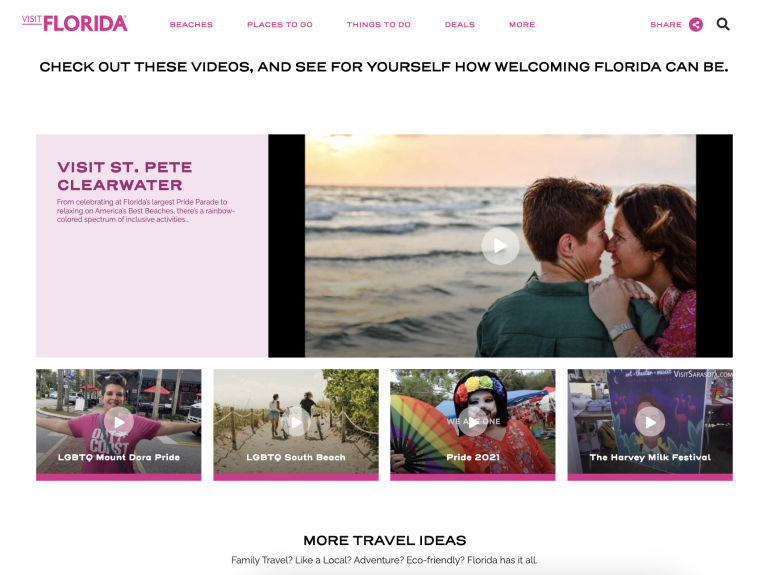
Rachel Covello runs OutCoast , a travel blog that promotes Florida as an LGBTQ-inclusive destination. Covello, a lesbian who lives in St. Petersburg, said the “LGBTQ Travel” landing page has existed on Visit Florida’s website since at least 2021. She said she first noticed that the landing page was missing last month.
“It really feels like we were just erased in a way,” Covello said.
“We want LGBT people to come here, we have really cool places to highlight and showcase,” she added.“But when the state-run platform removes any trace of us being in Florida, it sends a pretty strong message to our travelers, to our community in Florida.”
Not all references to LGBTQ people or LGBTQ-friendly places have been removed from the site. For example, if one types “LGBT” in the site’s search function, five results pop up, three of them for venues described as “LGBT Friendly.”
Maryann Ferenc, a small business owner who served as the chair of Visit Florida from 2017 to 2018, said there was a lot of LGBTQ-related travel information on the site during her time, including information about suggested itineraries and recommended beaches. She questioned whether stripping the site of its LGBTQ Travel section and other LGBTQ-related content s was a smart business move.
“To be a great tourism community, you need to be open and welcoming. That’s the basics of hospitality, right?” she said. “When I was chair, we talked about, ‘Could we be No. 1 in hospitality? How could we measure being the most hospitable state in the Union?’ This certainly wouldn’t qualify for that.”
Ferenc added that diversifying the state’s tourism industry was one of her main objectives when she led the organization.
“All of our diverse markets are important to us getting all of the business that is our fair share of the statewide, national and international tourism market,” she said. “It’s important that we have that diversity, not only because of the amount of money that will be spent by a diverse market, but by the diverse places in which that money will be spent.”
The removal of the LGBTQ Travel section from VisitFlorida.com is the latest in a yearslong effort to restrict queer history and the expression of LGBTQ identities in the state.
Since 2021, Florida has enacted legislation to limit the instruction of sexual orientation and gender identity in its public schools, to limit the ability of trans minors from accessing transition-related health care or from participating on school sports teams and to defund diversity programs at Florida colleges.
In recent years, Florida lawmakers also unsuccessfully attempted to limit drag shows, an artform that has decades-old roots in the LGBTQ community. Some of the state’s schools have also voluntarily removed or banned LGBTQ-related books or books with queer characters.
Just last week, New College of Florida tossed hundreds of books in the trash , with many of the discarded titles appearing to be related to LGBTQ issues, race and women’s rights.
Florida Gov. Ron DeSantis notably waged a yearslong legal battle with Disney , which has a massive corporate footprint in the state, after the company came out against the state’s so-called “ Don’t Say Gay ” law. Disney settled with the state this year.
Last year, the Human Rights Campaign, the nation’s largest LGBTQ advocacy group, and the statewide LGBTQ nonprofit Equality Florida issued a travel advisory detailing the risks of traveling to the state and citing “the devastating impacts of laws that are hostile to the LGBTQ community.”
A recent survey of 2,300 LGBTQ Americans by the International LGBTQ+ Travel Association (IGLTA) found that 52% of respondents indicated hesitancy or outright refusal to travel to Florida due to anti-LGBTQ legislation passed in recent years. However, about 66% of respondents also said that they would be willing to visit LGBTQ-friendly cities within states that have anti-LGBTQ laws.
In 2017, within days of former president Trump’s inauguration, his administration similarly scrubbed nearly all mentions of LGBTQ people and issues from the websites of federal agencies and the White House.
For more from NBC Out, sign up for our weekly newsletter.
Matt Lavietes is a reporter for NBC Out.
- Skip to main content
- Keyboard shortcuts for audio player
Weekend Edition Sunday
- Latest Show
Sunday Puzzle
- Corrections
Listen to the lead story from this episode.
Politics chat: The Harris-Walz campaign is gearing up for the DNC
by David Folkenflik , Asma Khalid

In this file photo, Vice President Harris speaks at an event in Manassas, Va., on Jan. 23, 2024, to campaign for abortion rights. Harris will commemorate her historic nomination in Chicago this week as Democrats hold their convention against the backdrop of a state that has become a hub for abortion access. Susan Walsh/AP hide caption
As Democrats meet in Chicago, Illinois' role in abortion access is in the spotlight
by Sarah McCammon
Ukraine's incursion into Russia may have changed the course of the war
by David Folkenflik
How Biden's debate performance snowballed into Harris becoming the new candidate
The harris-walz campaign is confusing grammar nerds everywhere.

Sunday Puzzle NPR hide caption
Sunday Puzzle: Rhyming destinations
by Will Shortz
SUNDAY PUZZLE 08182024
Appalachian authors are coming together to counter the narrative in jd vance's book, author interviews, comic novel 'how to leave the house' follows a young man on a day-long hero's quest, harris and trump zero in on the economy in campaign speeches.

Left to right: Lucero Lopez, Jasmine Perez Moreno, Josue Rodriguez, Raneem Le Roux, and Jossue Ureno pose for a portrait at The Leroy and Lucile Melcher Center for Public Broadcasting on Thursday, Aug. 1, 2024, in Houston. Joseph Bui for NPR hide caption
How growing up in the U.S. immigration system shapes how these young Americans vote
by Elena Moore , Hiba Ahmad

People stand in front of a sign featuring Democratic presidential candidate Vice President Kamala Harris and Democratic vice presidential candidate Minnesota Gov. Tim Walz at the United Center before the start of the Democratic National Convention Friday in Chicago. Joe Raedle/Getty Images hide caption
2024 Election
The dnc starts today. here’s what you need to know.
by Jeongyoon Han
The largest branch in American Judaism now ordains rabbis in interfaith marriages
by Deena Prichep
Where the law stands 30 years after a woman sued McDonald's for spilling hot coffee
The promise keepers, a 1997 evangelical men's group, is back with a new agenda.
by Elizabeth Caldwell
Movie Interviews
A documentary investigates deaths of indigenous children at canadian boarding schools.
Searching for a song you heard between stories? We've retired music buttons on these pages. Learn more here.
AAA Newsroom
Automotive, Travel, and Traffic Safety Information
Top Labor Day Travel Trends of 2024
Aaa booking data shows alaska cruises, european cities, and tourist attractions are most popular.

WASHINGTON, DC (Aug. 19, 2024) – This year’s record-breaking , blockbuster summer travel season comes to a close with many Americans exploring Alaska by cruise. According to AAA booking data, Seattle is the number one Labor Day weekend* destination, up nearly 30% from last year when it also topped the list. Anchorage and Juneau are also on the top ten list of Labor Day destinations.
“This is the time of year to go on an Alaska cruise,” said Paula Twidale, Senior Vice President of AAA Travel. “There are fewer crowds compared to earlier in the summer, and if you’re lucky, you might even catch a glimpse of fall colors! It’s no surprise Alaska cruises are sold out this Labor Day weekend.”
AAA travel experts say if you’re interested in going on an Alaska cruise next summer, the time to book is now to lock in the best rate and ensure you get the type of cabin you want.
According to AAA booking data, o verall domestic travel over Labor Day weekend is up 9% compared to last year , while the cost to travel domestically is down 2%. Other top Labor Day destinations include Orlando, New York, Boston, Las Vegas, Denver, Chicago, and San Francisco. For many families, Labor Day is the last hurrah before school begins. To make the most of those trips, AAA recommends identifying must-see sights and creating a flexible itinerary ahead of time. “ Trip Canvas is a great free resource for travelers in the planning phase,” Twidale said. “You can find free things to do in Denver or the best museums in New York City .”
Travelers taking road trips should expect to pay less for gas compared to last year. The national average over Labor Day weekend in 2023 was $3.81. In recent weeks, gas prices have remained steady, hovering around $3.50. Despite the popularity of summer road trips, overall gas demand is down as daily driving habits have changed post-pandemic, preventing pump prices from spiking. Hurricanes hitting the Gulf and affecting regional refineries could cause gas prices to go up as the peak of the season approaches in September. For drivers taking road trips in their electric vehicles, AAA now offers information on the cost of Level 2 commercial EV charging and updates that data weekly .
International travel over Labor Day weekend is down 4% compared to last year, per AAA booking numbers , while the cost to travel internationally is up 11%. Most of those travelers are heading to Europe. Eight out of the top ten international destinations booked through AAA are European cities. Travelers renting a car abroad should consider getting an International Driving Permit (IDP), which translates their driver’s license information into 10 languages. Some countries – including Italy and Spain – require it. AAA is the only entity in the U.S. authorized by the State Department to issue an IDP.
Top Labor Day Destinations
Best and Worst Times to Travel by Car over Labor Day Weekend
INRIX , a provider of transportation data and insights, says car travelers should avoid the afternoon and early evening hours of Thursday and Friday, as those times will be the most congested. Drivers should hit the road in the morning unless they’re leaving on Saturday when the best time to travel by car is in the afternoon. Travelers returning on Sunday and on Labor Day should leave as early as possible to avoid heavy traffic in the afternoon.
“Drivers should expect the most severe traffic jams before the holiday weekend as commuters mix with travelers,” said Bob Pishue, transportation analyst at INRIX. “Monitoring traffic apps, local news stations, and 511 traveler information services may help drivers navigate around congestion and reduce driver frustration this Labor Day.”
Source: INRIX
*Labor Day Weekend
AAA looked at booking data for Thursday, August 29 through Monday, September 2, and compared those numbers with booking data for that same five-day period in 2023.
About AAA
Started in 1902 by automotive enthusiasts who wanted to chart a path for better roads in America and advocate for safe mobility, AAA has transformed into one of North America’s largest membership organizations. Today, AAA delivers exceptional roadside assistance, helps travelers plan their dream vacations and adventures, offers exclusive member discounts and benefits, and provides trusted financial and insurance services – all to enhance the life journey of our 64+ million members across North America, including over 57 million in the United States. To learn more about all AAA offers or become a member, visit AAA.com.
About INRIX
Founded in 2004, INRIX pioneered intelligent mobility solutions by transforming big data from connected devices and vehicles into mobility insights. This revolutionary approach enabled INRIX to become one of the leading providers of data and analytics into how people move. By empowering cities, businesses, and people with valuable insights, INRIX is helping to make the world smarter, safer, and greener. With partners and solutions spanning across the entire mobility ecosystem, INRIX is uniquely positioned at the intersection of technology and transportation – whether it’s keeping road users safe, improving traffic signal timing to reduce delay and greenhouse gasses, optimizing last mile delivery, or helping uncover market insights. Learn more at INRIX.com.

IMAGES
COMMENTS
Haiti- Level 4: Do Not Travel. Updated to reflect the Ordered Departure of non-emergency U.S. government personnel and eligible family members for Embassy Port-au-Prince. Do not travel to Haiti due to kidnapping, crime, civil unrest, and poor health care infrastructure. On July 27, 2023, the Department of State ordered the departure of family ...
U.S. DEPARTMENT of STATE — BUREAU of CONSULAR AFFAIRS. Travel.State.Gov > Travel Advisories > Haiti Travel Advisory . Congressional Liaison; Special Issuance Agency; Legal Resources
Call us in Washington, D.C. at 1-888-407-4747 (toll-free in the United States and Canada) or 1-202-501-4444 (from all other countries) from 8:00 a.m. to 8:00 p.m., Eastern Standard Time, Monday through Friday (except U.S. federal holidays). See the State Department's travel website for the Worldwide Caution and Travel Advisories.
Travel Advisory. Do not travel to Haiti due to crime and civil unrest. There are currently widespread, violent, and unpredictable demonstrations in Port-au-Prince and elsewhere in Haiti. Due to these demonstrations, on February 14, 2019, the Department of State ordered the departure of all non-emergency U.S. personnel and their family members.
Kidnappers target both local people and foreigners, including dual citizens who live or travel in Haiti, regardless of rank or social class. Since September 2020, hundreds of Canadians and other foreign nationals have been abducted. Missionaries, aid workers and children can become victims. Most of the victims are released in exchange for ransom.
TRANSPORT & TAXIS RISK: HIGH. Transport is definitely not safe in Haiti. Upon arriving, make sure that no one is following you, as criminals have been known to watch people arriving and then following them and attacking them. The same thing applies to people withdrawing money from banks or ATMs.
Still current at: 18 August 2024 Updated: 24 July 2024 Latest update: Information on a new state of emergency in parts of Port-au-Prince ('Warnings and insurance' page).
Haiti remains poor, but it's perfectly safe for visitors to walk around the cities on foot or travel across the country to see the many cultural icons and natural wonders, either alone or with a local guide. As in any large city in the US, people visiting should take sensible precautions when in Port au Prince or Haiti's other cities.
To Stay To Eat. Since celebrating its 350th anniversary in 2020, Cap-Haïtien has become Haiti's top travel destination. As Haiti's second-largest city, it draws visitors with its rich history, world-class beaches, and UNESCO heritage sites. Join us as we take a swooping dive into the heart of the city and learn how it earned its well ...
COVID-19 Vaccine Deliveries. Since July, 2021 the United States has donated 1,086,340 safe and effective COVID-19 vaccine doses with the people of Haiti. This includes 318,240 Pfizer, 600,100 Moderna, and 168,000 J&J doses. Of the 1,086,340 vaccine doses, 94% were donated in partnership with COVAX and 6% were donated through bilateral agreements.
Level 3: Reconsider Travel: July 17, 2023: Haiti Travel Advisory : Level 4: Do Not Travel: July 27, 2023: Honduras Travel Advisory: Level 3: Reconsider Travel: July 17, 2023: ... Subscribe to get up-to-date safety and security information and help us reach you in an emergency abroad.
If your travel plans in Haiti include outdoor activities, take these steps to stay safe and healthy during your trip. Stay alert to changing weather conditions and adjust your plans if conditions become unsafe. Prepare for activities by wearing the right clothes and packing protective items, such as bug spray, sunscreen, and a basic first aid kit.
Get a VPN for traveling in Haiti. You should always use a VPN when you travel, especially when you connect to public Wi-Fi networks. Your connection will be much safer. Moreover, you will be able to access content which is typically censored in Kazakhstan. I recommend ExpressVPN - Extremely easy to use, fast and cheap.
PORT-AU-PRINCE — The U.S. Department of State issued a security alert update on Haiti on Wednesday, stating that the country "remains under a Level 4 - Do Not Travel - Travel Advisory" due to high risk and potential outbreaks of gang-led violence. The U.S. government advises American citizens against traveling to Haiti.
Support from the international community over the past 20 years has helped stabilize the prevalence of HIV in Haiti; the estimated prevalence is 2% among adults aged >15 years. Among people 15-24 years age of age, infection is disproportionately greater among women than men (2.3% vs. 1.6%).
Things to do. Day 1 - Traveling from Santo Domingo to Cap-Haïtien. Day 2 - Exploring Cap-Haïtien. Day 3 - Day trip to Citadelle la Ferrière. Day 4 - Hiking to Labadee. Day 5 - Travel from Cap-Haïtien to Port au Prince. Day 6 - Port-au-Prince. Day 7 - Mirelabais and Dominican Republic. More Information.
Climate. Haiti's tropical climate produces seasonal rainfall, although large areas of the country are semiarid. Temperatures year round range from 70°F to 90°F with humidity sometimes high along the coast. Average annual rainfall varies from nearly zero in some areas to 53 inches in Port-au-Prince.
Haiti is a Caribbean country that shares the island of Hispaniola with the Dominican Republic to its east. Though it's still recovering from a 2010 earthquake, many of Haiti's landmarks dating to the early 19th century remain intact. Haiti is a country with a revolutionary, exciting past and its future remains uncertain.
Tropical Haiti is a year-round destination, with a strong Caribbean sun and temperatures fluctuating from warm to hot. April to November is the hottest time of year, when average temperatures fluctuate just above 30˚C (86˚F). December to March are the coolest months, with the temperatures averaging around 22˚C (72˚F).
Haiti is currently under a Level 4 travel warning by the US State Department. As of July 2023, all non-emergency government personnel have been on ordered departure, meaning that there are a ...
Mr. Martelly, who served as president of Haiti from 2011 to 2016, "abused his influence to facilitate the trafficking of dangerous drugs, including cocaine, destined for the United States ...
Haiti Situation Report #6 - 19 August 2024. Resource date: Aug 2024. Author: UNFPA Haiti. EN. Ongoing gang violence continues to drive displacement in Haiti. Houses have been burned, there is an increase in kidnappings and robberies, as well as a continuous and significant increase in the number of reported gender-based violence (GBV) cases.
Where is Ernesto heading? The National Hurricane Center's 11 p.m. ET update Monday indicated that Ernesto could bring tropical storm conditions to parts of the Leeward Islands by early Tuesday ...
Kenyan police shoot outside a major hospital in Haiti's capital Port-au-Prince. 04:10 - Source: CNN Exclusive: Inside the foreign mission sent to battle Haiti's gangs
Swells fueled by Ernesto were forecast to cause "life-threatening surf and rip current conditions" on the East Coast of the U.S. and Atlantic Canada over the next couple of days, the hurricane ...
With U.S. Covid-19 cases at very high levels and new vaccines still several weeks away, we asked experts for their advice on when and where to wear a mask. By Ceylan Yeğinsu and Dani Blum It is ...
The scheme involves Haitians paying upwards of $4,000 to a travel agency to fly into the South American country and then board buses that either take them to French Guiana across a river, or to ...
Maryann Ferenc, a small business owner who served as the chair of Visit Florida from 2017 to 2018, said there was a lot of LGBTQ-related travel information on the site during her time, including ...
Hear the Weekend Edition Sunday program for Aug 18, 2024
WASHINGTON, DC (Aug. 19, 2024) - This year's record-breaking, blockbuster summer travel season comes to a close with many Americans exploring Alaska by cruise.According to AAA booking data, Seattle is the number one Labor Day weekend* destination, up nearly 30% from last year when it also topped the list.